
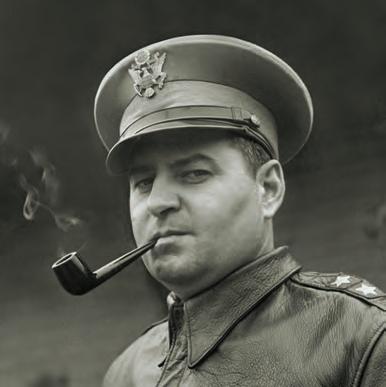
H H H HISTORYNET.COM TURNING THE TABLES ON GERMANY’S U-BOATS TH E DAY THE ENGLISH CHANNEL CAUGHT FIRE AM ERICA’S FORGOTTEN POW MASSACRE Plus FIRESTORM “If we lose,” LeMay confided in an aide, “we’ll be tried as war criminals.” GENERAL CURTIS LEMAY’S BRUTAL BOMBING STRATEGY SET JAPAN ABLAZE WINTER 2023 WW2P-230100-COVER-DIGITAL.indd 1 9/29/22 6:37 AM
Every once in a while a timepiece comes along that’s so incredibly good looking, masterfully equipped and jaw-droppingly priced, that it stops us stone cold. A watch that can take you seamlessly from the 18th hole to the board room. A watch that blurs the line betweens sports watch and dress watch. We’re talking the Blue Stone Chronograph, and it sits at the top of the discerning gentleman’s watch list.
Striking in appearance and fully equipped with features, this is a watch of substance. The Blue Stone merges the durability of steel with the precision of crystal movement that’s accurate to 0.2 seconds a day. Both an analog and digital watch, the Blue Stone keeps time with pinpoint accuracy in two time zones.
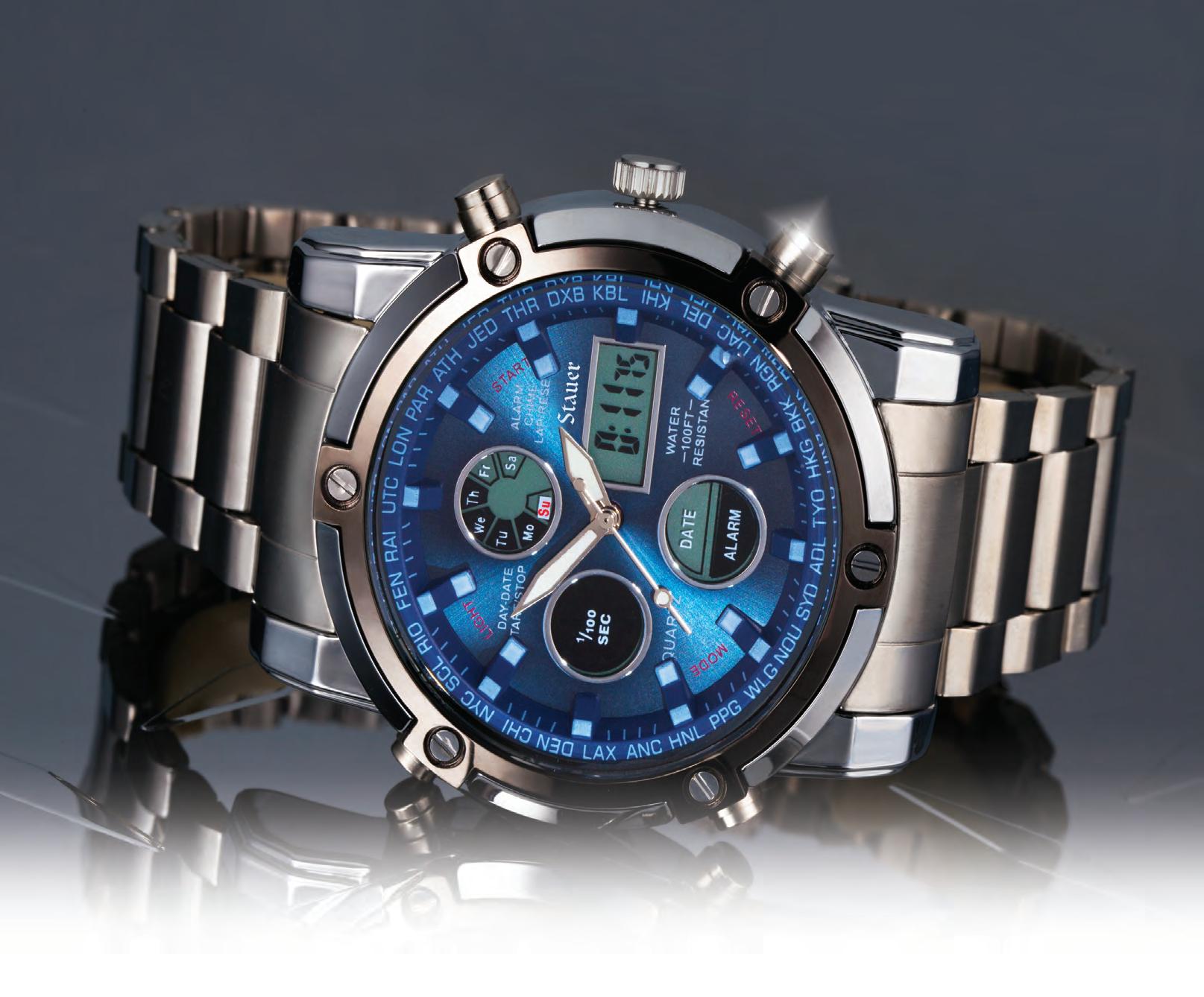
The watch’s handsome steel blue dial seamlessly blends an analog watch face with a stylish digital display. It’s a stopwatch, calendar, and alarm. Plus, the Blue Stone resists water up to 30 meters, making it up for water adventures.
A watch with these features would easily cost you thousands if you shopped big names. But overcharging to justify an inflated brand name makes us blue in the face. Which is why we make superior looking and performing timepieces priced to please. Decades of experience in engineering enables Stauer to put quality on your wrist and keep your money in your pocket.
satisfaction is 100% guaranteed. Experience the Blue Stone


If you’re not convinced you got excellence for less, send it back for a refund of the item price.
is running out. Originally priced at $395, the Blue

• Precision movement • Digital and analog timekeeping • LED subdials • Stainless steel crown, caseback & bracelet • Dual time zone feature • Stopwatch • Alarm feature • Calendar: month, day, & date • Water resistant to 3 ATM • Fits wrists 7" to 9" St auer… Affo rd the Extraord ina ry.™ “Blue face watches are on the discerning gentleman’s ‘watch list’.” –watchtime.com
Your
Chronograph for 30 days.
Time
Stone Chronograph was already generating buzz among watch connoisseurs, but with the price slashed to $69, we can’t guarantee this limited-edition timepiece will last. So, call today! 14101 Southcross Drive W., Ste 155, Dept. BSW396-01 Burnsville, Minnesota 55337 www.stauer.com Stauer Blue Stone Chronograph non-offer code price $395† Offer Code Price $69 + S&P Save $326 You must use the offer code to get our special price. 1-800-333-2045 Your Offer Code: BSW396-01 Please use this code when you order to receive your discount. Rating of A+ Stauer ® † Special price only for customers using the offer code versus the price on Stauer.com without your offer code. TAKE 83% OFF INSTANTLY! When you use your OFFER CODE “The quality of their watches is equal to many that can go for ten times the price or more.” — Jeff from McKinney, TX Stone Cold Fox So good-looking...heads will turn. So unbelievably-priced...jaws will drop. WW2-221108-010 Stauer Blue Stone Watch.indd 1 10/1/22 1:32 PM

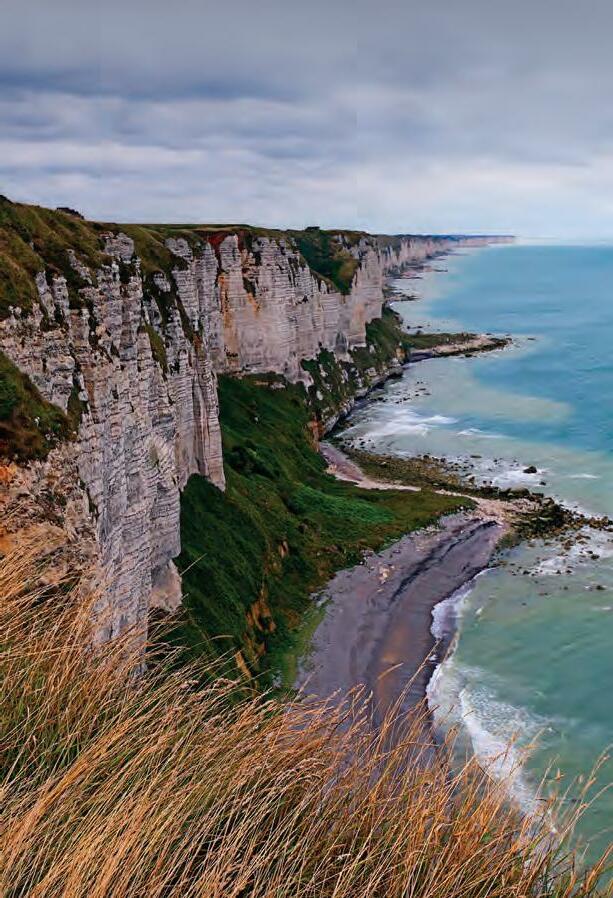
D-DAY TO THE RHINE : A TOUR YOU WON’T FORGET STEPHEN AMBROSE HISTORICAL TOURS PRESENTS Travel with us June 1-13, July 21-August 2, or September 1-13, 2023 Follow along the path where America’s best and brightest fought in WWII as you travel from England to Normandy to the Ardennes on our D-Day to the Rhine Tour. Pay homage to the fallen in Europe and the Pacific on our Operation Overlord, Original Band of Brothers, Iwo Jima, Battle of Britain, Battle of the Bulge, Ghost Army, In Patton’s Footsteps, Italian Campaign, Manhattan Project, Normandy Campaign and Poland and Germany tours. Our WWII, Civil War and American History tours are unrivaled in their historical accuracy! EXPLORE NOW AT STEPHENAMBROSETOURS.COM 1.888.903.3329 The best way to understand history is to study the places it was made. DR. STEPHEN AMBROSE WW2-221108-005 Stephen Ambrose.indd 1 10/1/22 1:40 PM



16 56 WW2P-230100-CONTENTS.indd 2 9/30/22 5:00 PM




WINTER 2023 3 WINTER 2023 ENDORSED BY THE NATIONAL WORLD WAR II MUSEUM, INC. 12 FEATURES COVER STORY 30 NIGHT TERRORS General Curtis LeMay’s brutal but effective firebombing of Japan changed the course of the war JAMES M. SCOTT 38 BRAIN POWER Decrypted messages and razor-sharp wits helped British and American intel teams win the Battle of the Atlantic DAVID SEARS WEAPONS MANUAL 46 DUCK AND COVER America’s DUKW amphibious truck 48 THE DAY THE SEA CAUGHT FIRE The British relied on flame-based weapons—and a “Big Lie”— to deter a German invasion STEVEN TRENT SMITH PORTFOLIO 56 ON PINS AND NEEDLES A Holocaust survivor recalled the war’s dark days in Poland— a story she told via fabric and thread 62 GOLDEN GIRL Wealthy socialite Mary Jayne Gold bucked first impressions and saved desperate refugees in Vichy France GAVIN MORTIMER DEPARTMENTS 8 MAIL 10 WORLD WAR II TODAY 18 CONVERSATION He survived a deadly kamikaze attack on the USS Bunker Hill 22 FROM THE FOOTLOCKER 24 NEED TO KNOW 26 TRAVEL Memories linger of a G.I.’s massacre of German POWs in Utah 70 REVIEWS The Mosquito Bowl; Ken Burns’s latest; Team America; and more 76 BATTLE FILMS The Third Man delivers an uncomfortable message 79 CHALLENGE 80 FAMILIAR FACE 18 The USS Bunker Hill burns after a kamikaze attack on May 11, 1945, at the Battle of Okinawa. NAVAL HISTORY AND HERITAGE COMMAND COVER: INCENDIARY BOMBS HIT OSAKA, JAPAN, ON JUNE 1, 1945; NATIONAL ARCHIVES 22 WW2P-230100-CONTENTS.indd 3 9/30/22 5:01 PM
Larry

Kirstin
T.
Brian Walker
A.




Dana B.
Y.
John C.

DESIGN

HERITAGE AUCTIONS
Porges SENIOR EDITOR
Fawcett ASSOCIATE EDITOR Jerry Morelock, Jon Guttman HISTORIANS David
Zabecki CHIEF MILITARY HISTORIAN Paul Wiseman NEWS EDITOR
GROUP
DIRECTOR Melissa
Winn DIRECTOR OF PHOTOGRAPHY Guy Aceto PHOTO EDITOR
Shoaf MANAGING EDITOR, PRINT Michael
Park MANAGING EDITOR, DIGITAL Claire Barrett NEWS AND SOCIAL EDITOR ADVISORY BOARD Ed Drea, David Glantz, Keith Huxen,
McManus, Williamson Murray CORPORATE Kelly Facer SVP REVENUE OPERATIONS Matt Gross VP DIGITAL INITIATIVES Rob Wilkins DIRECTOR OF PARTNERSHIP MARKETING Jamie Elliott PRODUCTION DIRECTOR ADVERTISING Morton Greenberg SVP ADVERTISING SALES MGreenberg@mco.com Terry Jenkins REGIONAL SALES MANAGER TJenkins@historynet.com DIRECT RESPONSE ADVERTISING Nancy Forman / MEDIA PEOPLE nforman@mediapeople.com © 2022 HistoryNet, LLC Subscription Information 800-435-0715 or shop.historynet.com LIST RENTAL INQUIRIES: Belkys Reyes, Lake Group Media, Inc. / 914-925-2406 / belkys.reyes@lakegroupmedia.com World War II (ISSN 0898-4204) is published quarterly by HistoryNet, LLC, 901 N. Glebe Road, 5th Floor, Arlington, VA 22203 Periodical postage paid at Vienna, VA and additional mailing offices. Postmaster: send address changes to World War II, P.O. Box 900, Lincolnshire, IL 60069-0900 Canada Publications Mail Agreement No. 41342519 Canadian GST No. 821371408RT0001 The contents of this magazine may not be reproduced in whole or in part without the written consent of HistoryNet, LLC. PROUDLY MADE IN THE USA VOL. 37, NO. 3 WINTER 2023
Michael A. Reinstein CHAIRMAN & PUBLISHER
Sign up for our FREE weekly e-newsletter at: historynet.com/newsletters HISTORYNET VISIT HISTORYNET.COM PLUS! Today in History What happened today, yesterday— or any day you care to search. Daily Quiz Test your historical acumen—every day! What If? Consider the fallout of historical events had they gone the ‘other’ way. Weapons & Gear The gadgetry of war—new and old— effective, and not-so effective. If poetic license isn’t something you’re looking for in movies about World War II, here are some top films that tell it like it was. By Mark DePue historynet.com/accurate-ww2-movies
The
Dam Busters, 1955 10 Accurate WWII Battle Films TRENDING NOW WW2P-230100-MASTOLINE.indd 4 10/5/22 3:52 PM
Notonly are these hefty bars one full Troy ounce of real, .999 precious silver, they’re also beautiful, featuring the crisp image of a Morgan Silver Dollar struck onto the surface. That collectible image adds interest and makes these Silver Bars even more desirable. Minted in the U.S.A. from shimmering American silver, these one-ounce 99.9% fine silver bars are a great alternative to one-ounce silver coins or rounds. Plus, they offer great savings compared to other bullion options like one-ounce sovereign silver coins. Take advantage of our special offer for new customers only and save $5.00 off our regular prices.




Morgan Silver Dollars Are Among the Most Iconic Coins in U.S. History



What makes them iconic? The Morgan Silver Dollar is the legendary coin that built the Wild West. It exemplifies the American spirit like few other coins, and was created using silver mined from the famous Comstock Lode in Nevada. In fact, when travelers approached the mountains around the boomtown of Virginia City, Nevada in the 1850s, they were startled to see the hills shining in the sunlight like a mirror. A mirage caused by weary eyes?
No, rather the effect came from tiny flecks of silver glinting in the sun.




A Special Way for You to Stock Up on Precious Silver
While no one can predict the future value of silver in an uncertain economy, many Americans are rushing to get their hands on as much silver as possible, putting it away for themselves and their loved ones. You’ll enjoy owning these Silver Bars. They’re tangible. They feel good when you hold them, You’ll relish the design and thinking about all it represents. These Morgan Design One-Ounce Bars make appreciated gifts for birthdays, anniversaries and graduations, creating a legacy sure to be cherished for a lifetime.

Order More and SAVE

You can save $5.00 off our regular price
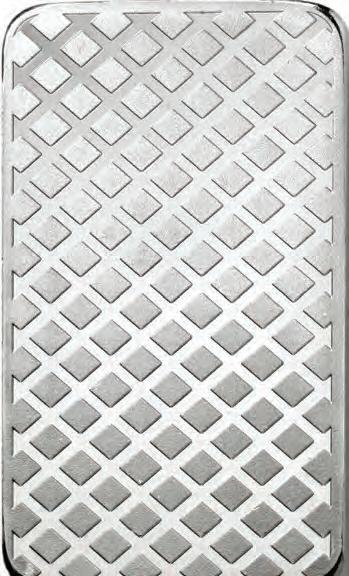

buy now. There is a limit of 25 Bars per customer, which means with






GovMint.com • 1300 Corporate Center Curve, Dept. MSB184-01, Eagan, MN 55121
when you
this special offer, you can save up to $125. Hurry. Secure Yours Now! Call right now to secure your .999 fine silver Morgan Design One-Ounce Silver Bars. You’ll be glad you did. One-Ounce Silver Morgan Design Bar $49.95 ea. Special o er - $44.95 ea. +s/h SAVE $5 - $125 Limit of 25 bars per customer Free Morgan Silver Dollar with every order over $499 (A $59.95 value!) FREE SHIPPING over $149! Limited time only. Product total over $149 before taxes (if any). Standard domestic shipping only. Not valid on previous purchases. For fastest service call today toll-free 1-888-201-7144 Offer Code MSB184-01 Please mention this code when you call. SPECIAL CALL-IN ONLY OFFER Fill Your Vault with Morgan Silver Bars GovMint.com® is a retail distributor of coin and currency issues and is not a liated with the U.S. government. e collectible coin market is unregulated, highly speculative and involves risk. GovMint.com reserves the right to decline to consummate any sale, within its discretion, including due to pricing errors. Prices, facts, gures and populations deemed accurate as of the date of publication but may change signi cantly over time. All purchases are expressly conditioned upon your acceptance of GovMint.com’s Terms and Conditions (www.govmint. com/terms-conditions or call 1-800-721-0320); to decline, return your purchase pursuant to GovMint.com’s Return Policy. © 2022 GovMint.com. All rights reserved. Actual size is 30.6 x 50.4 mm 99.9% Fine Silver Bars Grab Your Piece of America’s Silver Legacy BUY MORE SAVE MORE! BUY MORE SAVE MORE! BUY MORE SAVE MORE! A+ WW2-221108-014 GovMint Morgan Silver Bars.indd 1 10/1/22 1:33 PM
MORTIMER
CONTRIBUTORS
JAMES M. SCOTT (“Night Terrors”) is a former Nieman Fellow at Harvard University, and the author most recently of Black Snow: Curtis LeMay, the Fire bombing of Tokyo, and the Road to the Atomic Bomb, from which our cover article is adapted. His previous books include 2018’s Rampage, which was named one of the best books of the year by editors at Amazon, Kirkus, and Military Times; and Target Tokyo, a 2016 Pulitzer Prize finalist in history. Other works include The War Below (2013) and The Attack on the Liberty (2009), which won the Rear Admiral Samuel Eliot Morison Award for Excellence in Naval Literature. He lives in Charleston, South Carolina, with his wife and two children.
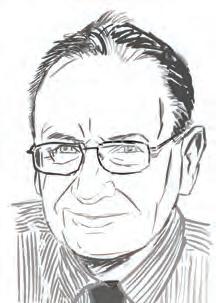

JESSICA WAMBACH BROWN (“A Tragic Night in Utah”) travels across the nation from her home base in northwest Montana to write about the unusual wartime histories of home-front communities. Searching for an excuse to cycle in southern Utah, she happened upon this issue’s “Travel” destination, the city of Salina, where a rogue guard opened fire on a camp of sleeping German prisoners two months after the war in Europe’s end.

GAVIN MORTIMER (“Golden Girl”), a British writer who lives in Paris, is the author of more than 25 books. While researching the history of the British Army’s elite Special Air Service Regiment, he learned of SAS member and gangster Raymond Couraud; his girl friend, the enigmatic American heiress Mary Jayne Gold; and their wartime adventures in Vichy France.


DAVID SEARS (“Brain Power”) is a New Jersey-based military history writer and frequent World War II contributor. His latest book, Duel in the Deep, about a U.S. Navy destroyer in the Battle of the Atlantic, is slated for publication in August 2023; for this issue he remained on theme, writing about the British and American intelligence teams whose combined efforts helped vanquish the Kriegsmarine.
STEVEN TRENT SMITH (“The Day the Sea Caught Fire”) is a five-time Emmy Award-winning TV photo journalist. He became inspired to learn more about Britain’s fire-based weapons after watching the BBC documentary series Coast, which looked at the devel opment of World War II’s flame barrage system. Smith is the author of two books, The Rescue (2001) and Wolf Pack (2003), both about the submarine war in the Pacific. He lives in northwest Montana, in the shadow of the Rocky Mountains.
WORLD WAR II6 PORTRAITS BY JOHANNA GOODMAN
SEARS
COVER STORY SCOTT
BROWN
SMITH
WW2P-230100-CONTRIB.indd 6 9/30/22 5:06 PM

































































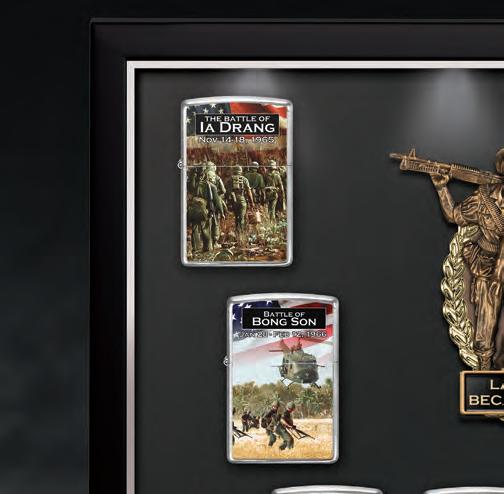










B_I_V = Live Area: 7 x 9.75, 1 Page, Installment, Vertical Price Logo Address Code Tracking Code Yellow Snipe Shipping Service Greatest Battles of Vietnam Zippo® Lighter Collection Salute the exemplary men and women who served and sacrificed in Vietnam with the Greatest Battles of Vietnam Zippo® Lighter Collection. Gleaming with the Zippo Chrome finish, these genuine Zippo® windproof lighters feature different iconic images recalling critical battles in the Vietnam conflict. The collection includes a lighted display crowned with a sculptural centerpiece inspired by “The Three Servicemen” Vietnam memorial statue in Washington, D.C. A $100 value, the custom display is yours for the price of asingle lighter. Commemorating Heroism in the Foxholes ,“ZIPPO”, , and are registered trademarks in the United lighter decorations are protected by copyright. © 2022 Zippo® Manufacturing Company Actual size 13" wide x 9¾" high. Display your collection on a tabletop or wall. Mounting hardware included. Display made in China. Lighters ship unfilled; lighter fluid not included. single ORDER TODAY AT BRADFORDEXCHANGE.COM/922998 ©2022 BGE 01-34538-001-BDR Distinctive bottom stamp authenticates this collectible as a genuine Zippo® windproof lighter Premiere Edition “The Battle of Khe Sanh” begins the Greatest Battles of Vietnam Zippo® Lighter Collection and you can order it now at $49.99 per edition, payable in two installments of $24.99 (plus a total of $10.99 shipping and service each, including the $100-value display*). Send no money now. Three Servicemen statue @ 1984 F. Hart and VVMF STRICTLY LIMITED TO 5,000 COMPLETE COLLECTIONS! Risk-Free Subscription Plan. This is the convenient, risk free auto-renewal plan. You will be charged with each future shipment, about once a month, at the same low price stated above. This continues until you cancel or the collection is complete. You are under no obligation and may cancel at any time. You may also return any item free of charge for a full refund. *See bradfordexchange.com. Display will be shipped after second lighter. Limitededition presentation restricted to 5,000 complete collections. Please allow 4-6 weeks for delivery of Edition One. Sales subject to product availability and order acceptance. YES. Please accept my order for the Greatest Battles of Vietnam Zippo® Lighter Collection as described. I need send no money now. I will be billed with shipment. By sending this form, I accept the Risk Free Subscription Plan stated at left. Where Passion Becomes Art PLEASE RESPOND PROMPTLY SEND NO MONEY NOW The Bradford Exchange 9345 Milwaukee Ave., Niles, IL 60714-1393 Mrs. Mr. Ms. Name (Please Print Clearly) Address City State Zip Email (optional) 922998-E57391 WW2-221108-009 Bradford Vietnam Zipo Lighter CLIPPABLE.indd 1 10/1/22 12:50 PM
I READ WITH PRIDE the Autumn 2022 article “4,415 Souls and Counting” by John D. Long describing the National D-Day Memori al’s efforts to calculate how many died in the invasion. From 2012 to 2014 I served as the commander of Air Force Mortuary Affairs Oper ations at Dover Air Force Base, providing dignity, honor, and respect to our nation’s combat-fallen. In addition to supporting our nation’s present-day fallen, our operation was charged with reuniting fallen Americans from previous conflicts—from World War II to Korea to Vietnam—with their families. My time at Dover was, and remains, special to me, and we as a nation should be proud of the work being done by the National D-Day Memorial as well as the ongoing efforts to identify and reunite our nation’s fallen with their families led by the Department of Defense and our individual services.
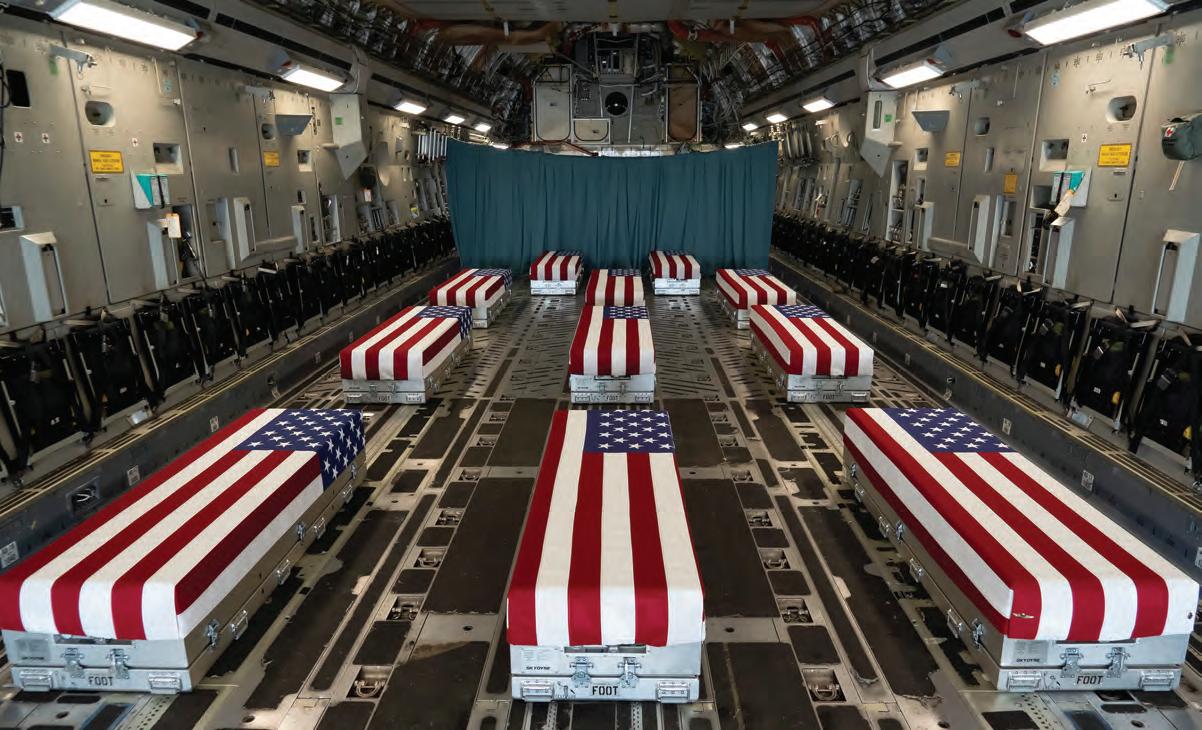 John Devillier
John Devillier
Dayton, Ohio
FAREWELL SALUTES
Now approaching 80, I have been a serious student of World War II since the third grade. (My dad served as a staff sergeant in the 1478th Engineer Maintenance Company. We were blessed to get him back healthy and whole in 1946.) It’s a very rare occasion that I write any message to an editor, but I felt the need to reach out to Karen Jensen, who served as World War II ’s editor in chief for more than a decade and announced her retirement in the August issue. I wanted to extend my thanks for a job well done, by you and your staff, and for all your efforts in producing a superb magazine. Please let me wish you good health and happiness in your years to come, and continued success in whatever you choose to do.
Thomas S. Griffin Jr.
Darien, Conn.
AS A LONGTIME print subscriber, I wanted to tell you I appreciate HistoryNet’s recently revamped webpage, historynet.com. Thank you for the upgrade—and best wishes to Karen Jensen as she leaves her work. Much obliged for the years of great reading you provided your loyal readers, Karen.
Richard Dinges
Oregon City, Ore.
PAINFUL PROGRESS
When I read Sergeant Lafayette “War Daddy” Pool’s story (“Always Forward”) i n the Autumn 2022 issue and learned that he had had his right leg amputated. I was reminded of Ted Lawson’s loss of his left leg in China, as chronicled in his 1943 book about the Doolit tle Raid, T hirty Seconds Over Tokyo. I own sev eral editions, including the latest published in 2002 by his wife, Ellen. In it Lawson writes that the Medical Corps had ruled, after study ing his case, that there needed to be proce dural changes in leg amputations to allow the amputee’s leg stump to better adapt to a pros thesis. This deficiency was especially pro nounced in Lawson’s case because Lieutenant Dr. Thomas Robert White, who went along on the Doolittle Raid as a crewman in one of the B-25s, with the assistance of the Chinese doc tors, had had little time to accomplish the
WORLD WAR II8 U.S. AIR FORCE/JASON MINTO HISTORYNET ARCHIVES (BOTH)
MAIL
Swathed in flags, transfer cases containing combat-fallen servicemembers await transfer at Dover Air Force Base.
NUMBERING THE STARS WW2P-230100-MAIL.indd 8 10/3/22 7:17 PM
amputation as they were fleeing the Japanese.
I will bet that Sergeant Pool, and perhaps many others, benefited from Lawson’s sur gery and rehabilitation trials. Perhaps some one can shed more light on this small part of history where one man’s travails directly ben efited those who came after him.
 Paul Butterworth
Paul Butterworth
Newnan, Ga.
CRACKING A MYSTERY?
I enjoyed Jessica Wambach Brown’s Autumn 2022 “Travel” article, “Bombers in the Big Sky,” on Montana’s Cut Bank Army Airfield. I may have discovered the reason for its unex plained closure in October 1943. According to Richard E. Osborne’s 1996 book World War II Sites in the United States: A Tour Guide and Directory, the airport “had a serious problem in that the runways began to deteriorate soon after construction,” as their concrete, poured during the winter, cracked amid the spring thaw. The runways were later mended, and Cut Bank Army Airfield was used as a transit base for fighters and light bombers (instead of heavy B-17s) until the war’s end, after which the site became a regional airport.
Ralph Larson
San Antonio, Tex.
HELPING HANDS
I would like to thank World War II for being one of the first national-level publications to
cover Stories Behind the Stars, the non profit initiative to collect the stories of all of America’s 421,000 World War II fallen into one common database accessible via smartphone app at any gravesite or memo rial. “World War II Today” reporter Paul Wiseman’s article on our organization in the December 2020 issue and his followup piece in December 2021 helped us attract many volunteers.
We have completed 20,000 stories, but we still have 401,000 to go. You can read any of them at fold3.com/partner/storiesbehind-the-stars.
Don Milne Louisville, Ky.
FULL CIRCLE
I am the son of G. W. Benedict, the Pacific navy officer whose wartime-era ID bracelet was discovered decades ago in Europe by infantryman Paul Balkin; his son-in-law, Henry Kliman, submitted a photo to your publication’s October 2021 “From the Footlocker” column hoping to learn more about its owner.
It is with great humility a nd gratitude that I say thanks to three very special people who ultimately helped return the bracelet to me: Kliman, who wrote to World War II knowing he had something special; editor Karen Jensen, for continuing to ask questions; and finally, writer Paul Wiseman, for assimilat ing these details into a tale of human kindness. I appreciate your efforts to tell the stories of the men and women who served their country and protected democracy for all.
Bene “Lynn” Benedict Alto, Mich.
GIVING THANKS TO THE NEW BREED
I’m a retired pharmacist who was once a grunt with Patton. It was an absolute pleasure to read Henry Sledge’s Autumn 2022 article, “When Things Get Tough,” on his father Eugene Sledge’s seminal 1981 book, With the Old Breed. I own over a hundred books on World War II and have read them all. Henry, your dad’s book is at the very top of the list.

Ronald P. Gros Metairie, La.
FROM THE EDITOR
I’m writing this on the morning of the funeral of Queen Elizabeth II, the princess who served as a military driver and auto mechanic during World War II…before going on to rule Britannia for seven decades.
Elizabeth’s service reminded me of the many types of people, from all walks of life, it took to win the war. In this issue we feature several: Curtis LeMay, the steel-mill work ing son of an itinerant father who went on to lead the brutal but effective bombing campaign of Japan; Mary Jayne Gold, a wealthy socialite who could have fled wartime France but instead stayed behind to aid desperate refugees; and two intelligence offi cers with serious medical issues, one in England and one in the United States, who utilized brain power over physical strength to defeat the Kriegsmarine in the Atlantic.
It takes all types. Luckily, all types answered the call.
—Larry Porges

PLEASE SEND
Please include your name, address, and daytime telephone number.
@WorldWarIImag
WINTER 2023 9 U.S. AIR FORCE/JASON MINTO HISTORYNET ARCHIVES (BOTH)
LETTERS TO: worldwar2@historynet.com
Ted Lawson
WW2P-230100-MAIL.indd 9 10/5/22 3:35 PM
The 124,000 women who entered the U.S. Cadet Nurse Corps addressed a critical wartime nursing shortage. Several in Congress are trying to belatedly

work.
THEY SIGNED UP IN DROVES because a nation at war was desperate for nurses. In 1943, Congress created the U.S. Cadet Nurse Corps, promising young women a free education and a career in nursing. Two years later, they were providing 80 percent of the nursing care in American hospitals. But after the war the corps was disbanded, and the women’s contributions were largely forgotten.
“I was a nurse for 50 years, and I just found out about them in 2018,” said Barbara Poremba, professor emeritus of nursing at Salem State University in Massachusetts. “I was pretty shocked.” She was also outraged: the cadets

GENE LESTER/GETTY IMAGES; INSET: JOHN PARROT/STOCKTREK IMAGES/GETTY IMAGES COURTESY OF JEFFREY REASE WORLD WAR II10
recognize their
WWII TODAY REPORTED AND WRITTEN BY PAUL WISEMAN
PUSH APACE TO RECOGNIZE WARTIME NURSES WW2P-230100-TODAY-2.indd 10 9/30/22 5:04 PM
received no postwar benefits and couldn’t even call themselves veterans. She formed a group, Friends of the U.S. Cadet Nurse Corps WWII 1943-1948, and started a push—backed by Representative Cheri Bustos (D-Ill.), Senator Elizabeth Warren (D-Mass.), and other lawmakers—to pass legislation giving the Cadets honorary vet eran status. The honor wouldn’t come with any retirement or medical perks. “They don’t want benefits,” Poremba said. “They just want recognition.”
The United States had a nursing shortage even before it joined the war. Then veteran nurses were sent to Europe and the Pacific, and hospitals on the home front scrambled for help. The government tried advertising campaigns—“They were trying to grab them before they became Rosie the Riv eter,” Poremba said—and even considered drafting nurses.
Finally, it settled for the nursing corps, which took women as young as 17: 179,000 enrolled, and 124,000 graduated from nursing training programs for domestic service. They signed up for the duration of the war and wore military-style uniforms— two sets: summer and winter—but had to provide their own mandatory white hosiery and shoes. They earned from $15 to $30 a month and received room and board.
The corps was pathbreaking: it was the first uniformed service to be integrated, accepting Black and Native American women, and even Japanese American women from wartime internment camps. It led to the standardization of nurse train ing, and its veterans formed the core of American nursing after the war. “The cadet nurses are really pioneers of modern nurs ing. They changed everything,” Poremba said, adding that during the war, “they were credited with preventing a total collapse of the hospital system.”
Still, the legislation to grant them honor ary veteran status—which would cost the government virtually nothing—has stalled in a divided Congress. Twice it was inserted into and then stripped out of massive defense spending bills. Poremba says time is running out, as the surviving cadets are in their nineties or older. She noted, “We thought it was a slam dunk like, duh: why would you deny some great-grandmothers their final wishes?”
KEEPING WWII MEMORIES ALIVE
ARMY RANGERS DESTROYED German gun emplacements at Omaha Beach on D-Day and freed hundreds of Allied prison ers from a Japanese POW camp in the Philippines. In all, 7,000 Americans served as Rangers during World War II. Only 12 survive, President Joe Biden noted on June 7, 2022, as he joined Congress in honoring the elite force with the Congressional Gold Medal.
Three weeks later, the last surviving Medal of Honor recipi ent from World War II—Hershel “Woody” Williams, who braved machine gun fire to attack Japanese pillboxes on Iwo Jima with a flamethrower—died at a veterans’ hospital in West Virginia at age 98. His remains lay in honor at the U.S. Capitol on July 14.
These separate news items provided a stark reminder that the World War II generation is vanishing. Even the youngest wartime vets are now in their nineties. The National WW2 Museum in New Orleans says that only 240,000 of 16 million veterans of the war were still alive as of September 2021 and that 234 are dying daily. “Every day,” the museum notes on its website, “memories of World War II—its sights and sounds, its terrors and triumphs—disappear.”
Volunteers are working hard to make sure the veterans are not forgotten. As a ponytailed California teenager, Rishi Sharma, the son of immigrants from India, embarked on a cam paign to record interviews with combat veterans of the war (“World War II Today,” April 2017). Now, more than five years later, his “Remember WWII” nonprofit (rememberww2.org) has completed 1,500 interviews.
Meanwhile, Birmingham, Alabama, photographer Jeffrey Rease has made it his mission to snap portraits of as many wartime vets as possible (“World War II Today,” February 2021). His project received a boost when NBC News broadcast a feature on his efforts in August 2022, bringing in donations for travel and tips on veterans to photograph. By early September, he’d taken 292 portraits. He’s hoping to hit the road to shoot more, perhaps focusing on Midwestern states like Ohio, Illinois, and Minnesota. You can see his work and make donations at portraitsofhonor.us.
Rease knows the clock is ticking. “I won’t be able to get them all,” he told World War II. “Some will pass away. So, yeah, it’s urgent.”

GENE LESTER/GETTY IMAGES; INSET: JOHN PARROT/STOCKTREK IMAGES/GETTY IMAGES COURTESY OF JEFFREY REASE
World War II veteran Alvin Lopez sits for a portrait with photographer Jeffrey Rease.
WINTER 2023 11 WW2P-230100-TODAY-2.indd 11 9/30/22 5:04 PM
NEW CAMPUS IN WORKS FOR NORMANDY INSTITUTE
THE DESERT FOX walked its steps. German officers prepared their defense of the Normandy coast in its hallways. Paratroopers from the 82nd Airborne fought on the terrain nearby, not far from D-Day’s Utah Beach.
Now the nonprofit Normandy Institute wants to convert the Cha teau de Bernaville and its 50 surrounding acres into a nonprofit campus and conference center, where students, scholars, policy makers, and military leaders can come to bask in the French coun tryside and consider the bloody history that unfolded there and ways to prevent a recurrence.

The institute, incorporated in 2016, is raising money (normandy institute.org/support-us) for a planned $25-million makeover of the property, including the construction of a 60-room residence hall. Much of the work will involve restoring the chateau into an 11-room guesthouse, putting 30 guest rooms in the estate’s carriage house, and transforming the conservatory into a dining room and conference hall that can hold 350. A small chapel is also available for weddings and other gatherings.
Dorothea de La Houssaye, chair of the institute, says the location is perfect for conferences and educational retreats—beautiful coun tryside with a deep history. But the surrounding area is bereft of significant hotel capacity. So the Normandy Institute hopes to fill
Chateau de Bernaville (left), the former headquarters of German field marshal Erwin Rommel (center, above), is slated to become the new home of the nonprofit Normandy Institute.
the gap and attract conference goers from, say, NATO headquarters in Brussels, 360 miles to the north, to discuss military strategy and diplomacy. “We want to leave something behind that future generations can forever use and enjoy,” she said.
Occupying German forces used the chateau as a headquarters as they braced for the Allied invasion that would come on June 6, 1944; there’s a photograph of German general Erwin Rommel, the Desert Fox, descending the steps of the chateau three weeks before D-Day. (Rommel wasn’t around when the fighting started, having returned to Germany for his wife’s birthday.)

The Normandy Institute has long pursued D-Day-related projects. It’s raising money for a documentary about retired U.S. Army Colo nel Keith Nightingale’s Normandy tours with D-Day veterans, and last year it released a short film about the 2005 reunion in Nor mandy, the Netherlands, and Belgium of the Band of Brothers—the men of Easy Company, 2nd Battalion of the 506th Parachute Infan try Regiment of the 101st Airborne Division, whose story was told in Stephen Ambrose’s 1992 book and HBO’s 2001 miniseries.
The Chateau de Bernaville is a three-hour drive from Paris and can be reached by train on the Paris-Cherbourg line.

WORLD WAR II12 BOTH: COURTESY OF THE NORMANDY INSTITUTE FROM TOP: GENE LESTER/GETTY IMAGES; AP PHOTO/DARKO VOJINOVIC
WW2P-230100-TODAY-2.indd 12 9/30/22 5:04 PM
DISPATCHES

Sinking water levels in the Danube River, the consequence of a devastating European drought, in August 2022 exposed the wreckage of more than a dozen German ships scuttled during World War II. Part of the Nazi regime’s Black Sea fleet, the ships were sunk by retreat ing German forces to keep them from falling into the hands of the advancing Soviets. The hulks contain almost 10,000 pieces of unexplod ed ordnance. As the Danube dropped, the ships emerged off the port of Prahovo in what is now Serbia. The cost of clearing the explosives and moving the ships to make way for river traffic could come to $30 million.

WINTER 2023 13 BOTH: COURTESY OF THE NORMANDY INSTITUTE FROM TOP: GENE LESTER/GETTY IMAGES; AP PHOTO/DARKO VOJINOVIC
No movie screen
was big enough to contain the combined
talents
of these
celebrities, who
in spring
1942 embarked
on
a
patriotic cross-country fundraising campaign dubbed the
Hollywood Victory
Caravan. Conceived
by the
U.S.
Treasury
Department, the star-studded railroad tour brought household names such as
Desi Arnaz (fourth from left), Claudette Colbert
(fourth from right), and
Frank McHugh
(far
right)
to over a dozen cities, where they hosted variety
shows
for $11 per ticket. Collectively, the performers raised $800,000—today, more than $14.5 million—for army and navy relief funds. ON THE HOME FRONT
WW2P-230100-TODAY-2.indd 13 10/5/22 7:42 PM
My late grandfather, Flight Officer Louis J. Cyr, served in the Pacific with the 27th Bombardment Squadron of the 30th Bombardment Group. He rarely spoke about the war, and I was wondering what you could tell me about his squadron’s service. We recently found some of his Army Air Forces papers that could provide some leads.

– Andrea Scott, Alexandria, Va.
Your grandfather’s unit, the 27th Bombardment Squadron (Heavy), was established in November 1940 as the U.S. began building up its military readiness after war had broken out in Europe. Activated on January 15, 1941, the squadron—part of the 30th Bombardment Group—was first stationed at California’s March Field, training with Douglas B-18 Bolo medium bombers.
In May 1941, the 27th moved to New Orleans, where for the rest of the year it flew Lockheed A -29 Hudsons in coastal reconnais sance missions over the Gulf of Mexico in search of enemy subma rines. Immediately after the Japanese attack on Pearl Harbor, the squadron returned to California, where it joined the rest of the 30th Bomb Group patrolling West Coast waters for threats while also training aircrews in other units. It served in this role for two years until October 1943, when the group moved to Mokuleia Army Airfield in Hawaii.
As the U.S. island-hopping campaign in the Pacific moved west, so did the 27th Bomb Squadron. In November 1943, the 30th Bomb Group—now flying B-24 Liberators—relocated from Hawaii to the Gilbert Islands. On December 23, B-24s from the 27th Squadron became the first U.S. heavy bombers to use the recently seized airfield on Tarawa, escorting reconnaissance aircraft in prepara
tion for further incursions in the Pacific.
The bloody battle for Saipan from June 15–July 15, 1944, was a critical American victory in this push toward Japan. The records you sent indicate your grandfather, Louis J. Cyr, joined the 27th Squadron at this time after rating as a navigator on July 3, 1944. In August 1944, the 27th, along with Flight Officer Cyr, moved with the rest of the 30th Bomb Group to Saipan’s hard-won East Field, from where it would operate for the rest of the war.
The Americans’ next target: Iwo Jima. From Saipan, the 27th predominantly targeted the Bonin Islands around Iwo Jima to keep the Japanese from being able to stage aircraft and fend off an invasion. Cyr flew seven mis sions in late-model B-24Ms from January 24 to February 20, 1945—including five longrange bomb strikes to soften resistance on Iwo Jima itself—all carried out to support the Marine landings on the island on February 19. T he 27th continued to bomb Japanese bases in the Marianas and the Caroline Islands until March 1945, when the 30th Bom bardment Group returned to Hawaii. The squadron flew standard patrols and continued training new crews until the 30th was inacti vated on June 25, 1946.

Do you have a relative from a World War II company, squadron, or division you’d like to hear more about?
Contact us at worldwar2@historynet.com with the following: —Your relative’s full name, date of birth, and the specific unit in which he or she served —A high-resolution wartime-era photograph —Copies of any paperwork that may help us determine the particulars of your relative’s service.
Note that we are unable to conduct independent genealogical research.

WORLD WAR II14 LEFT: NATIONAL ARCHIVES; RIGHT: COURTESY OF ANDREA SCOTT
American B-24s bomb Iwo Jima in preparation for the February 19, 1945, invasion. Flight Officer Louis J. Cyr (right), of the 27th Bombardment Squadron, flew in five missions over the island.
MY PARENTS’ WAR WW2P-230100-TODAY-2.indd 14 9/30/22 5:05 PM
Secrets of a Billionaire Revealed

We’re going to let you in on a secret. Billionaires have billions because they know value is not increased by an in ated price.


avoid big name markups, and aren’t swayed by ashy advertising. When you look on their wrist you’ll nd a classic timepiece, not a cry for attention–– because they know true value comes from keeping more money in their pocket.
We agree with this thinking wholeheartedly. And, so do our two-and-a-half million clients. It’s time you got in on the secret too. e Jet-Setter Chronograph can go up against the best chronographs in the market, deliver more accuracy and style than the “luxury” brands, and all for far, far less. $1,150 is what the Jet-Setter Chronograph would cost you with nothing more than a di erent name on the face.

With over two million timepieces sold (and counting), we know a thing or two about creating watches people love. e Jet-Setter Chronograph gives you what you need to master time and keeps the super uous stu out of the equation. A classic in the looks department and a stainless steel power tool of construction, this is all the watch you need. And, then some. Your satisfaction is 100% guaranteed. Experience the Jet-Setter Chronograph for 30 days. If you’re not convinced you got excellence for less, send it back for a refund of the item price.
Time is running out. Now that the secret’s out, we can’t guarantee this $29 chronograph will stick around long. Don’t overpay to be underwhelmed. Put a precision chronograph on your wrist for just $29 and laugh all the way to the bank. Call today!

Absolute best price for a fully-loaded chronograph with precision accuracy... ONLY $29! Absolute best price for a fully-loaded chronograph with precision accuracy... ONLY $29! • Precision crystal movement • Stainless steel case back & bracelet with deployment buckle • 24 hour military time • Chronograph minute & small second subdials; seconds hand • Water resistant to 3 ATM • Fits wrists 7" to 9" Stauer ® 14101 Southcross Drive W., Ste 155, Dept. JCW493-01, Burnsville, Minnesota 55337 www.stauer.com † Special price only for customers using the offer code versus the price on Stauer.com without your offer code. Limited to the first 1900 responders to this ad only. “See a man with a functional chronograph watch on his wrist, and it communicates a spirit of precision.” — AskMen.com®
ey
CLIENTS LOVE STAUER WATCHES… êêêêê “The quality of their watches is equal to many that can go for ten times the price or more.” — Jeff from McKinney, TX Stauer…Afford the Extraordinary . ® You must use the offer code to get our special price. 1-800-333-2045 Your Offer Code: JCW493-01 Please use this code when you order to receive your discount. Rating of A+ Jet-Setter Chronograph $299† Offer Code Price $29 + S&P Save $270 TAKE 90% OFF INSTANTLY! When you use your OFFER CODE “Price is what you pay; value is what you get. Whether we’re talking about socks or stocks, I like buying quality merchandise when it is marked down.” — wisdom from the most successful investor of all time WW2-221108-013 Stauer Jetsetter Watch.indd 1 10/1/22 1:37 PM
En bloc clips for M1 Garands were sometimes valuable battlefield finds.
ASK WWII
Q: After big battles where huge amounts of ordnance were expended, did U.S. forces ever go back after the fighting was over to salvage ammunition clips left behind to be reloaded again for future use?

—Patrick J. Kirkland, Wylie, Texas
A: Several military historians looked into this question. Our primary source was the 1968 U.S. Army Center of Military History publication, The Ordnance Department: On Beachhead and Battlefront, by senior historian Lida Mayo. Several times Mayo references ordnance collecting companies that scanned the field after World War II battles to recover usable items. Most of the items recovered seem to have been spare parts or tanks that had been disabled by enemy fire. The companies were equipped with tractors and often operated at night.
T hat said, after the battle of El Guettar in April 1943, Mayo mentions that the 188th Ordnance Battalion stayed behind in Gafsa to assist in the “mammoth job of battlefield clearance. The Americans left behind them a 3,000-square-mile area that was littered with ammunition, tanks, gasoline and water cans, clothing, and all kinds of scrap. Out of the 20,544 long tons col lected, more than half was ammunition.”
While this is indeed evidence that ammunition was recov ered, we are unaware of any army policy, order, or salvage operation of any scope to recover the en bloc clips, preloaded with .30-06 caliber rounds, that were expended and ejected from M1 Garands during the war. Like brass cartridge casings, these inexpensive metal stampings were designed to be dis posable. There are some anecdotal stories where individual soldiers ran low on ammo for their Garands and, to alleviate their short supply, rounded up all the en bloc clips they could find and loaded them with scavenged .30-06 caliber ammo that was linked for machine guns—but those were more ad hoc efforts than official operations.
F. Lee Reynolds is a strategic communications officer at the U.S. Army Center of Military History
worldwar2@

WORD FOR WORD
DISPATCHES
The National Medal of Honor Museum memorializing the more than 3,500 recipients of the nation’s highest military award, including 473 from World War II—is scheduled to open in Arlington, Texas, in late 2024 after a ground breaking in March 2022. The museum will con tain 31,000 square feet of exhibition space and will include a restored Grumman F4F Wildcat, a World War II fighter flown by eight Medal of Honor recipients, in the naval aviation gallery.
WORLD WAR II16 SEND QUERIES VIA EMAIL to Ask World War II at
historynet.com
“Democracy is not dying. We know it because we have seen it revive—and grow. We know it cannot die, because it is built on the unhampered initiative of individual men and women joined together in a common enterprise— an enterprise undertaken and carried through by the free expression of a free majority.”
—President Franklin D. Roosevelt’s third inaugural address, delivered on January 20, 1941
LEFT: LAURENT STEMKENS; RIGHT: PHOTO12/UNIVERSAL IMAGES GROUP VIA GETTY IMAGES WW2P-230100-TODAY-2.indd 16 9/30/22 5:05 PM













Order by Dec. 6 and you’ll receive FREE gift announcement cards that you can send out in time for the holidays! LIMITED-TIME HOLIDAY OFFER CHOOSE ANY TWO SUBSCRIPTIONS FOR ONLY $29.95 TWO-FOR-ONE SPECIAL! CALL NOW! 1.800.435.0715 PLEASE MENTION CODE HOLIDAY WHEN ORDERING SCAN HERE! OR VISIT HISTORYNET.COM/HOLIDAY Offer valid through January 8, 2023 * For each MHQ subscription add $15 Vicksburg Chaos Former teacher tastes combat for the first time Elmer Ellsworth A fresh look at his shocking death Plus! Stalled at the Susquehanna Prelude to Gettysburg Gen. John Brown Gordon’s grand plans go up in flames Tulsa Race Riot: What Was Lost Colonel Sanders, One-Man Brand J. Edgar Hoover’s Vault to Fame The Zenger Trial and Free Speech Yosemite The twisted roots of a national treasure HISTORYNET.com JUL 2020 H H HISTORYNET.COM JUDGMENT COMES FOR THE BUTCHER OF BATAAN THE STAR BOXERS WHO FOUGHT A PROXY WAR BETWEEN AMERICA AND GERMANY PATTON’S EDGE THE MEN OF HIS 1ST RANGER BATTALION ENRAGED HIM UNTIL THEY SAVED THE DAY In 1775 the Continental Army needed weapons— and fast World War II’s Can-Do City Witness to the White War ARMS RACE THE QUARTERLY JOURNAL OF MILITARY HISTORY An ammunition dump explodes during the April 1972 battle for An Loc. Defeating Enemy Stereotypes White and Black POWs bonded as cellmates The Green Berets Battles that inspired the book and movie TERROR AT AN LOC 9TH CAVALRY’S HEROIC FIGHT TO RESCUE DOWNED AIRMEN Huey Haven Old Warbirds Are Getting a New Museum HOMEFRONT Sweet success for Sammy Davis Jr. JUNE 2022 HISTORYNET.COM HNET SUB AD_HOLIDAY-2022.indd 1 8/30/22 8:34 AM
CONVERSATION WITH EVERETT LANMAN
BY DAVE KINDY
NEVER SURRENDER,NEVER SINK
ON MAY 11, 1945, Everett “Red” Lanman of Plymouth, Massachusetts, was serving as an aviation mechanic on board the USS Bunker Hill when it was struck by two kamikazes during the Battle of Okinawa. He had been assigned to the Essex -class aircraft carrier shortly after it was launched on December 7, 1942—exactly one year after Pearl Harbor. Today, the 100-year-old is still going strong, just like the Bunker Hill ’s motto: “Never Surrender, Never Sink.” Lanman’s hair is no longer red, but the Bronze Starrecipient has a clear memory of the dramatic events of nearly 80 years ago.

Where did you first serve when you enlisted right after Pearl Harbor?
I was stationed in New York City at Pier 92, which was a receiving station. We were on guard duty there before ship ping out to the Pacific. One of my first duties was after the SS Normandie rolled over at Pier 88. It was being converted to a troopship in February 1942 when a fire broke out and it sank at dock. After that, we were assigned to the USS Bunker Hill.
One of your first stops on board the aircraft carrier was Pearl Harbor. What was that like?
When we pulled into port in October 1943, we saw the sunken ships on Battleship Row. I remember seeing the USS Utah overturned and the USS Arizona at the bottom of Pearl Harbor. It was pretty shocking, even close to two years later.
We tied up there for two days next to the Utah. Then we headed out into the Pacific and went to Rabaul on New Britain, which was a stronghold for the Japanese. Our task force made a raid on the naval base there. Later that afternoon, we were attacked by 114 Jap planes. They were sons of guns! We started firing and shot down a few of them. It was a tough battle. Then our Corsairs got into the action. Their guns were firing even as they were taking off! They were good pilots. A couple of them made ace in one day.
What other battles did you participate in?
We sailed to the Gilbert Islands for the invasion of Tarawa. We also took part in air raids at Kavieng, the Marshall Islands, Truk, and the Marianas, as well as Palau, Ulithi, and Hollandia, in support of landings on Saipan and Guam. The Bunker Hill also served at Leyte Gulf, Luzon, Formosa, Iwo Jima, and, of course, Okinawa. All in all,
the ship and crew received 11 battle stars and a Presidential Unit Citation.
One time we tied up to an island in the Solo mons, where we went ashore so we could work on the planes. There were no Japanese there. Well, they told us they didn’t want anybody wandering off into the jungle because there were big snakes in there. So I said, “You bet your ass I won’t!”
What was your job when the ship went to battle stations?
Mostly I was supposed to take cover, unless I was working on a plane. I would take cover up on the port side at a fire station, right near where they pumped out gasoline for the planes. There was a 40-millimeter gun
WORLD WAR II18 COURTESY OF EVERETT LANMAN DAVE KINDY
Everett “Red” Lanman in 1942, the year the aircraft mechanic joined the crew of USS Bunker Hill
WW2P-230100-CONVO-LANMAN-1.indd 18 10/3/22 2:55 PM
Lanman, at his home in Massachusetts, holds a fragment from one of the two kamikaze airplanes that struck Bunker Hill on May 11, 1945, during the Battle of Okinawa.

mount, and we passed ammunition to the guys who were firing. We did whatever we could to help, but when the bombs started to drop, we ducked.
What happened at Okinawa on May 11, 1945?
It’s hard to remember all of it. Things hap pened so fast that you don’t comprehend that much. We were working on a couple of planes on the hangar deck, right near the chow hatch. While we were putting on a flap and tighten ing down the bolts, General Quarters went off.
Then the kamikazes hit.
I was working on an F4U Corsair with this other fellow. I was just getting ready to tighten a bolt on the wing flap. All of a sudden, everything broke loose. Stuff was coming down from overhead, and a fire started in hangar deck control, where the first plane had dropped a bomb and then crashed. The
other one hit about a minute later.
This other fellow and I went over to the chow hatch. Sailors were lying on top of each other in the passageway. The wreckage was terri ble! We climbed over them, and I said to this other guy, “How the hell are we going to get out of here?” He says, “I got an idea.” So we undogged a hatch, pushed it open, and climbed up. The guys above us on the 40-millimeter gun mount pulled us up. They asked us what it looked like down there on the hangar deck, and I said, “It’s a mess!” Okinawa was a tough fight.
After the planes crashed, the USS Wilkes-Barre, a cruiser, came along our starboard side to help fight the fires and take off the wounded. We had a teak deck, and those fires burned very hot. The Wilkes-Barre got so close that the paint on its hull started to blister. We tried to help the wounded, but we couldn’t help them all.
Years later, I was at the World War II Memorial in Washington, D.C., for the dedication, and I met a guy with a Wilkes-Barre hat. He saw my Bunker Hill hat, and we hugged for about 10 minutes. We both had tears. He told me he thought my ship was going to roll.
How did you react to the attack?
We didn’t have time to think about it. We lost almost 400 guys. They had
WINTER 2023 19 COURTESY OF EVERETT LANMAN DAVE KINDY
WW2P-230100-CONVO-LANMAN-1.indd 19 9/27/22 3:44 PM
Bunker Hill burns in the East China Sea after the attack, which killed nearly 400 servicemen on the Essex-class carrier.

to be buried at sea. We assembled on the hangar deck and stood in formation. They put each body in a bag with a spent five-inch shell so that when it hit the water, it sank. As they brought the bodies up, they would put them on a slab of wood and then slide them off into the water. There was a service, and we played “Taps” and fired a salute.
Afterward, a guy on Gun Mount Five in the back aft said, “Red, did you know there was a third plane that made a dive? My battle station shot it down.”
Where were you when the war ended?
After Okinawa, we went back to Pearl Harbor for repairs. We were in Hawaii when we got the news that the war was over. Everybody was excited. Some of the guys said they knew the Japanese were licked when we dropped the atomic bombs at Hiroshima and Nagasaki in August 1945. We were surprised by how powerful those bombs were.
When did you return home after the war?
I came back by train to Plymouth. I was still in uniform when I got married to my wife, Dolores, on December 7, 1945. I was late because the train was delayed. I was at Quonset Point in Rhode Island, and a fellow came to pick me up. Right after we were married, I had to go back to my quarters. Not much of a honeymoon! But I got out of the service about a week later. Dolores is gone now. I miss her a lot.
When did you start discussing your combat experiences?
I never talked about what happened until I was interviewed for the
book Danger’s Hour: The Story of the USS Bunker Hill and the Kamikaze Pilot Who Crip pled Her by Maxwell Taylor Kennedy. I went to the book signing in 2008. I was legally blind by then, so I couldn’t read it. I got the book on tape. Couldn’t listen to the ending, though. Too emotional. I gave a book to each of my grandsons. I told them not to read the ending because it was too sad.
Did you stay in touch with your navy buddies after the war?
Yes. Every year we had a reunion. My wife and I never missed a one. We had them in a differ ent city throughout the country every year. It would be very emotional because we would remember what happened and all the sailors who never came home. It’s only been in the past 10 years that we had to stop because there were so few of us left.
I also visited some of my friends. One of my closest buddies lived up in Grand Forks, North Dakota. He ran a chocolate factory. Once he took me to the factory, put a hat on me, and I was making taffy! I miss the guys I served with. I feel very humble when I hear the names of my buddies who are gone now. H
WORLD WAR II20 NAVAL HISTORY AND HERITAGE COMMAND
The reunions were very emotional because we would remember all the sailors who never came home.
WW2P-230100-CONVO-LANMAN-1.indd 20 9/27/22 3:44 PM
On May 18, 1980, the once-slumbering Mount St. Helens erupted in the Pacific Northwest. It was the most impressive display of nature’s power in North America’s recorded history. But even more impressive is what emerged from the chaos... a spectacular new creation born of ancient minerals named Helenite. Its lush, vivid color and amazing story instantly captured the attention of jewelry connoisseurs worldwide. You can now have four carats of the world’s newest stone for an absolutely unbelievable price.

Known as America’s emerald, Helenite makes it possible to give her a stone that’s brighter and has more fire than any emerald without paying the exorbitant price. In fact, this many carats of an emerald that looks this perfect and glows this green would cost you upwards of $80,000. Your more beautiful and much more affordable option features a perfect teardrop of Helenite set in gold-covered sterling silver suspended from a chain accented with even more verdant Helenite.

Limited Reserves. As one of the largest gemstone dealers in the world, we buy more carats of Helenite than anyone, which lets us give you a great price. However, this much gorgeous green for this price won’t last long. Don’t miss out. Helenite is only found in one section of Washington State, so call today!
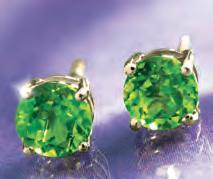

Romance guaranteed or your money back. Experience the scintillating beauty of the Helenite Teardrop Necklace for 30 days and if she isn’t completely in love with it send it back for a full refund of the item price. You can even keep the stud earrings as our thank you for giving us a try.

Stauer… Afford the Extraordinary . ®
• 4 ¼ ctw of American Helenite and lab-created DiamondAura® • Gold-finished .925 sterling silver settings • 16" chain with 2" extender and lobster clasp Rating of A+ 14101 Southcross Drive W., Ste 155, Dept. HEN436-01, Burnsville, Minnesota 55337 www.stauer.comStauer ® * Special price only for customers using the offer code versus the price on Stauer.com without your offer code. Helenite Teardrop Necklace (4 ¼ ctw) $299* .....Only $129 +S&P Helenite Stud Earrings (1 ctw) ....................................... $129 +S&P Helenite Set (5 ¼ ctw) $428* ...... Call-in price only $129 +S&P (Set includes necklace and stud earrings) Call now and mention the offer code to receive FREE earrings. 1-800-333-2045 Offer Code HEN436-01 You must use the offer code to get our special price. Uniquely American stone ignites romance Tears From a Volcano Necklace enlarged to show luxurious color EXCLUSIVE FREE Helenite Earrings -a $129 valuewith purchase of Helenite Necklace 4 carats of shimmering Helenite Limited to the first 1600 orders from this ad only “I love these pieces... it just glowed... so beautiful!” — S.S., Salem, OR WW2-221108-012 Stauer Helenite Teardrop Necklace.indd 1 10/1/22 1:36 PM
Curators at The National World War II Museum solve readers’ artifact mysteries

An American B-24 bombardier downed over Slovakia in late 1944 brought home this one-of-a-kind German medal (above) as a souvenir. What about it makes it unique?
THE
MIX AND MATCH
My father, Robert W. Wicks, was a B-24 bombardier with the 763rd Bomb Squadron of the 460th Bomb Group, 15th Air Force, based in Spinazzola, Italy. e was shot down on his 24th combat mission in December 1944 and saved by a Slovak family who hid him on their farm for almost five months.
Shortly after my father passed away in 1996, I came across this German medal I have not been able to identify. Can you tell me its significance?
—David E. Wicks, Dansville, N.Y.
As the war entered its final year, thousands of American service men snatched up Third Reich medals and pins by the handful. They were perfect souvenirs—small and plentiful, but still bear ing the fearsome iconography of the Nazi regime.
While The National World War II Museum focuses on the American wartime experience, this institution also holds a vast and varied collection of German military and civilian ephemera, most of which came home in the sea bags and rucksacks of exhausted U.S. servicemen returning home in 1945 and 1946. A dive into our collection reveals no fewer than 15 examples of this medal, the Kriegsverdienstkreuz, or War Merit Cross, which was awarded to both soldiers and civilians for exceptional service unrelated to combat. While more than a dozen of these silver or bronze state decorations reside in our collection, I have never seen one with a ribbon apparently poached from another German military award.
The blood-red ribbon attached to this War Merit Cross, with thin black and white lines at its center, comes from an Ostmedaille, known in Western circles as the Eastern Medal, or more formally, the Winter Battle in the East 1941–42 Medal. It was awarded to German servicemen who fought in the invasion of the Soviet Union during that first terrible winter. The commendation was also given to the families of those who died, inspiring some to ghoulishly call it the “Order of the Frozen Meat.”
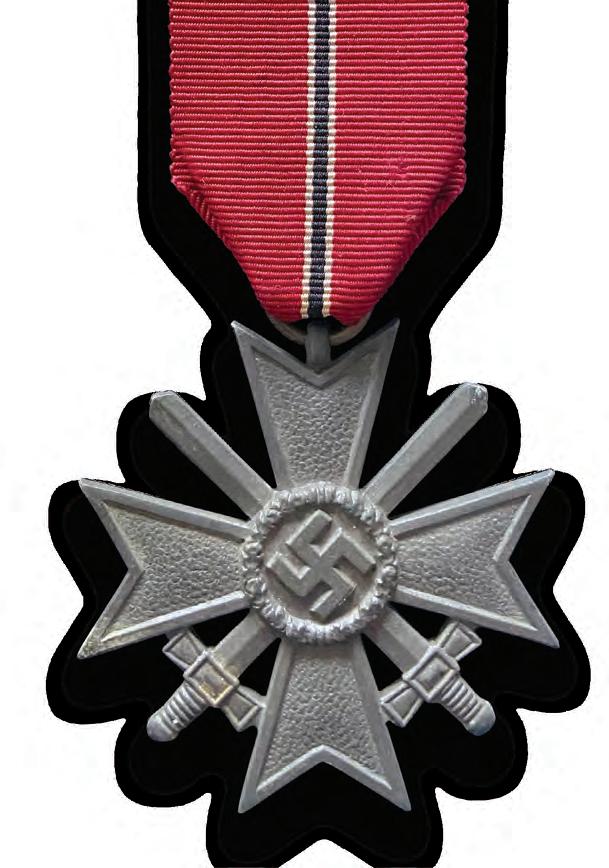
The owner of this unusual conglomeration of wartime memorabilia tumbles into our story from war-torn skies. First Lieutenant Robert W. Wicks bailed out of his stricken B-24 on December 11, 1944. He wasn’t supposed to be there, but at the last moment had switched to the ill-fated Liberator to give the new crew a more experienced bombardier. He parachuted into Slovakia, where he was hidden by the Pavol Macina family on their farm for months.
At the conclusion of fighting in Europe, Wicks came home. On his long road back, did he encounter a savvy entrepreneur selling souvenirs from the cast-off fragments of the now-defunct totalitarian state? Or did he assemble this unique war memento on his own? We may never know for sure. While the origin of the unusual piece is murky, the psychology of grabbing a trophy checks out. Many soldiers, sailors, and fliers, when given the chance, snatched a small fragment of the vanquished to take home. —Cory Graff, Curator
Have a World War II artifact you can’t identify?
Write to Footlocker@ historynet.com with the following:
Your connection to the object and what you know about it.
The object’s dimensions, in inches.
Several high-resolution digital photos taken close up and from varying angles.
Pictures should be in color, and at least 300 dpi. Unfortunately, we can’t respond to every query, nor can we appraise value.
WORLD WAR II22 COURTESY OF THE WICKS FAMILY
FROM
FOOTLOCKER
WW2P-230100-FTLCKR-1.indd 22 9/28/22 6:16 PM
a full front zipper, and silver-toned metal tippets on the hood drawstrings. Imported.

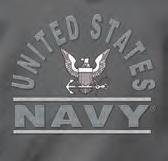
Remarkable Value... Available for a Limited Time
in 5 men’s sizes M-XXXL, this personalized hoodie is a remarkable value at just $99.95*, payable in 3 easy installments of $33.32, and backed by our 30-day money-back guarantee. This is a limited-time offer, so don’t delay. To acquire yours, send
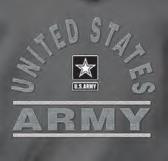

just return the



Reservation

B_I_V = Live Area: 7 x 9.75, 1 Page, Installment, Vertical Price Logo Address Code Tracking Code Yellow Snipe Shipping Service READY AT THE REVEILLE Military Personalized Hoodie Signature Mrs. Mr. Ms. Name (Please Print Clearly) Address City State Zip Email E57301 YES. Please reserve the “Ready at the Reveille” Military Personalized Hoodie for me with the name, branch and size indicated below. (Personalization will be in all capital letters.) ©2022 The Bradford Exchange 01-32397-001-BIBMPOR1Connect with Us! ❑ U.S. Air Force™ 01-32398-001 Size ❑ U.S. Army® 01-32399-001 Size ______ ❑ U.S. Marines 01-32397-001 Size ❑ U.S. Navy® 01-32400-001 Size ______ Available in 5 Men’s Sizes M-XXXL Stay warm and strong in proud military style. Crafted in a charcoal gray easy-care cotton blend knit, this everyday hoodie showcases a bold design featuring your branch of choice and logo on the back. The sleeve displays your branch motto and the front is personalized with your name or nickname (max. 12 characters) in embroidery, along with the branch logo and name with established date. Custom details include expertly embroidered accents, a comfortable brushed fleece interior, a light gray thermal knit lined hood, kangaroo front pockets, knit cuffs and hem,
A
Available
no money now;
Priority
today! PRIORITY RESERVATION SEND NO MONEY NOW Where Passion Becomes Art. The Bradford Exchange 93 45 Milwaukee Avenue, Niles, Illinois 60714-1393 U.S.A. *Plus a total of $14.99 shipping and service each (see bradfordexchange.com). Please allow 2-4 weeks after initial payment for shipment. Sales subject to product availability and order acceptance. Product subject to change. Order Today at bradfordexchange.com/militaryready U.S. ARMY ® “THIS WE’LL DEFEND” ON SLEEVE U.S. NAVY® “SEMPER FORTIS” ON SLEEVE U.S. AIR FORCE ™ “FLY. FIGHT. WIN.” ON SLEEVE U.S. Marines PERSONALIZED WITH PRIDE! FREE PERSONALIZATION Max 12 characters per hoodie M (38-40) L (42-44) XL (46-48) XXL (50-52) XXXL (54-56) Have Your Name Embroidered on the Front of the Hoodie for FREE! ®Officially Licensed by the Department of the Navy. www.airforce.com Officially Licensed Product of the Department of the Air Force. Endorsement by the Department of the Air Force is neither intended nor implied. Officially Licensed Product of the United States Marine Corps. ®Official Licensed Product of the U.S. Army. By federal law, licensing fees paid to the U.S. Army for use of its trademarks provide support to the Army Trademark Licensing Program, and net licensing revenue is devoted to U.S. Army Morale, Welfare, and Recreation programs. U.S. Army name, trademarks and logos are protected under federal law and used under license by The Bradford Exchange. WW2-221108-008 Bradford P USMC Military Grey Hoodie CLIPPABLE.indd 1 10/1/22 12:48 PM
NEED TO KNOW
BY JAMES HOLLAND
FALSE FRONT
I’VE BEEN STAYING on a small Greek island, and from the house I’ve been able to look across the wine-dark sea to the distant blue mountains of Epirus in the northwest part of mainland Greece. It’s hard not to think of Odysseus sailing these waters, but my thoughts also turn to the Greek tragedy of the war years, a dark period in the nation’s history, if ever there was one.
Epirus witnessed the Italian invasion in late October 1940, the Greek counterattack, and then the German invasion a few months later. It also saw not only guerrilla activities but civil war, between the Communist-organized ELAS and the more liberal but anti-monarchy EDES partisan movements. Hundreds of thousands of civilians were killed during those years, and thou sands—literally—of villages were wiped from the face of the earth.
The Allies, and the British especially, also played their part in Greece’s war: first, sending some 48,000 British troops plus a handful of Royal Air Force planes when the Germans and Bulgarians invaded in April 1941. The Germans swept all before them in a matter of weeks, the British hastily evac uated, and, thereafter, their involvement continued in the form of the Special Operations Executive (SOE).
SOE agents infiltrated Greece with little understanding of what was going on internally. Guidelines from London were to incite armed resistance against the Axis, but also to promote loyalty to the exiled Greek king—even though, for all the different politics within Greece, one unifying factor was a growing desire to get rid of the monarchy.
The SOE in Greece, led by Major Eddie Myers, soon began to understand the complex and immense challenges they faced, and navigating these tricky waters swiftly led to some uncomfortable moral compromises. One of SOE’s roles was to sabotage Axis supply lines, but another, in the summer of 1943, was to persuade the Germans and Italians that Greece was the main target for an imminent Allied invasion, rather than Sicily, the real objective. That meant also persuading the ELAS and EDES partisans that Greece was about to be invaded. In other words, they had to dupe their allies into believing something they knew to be wholly false. The consequences of Operation Animals—blowing up bridges, attacking Axis troops and locomotives—were

the roundup of Greek civilians, sum mary executions, and the destruc tion of villages. Many Greeks lost their lives in an effort to make the Axis believe the Allies intended to land in Greece and not Sicily.
Much has been made of these deception measures, especially with Operation Mincemeat, the British plan to ditch a body into the Mediter ranean with incriminating papers attached that pointed to an Allied invasion first of Sardinia, then of Greece. The story has just been adapted into a film with all the hyperbole of changing the course of history one would expect from a movie release.
It’s true two German divisions were sent to Greece, but this was more in anticipation of the imminent Italian collapse: there were some 750,000 Italian troops throughout Greece and the Balkans that would need replacing should Italy drop out of the war. In truth, Hitler was convinced Greece would be the next target because he was paranoid about the Allies taking the Ploesti oil fields in Romania, and an Allied attack in Greece seemed to give them the best chance of achieving that. But Albert Kesselring, his senior com mander in the Mediterranean, and the Italian high command, Musso lini included, all assumed the Allies would attack Sicily, because it was so blindingly obvious. Only Sicily allowed the Allies fighter cover from bases in North Africa, a prerequisite for such an amphibious assault. Operations Animals and Mincemeat reinforced what Hitler already believed and dissuaded no one else that the target would be Sicily.
Fortunately today, the mountains of Epirus are altogether more peace ful, but gazing across the sea I can not help wondering about the nature of the moral crusade on which the Allies embarked during the war. For the cause of right, yes, but with a number of moral conundrums along the way, of which duping the Greeks was just but one. H
WORLD WAR II24 XXXXXXXXXXXXXILLUSTRATION BY RICHARD MIA
WW2P-NEEDTOKNOW-2.indd 24 9/26/22 5:09 PM
It was a perfect late autumn day in the northern Rockies. Not a cloud in the sky, and just enough cool in the air to stir up nostalgic memories of my trip into the backwoods. is year, though, was di erent.
I was going it solo. My two buddies, pleading work responsibilities, backed out at the last minute. So, armed with my trusty knife, I set out for adventure.
Well, what I found was a whole lot of trouble. As in 8 feet and 800-pounds of trouble in the form of a grizzly bear. Seems this grumpy fella was out looking for some adventure too.

Mr. Grizzly saw me, stood up to his entire 8 feet of ferocity and let out a roar that made my blood turn to ice and my hair stand up. Unsnapping my leather sheath, I felt for my hefty, trusty knife and felt emboldened. I then showed the massive grizzly over 6 inches of 420 surgical grade stainless steel, raised my hands and yelled, “Whoa bear! Whoa bear!” I must have made my point, as he gave me an almost admiring grunt before turning tail and heading back into the woods.
But we don’t stop there. While supplies last, we’ll include a pair of $99 8x21 power compact binoculars FREE when you purchase the Grizzly Hunting Knife.

Make sure to act quickly. The Grizzly Hunting Knife has been such a hit that we’re having trouble keeping it in stock. Our first release of more than 1,200 SOLD OUT in TWO DAYS! After months of waiting on our artisans, we've finally gotten some knives back in stock. Only 1,337 are available at this price, and half of them have
Knife
• Stick tang
I was pretty shaken, but otherwise ne. Once the adrenaline high subsided, I decided I had some work to do back home too. at was more than enough adventure for one day.
Our Grizzly Hunting Knife pays tribute to the call of the wild. Featuring stick-tang construction, you can feel con dent in the strength and durability of this knife. And the hand carved, natural bone handle ensures you won’t lose your grip even in the most dire of circumstances. I also made certain to give it a great price. After all, you should be able to get your point across without getting stuck with a high price.

The
sold!
carved natural
hand
already
Speci cations:
420 surgical stainless steel blade; 7 ¼" blade; 12" overall •Hand
brown and yellow bone handle •Brass
guard, spacers and end cap •FREE genuine tooled leather sheath included (a $49 value!)
Grizzly Hunting Knife $249 $79* + S&P Save $170 California residents please call 1-800-333-2045 regarding Proposition 65 regulations before purchasing this product. *Special price only for customers using the offer code. 1-800-333-2045 Your Insider Offer Code: GHK185-02 Stauer, 14101 Southcross Drive W., Ste 155, Dept. GHK185-02, Burnsville, MN 55337 www.stauer.com Stauer® | AFFORD THE EXTRAORDINARY ® A 12-inch stainless steel knife for only $79 I ‘Bearly’ Made It Out Alive What Stauer Clients Are Saying About Our Knives “The feel of this knife is unbelievable... this is an incredibly fine instrument.” — H., Arvada, CO “This knife is beautiful!” — J., La Crescent, MN 79 Stauer®Impossible Price ONLY Join more than 322,000 sharp people who collect stauer knives EXCLUSIVE FREE Stauer 8x21 Compact Binoculars -a $99 valuewith your purchase of the Grizzly Hunting Knife WW2-221108-011 Stauer Grizzly Hunting Knife.indd 1 10/1/22 1:34 PM
TRAVEL SALINA, UTAH STORY AND PHOTOS BY JESSICA WAMBACH BROWN
A TRAGIC NIGHT IN UTAH
IN THE FIRST HOUR OF JULY 8, 1945, six-year-old Rodney Rasmussen was startled awake in his bed in Salina, Utah, by the unmistakable rhythm of machine gun fire a mere 300 feet away. He dressed and hustled to the front porch in time to see the flash of the .30-caliber Browning in the guard tower across the street still raining bullets into the compound where 250 German prisoners of war had been peacefully sleeping in neat rows of canvas tents.
Salina, a town of 2,600 people tucked between the Pahvant and Wasatch Mountains, where the dirt gradually brightens from beige to the signature burnt orange of southern Utah, seems an unlikely location for the largest mass murder of German prisoners on U.S. soil during World War II. The biggest hazards I encounter on my visit are the Tootsie Rolls still clinging to the sidewalks two weeks after a classic small-town, candy-tossing Fourth of July parade.
The darkest moment of Salina’s history would still be largely forgotten were it not for the homegrown effort that launched the CCC & POW Camp Salina museum in 2016. I step inside the camp’s slightly renovated and relo cated command post to meet Rasmussen, now 83, who still lives in his child hood home and caretakes the museum, which also includes a restored guard barracks and the original motor pool garage. Rasmussen extinguishes the loud fans battling the dry morning heat to walk me through Salina’s past.
In 1863, 28 Mormon families moved south from Salt Lake City to settle the north Sevier River valley. Salt, or “sal” in Spanish, became Salina’s namesake industry, later to be supplanted by farming and coal mining. The command post’s exhibits tell how in 1933 the Civilian Conservation Corps—President

Franklin D. Roosevelt’s effort to employ young men slighted by the Great Depression while also advanc ing public works—set up a camp here on the eastern end of Salina, where Main Street disappears into dusty shrub-speckled foothills. With the U.S. entry in World War II, the CCC dissolved and most of the Salina camp buildings were dismantled and moved 80 miles northwest to Delta, Utah, for use in the Topaz War Relo cation Center, one of 10 camps in the western U.S. interior where Japa nese Americans would be detained for fear of their possible sympathy toward Japan.
In 1943, the United States began to host prisoners of war captured in Europe and North Africa and launched construction of a vast net work of camps—primarily in rural inland areas—to house them. The army opened a large camp in Ogden, Utah, with nine small branch camps strategically located throughout the state to ease war-caused non-mili tary labor shortages. The remains of Salina’s CCC camp became Branch Camp No. 4. Although Germany would surrender in May 1945, it would take the United States more than a year to return the nearly 400,000 German and Italian prison ers in its care to war-ravaged Europe.
WORLD WAR II26 QUAD-CITY TIMES ARCHIVES
Little remains of the former POW camp in Salina, Utah, where a G.I. shot dozens of unarmed German prisoners on July 8, 1945.
WW2P-22-TRAVEL-SALINAUTAH-3.indd 26 10/5/22 3:32 PM
Meanwhile, on June 7, 1945, 250 German prisoners previously held in Arizona arrived in Salina to work on the many local farms that were producing sugar beets in a labor-intensive effort to thwart the national sugar shortage. Six days a week, trucks hauled the men in small groups to fields where they thinned and harvested beets for 5 to 10 cents per day.
Rasmussen opens the doors to the restored guard barracks to reveal an intricate scale model of the camp. Forty-three tents on wooden platforms surrounded a latrine, a kitchen where prisoners prepared meals, and a mess hall. Two layers of wire fencing enclosed the compound, with a wooden guard tower rising over each corner, save the southeast, where a natural hill provided the foundation for a small guardhouse.
I cross the road and scramble up that hill to project the museum’s model across the few acres that once housed the camp. Today, it is half-rodeo arena for the Salina Riding Club, half empty asphalt park ing lot. The only surviving camp structure still in place is the unrec ognizable mess hall. Years ago, the Riding Club tacked corrugated tin over the hall’s lath and tar paper siding and used it as their office building.
Back in the pine-sided motor pool garage, which still houses original tools soldiers used to maintain the few vehicles assigned to the camp, a plaque tells me the museum was largely the vision of the late Dee Olsen, who was a teen ager when prisoners came to work on his family farm seven miles up the road in Axtell. “His sister and mother would make chicken lunches for the prison ers,” says Olsen’s daughter, Tami Beach.
Prompted by Salina’s mayor, in 2014 Olsen, a retired engineer, recruited Beach and a few others to help raise funds and restore the salvageable build ings into a museum. Locals pitched in a variety of remnants now on display, from a box of original tent pegs to a slightly tattered prisoner uniform to a jewelry box one prisoner crafted from matchsticks and toothpicks and gifted to a farming family for whom he worked.
U.S. soldiers assigned to Branch Camp No. 4 had the monotonous duty of guarding compliant prisoners in the quiet fields and tents. Private Clarence V. Bertucci, a short and slight 23-year-old from New Orleans, loathed the job. In his five years of army service, he had seen no combat and had twice faced
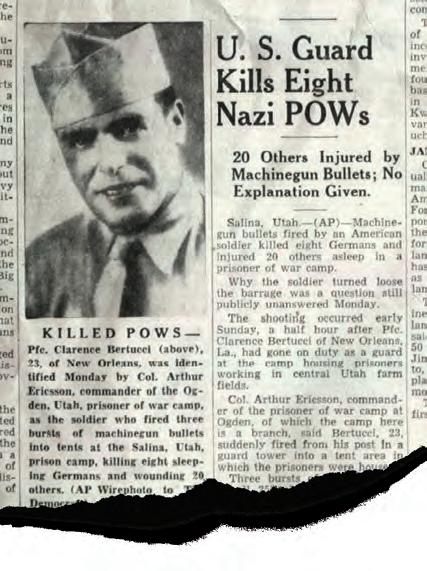
Bertucci would later report his desire to “get his Germans someday.”
On Saturday night, July 7, Bertucci had coffee at Salina’s Mom’s Cafe, men tioned to a waitress that something exciting was about to happen, then walked the seven blocks to camp. After downing a cup or two in the still thriv ing sandy-bricked café myself, I do the same. In a single block, the awninged stucco-and-glass storefronts of down town give way to tidy single-story resi dences. A teenage boy watering hanging pots of petunias smiles at me, and I wonder whether anyone that fateful
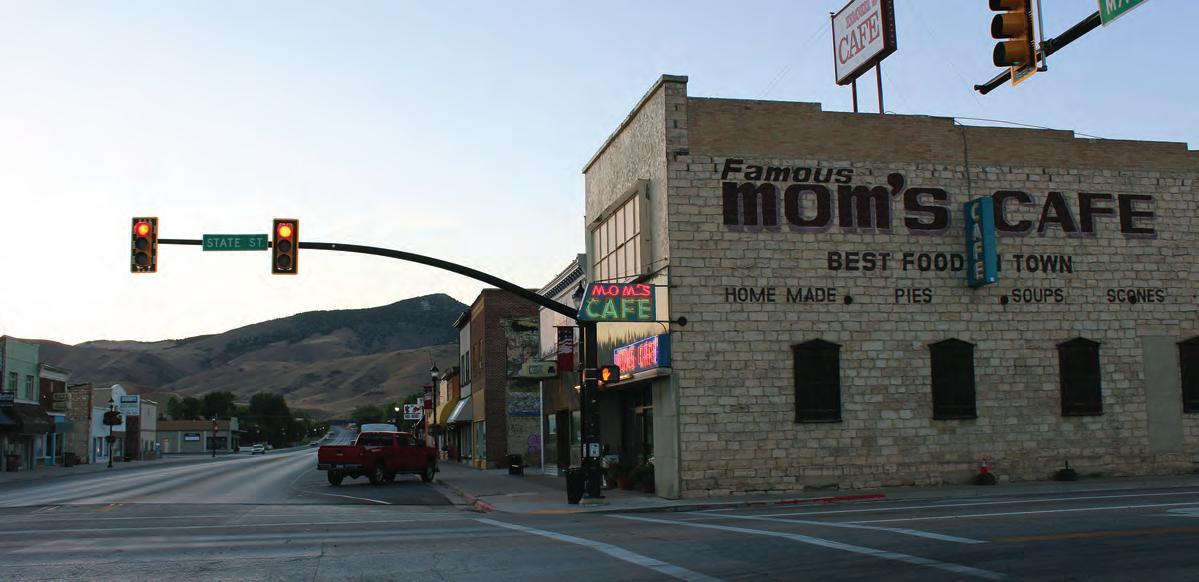
XXXXXXXXXXXXX XXXXXXXXXXXXX AUTUMN 2022 27 QUAD-CITY TIMES ARCHIVES
Private Clarence V. Bertucci (bottom right) had coffee at Mom’s Cafe–still a staple of downtown Salina—before walking to his guard post overlooking the POW camp to commit his crime.
WW2P-22-TRAVEL-SALINAUTAH-3.indd 27 10/6/22 10:45 AM
night noticed Bertucci ascending the gradual grade of Main Street.
At midnight, Bertucci checked in for his shift and climbed the southwestern guard tower. He removed a 250-round cartridge belt from storage, loaded the machine gun, and emptied it in a barrage that hit 30 of the tents and briefly envel oped the camp in dust.
“We came out on the front porch and we could hear the cries of the pris oners,” Rasmussen recalls. As I stand in the spot where Bertucci committed his crime, the only sounds are cattle lowing from the Riding Club’s stock pens and the faint buzz of dirt bikes climbing the trails that weave through the rust-colored hills rising to the east.
Startled fellow soldiers bounded up the tower and subdued Bertucci just as he was reaching for more ammunition. Six prisoners were dead in their bunks. The 22 wounded were staged on mattresses on the green lawns of neighboring homes, then trucked 12 blocks west to the city’s 14-bed hospital. The ruckus drew nearly the whole town out of bed hours before the rising sun would reveal the trail of blood down Main Street.
While the most severely wounded were squeezed inside the hospital, Sali na’s lone doctor and a pair of nurses val iantly treated the others on the lawn that today is an empty gravel lot destined to
be the home of Salina’s new city hall. Most of the victims were transferred to military hospitals the next day for advanced care or recovery. Three of the wounded would die, bringing Bertucci’s death toll to nine.
On July 9, the front pages of Utah’s largest newspapers told the gruesome story of the guard gone mad who had made a mockery of the safe conduct promised to prisoners from a nation that had surrendered two months earlier. Ber tucci showed no remorse and revealed no motive for his crime beyond his deep disdain for Germans. Army doctors declared him mentally unstable. He was discharged and confined to Mason General Hospital, a U.S. Army psychiatric facility in New York. He would spend much of the rest of his life in mental health facilities.
Fifteen Salina prisoners served as pall bearers when the dead were laid to rest in unmarked khaki American uniforms at Salt Lake City’s Fort Douglas Cemetery. A choir of prisoners from the nearby Ogden camp sang German hymns.

With the Allies slowly repatriating prisoners and the fall beet harvest com plete, the Salina camp was empty by December 1945. It would house other farm laborers for a few years before lower maintenance corn and alfalfa crops replaced sugar beets and the build ings were left mostly to the whims of nature. Soon this short chapter of Sali na’s story was covered in the Utah dust, waiting to be unearthed decades later. H
WHEN YOU GO
Salina sits at the crossroads of Interstate 70 and U.S. Highway 89, a two-hour drive south from Salt Lake City. Visitors to the CCC & POW Camp Salina museum are welcome Monday through Saturday year-round. Call Rodney Rasmussen at 435-633-5167 to arrange an opening.
WHERE TO STAY AND EAT
Salina has a half-dozen chain motels, but the High Desert Inn (highdesertinn-salina. com) downtown provides easy walking access to the museum. Try the Sevier Valley Coffee Co. & Gift Shop for a strong morning pick-me-up (tel: 435-5313495) and regionally beloved Mom’s Cafe (momscafe. org), housed in an 1878 brick building, where the pancakes and bacon will keep you going all day long.
WHAT ELSE TO SEE AND DO
Plan your visit around the epic Eyes to the Sky Balloon Festival (eyestotheskyballoonfestival. com) in June or Salina’s Fourth of July celebration. The dense collection of artifacts at Miss Mary’s Historical Museum (tel: 435-529-4108) tells the story of Salina’s early settlement. From Salina, it’s a 90-minute drive southeast to the red rocks of Capitol Reef National Park (nps.gov/ care), unless you stop midway to visit Pando, a quaking aspen grove with a single root system that’s considered the world’s most massive organism (fs.usda. gov/detail/fishlake). The hoodoos of Bryce Canyon National Park (nps.gov/ brca) are a lovely two-hour drive south.

WORLD WAR II28 AP; MAP BY BRIAN WALKER
Fellow German prisoners served as pallbearers when the murdered POWs were buried at Fort Douglas Cemetery in Salt Lake City.
UTAH AZ NV SALT LAKE CITY LAS VEGAS SALINA WW2P-22-TRAVEL-SALINAUTAH-3.indd 28 10/6/22 10:45 AM
HOME AWAY FROM HOME




A
On any given night, up to 1,300 service members, veterans, and their families can call Fisher House home. These comfort homes are free of charge while a loved one is receiving care at military and VA hospitals. ALL VETERANS. ALL ERAS. For Service members, Veterans, and their families. VISIT FISHERHOUSE.ORG FREE LODGING | HERO MILES | HOTEL FOR HEROES WW2-221108-003 SMG Donation Pg.indd 1 10/1/22 12:59 PM
At sunset on March 9, 1945, Major General Curtis E. LeMay watched the first of more than 300 bombers lift off from Guam’s crushed coral runway for a midnight strike on Tokyo some 1,500 miles to the north. The 38-year-old LeMay, who had endured a hardscrabble childhood as the son of an itinerant worker, understood the incredible stakes of the night’s mission. The burly general had landed his job as the head of the XXI Bomber Command after his predecessor was fired for his inability to destroy Japan’s aircraft factories. In the nearly two months since he had taken over, however, LeMay had suffered the same dismal results. But far more was at risk than just his career. If LeMay’s bombers could not force the Japanese to surrender, hundreds of thousands of troops would have no choice but to storm the beaches of the enemy’s homeland in what promised to be a bloody invasion.
But tonight, LeMay gambled, everything would change.
America’s incendiary bombing campaign of Japan began in Tokyo on March 9, 1945, and continued across the country.

Here Shizuoka burns on July 12.
America’s longstanding policy of daylight precision bombing—designed to minimize civilian casualties—had failed. LeMay determined that to successfully attack the enemy’s home islands required a radical rethinking of American strategy, one so unorthodox, perilous, and morally fraught that he refused to tell his superiors. He would go it alone. LeMay planned to change more than just his tactics, but also his type of target. Gone was the pinpoint focus on the enemy’s industry. Instead, he planned to unleash his bombers armed with napalm incendiaries on downtown Tokyo’s crowded neighborhoods. One of the world’s most congested cities, the capital counted more than 100,000 men, women, and children per square mile, an area LeMay hoped to incinerate by dawn. This was no ordinary mission—and LeMay knew it. This was murder.
NIGHT
TERRORS
Curtis LeMay’s new and devastating bombing tactics laid waste to Tokyo and killed tens of thousands of civilians—and that was just the start
By James M. Scott
WORLD WAR II30
WW2P-230100-TOKYO-2.indd 30 9/26/22 5:17 PM
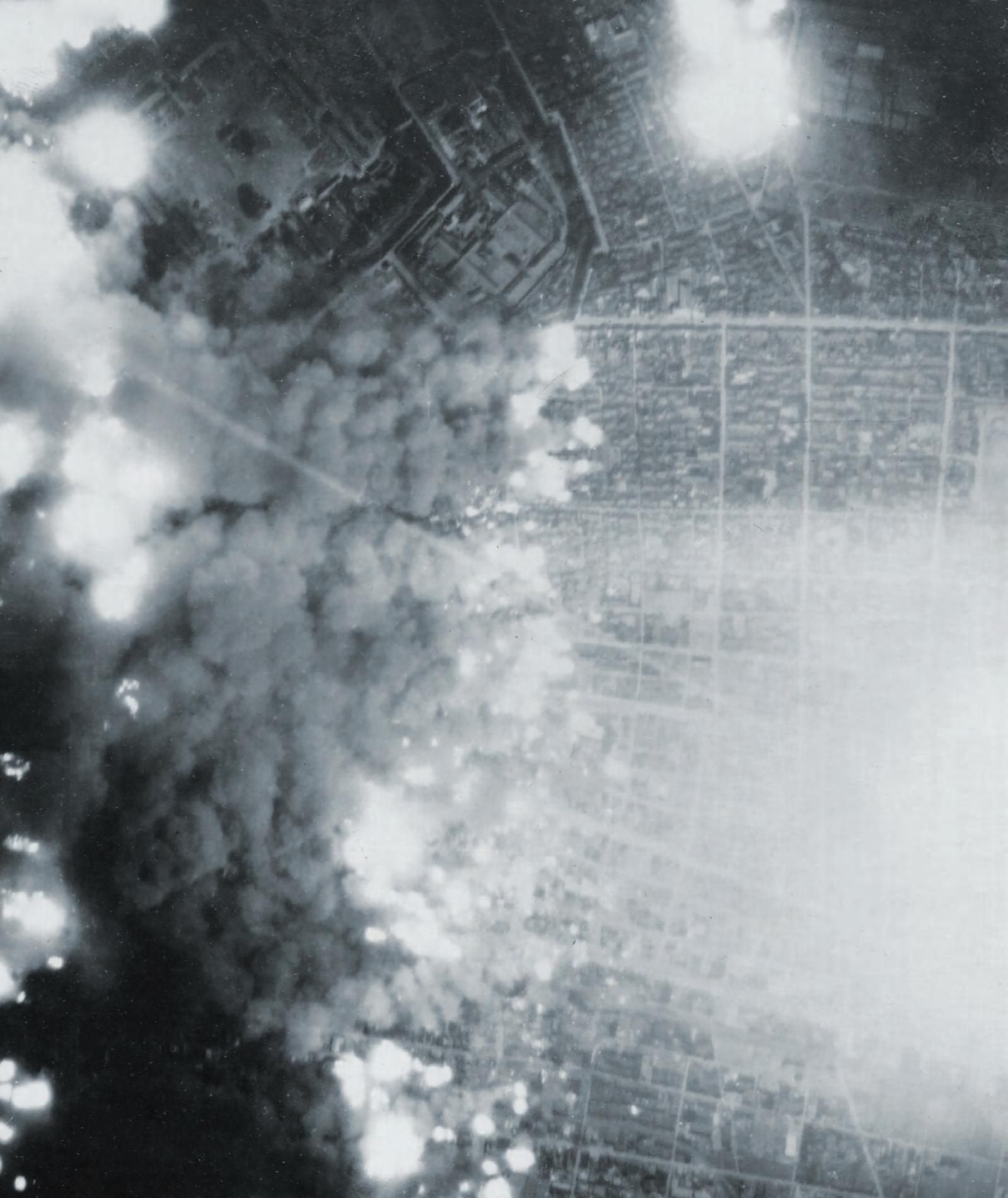
WW2P-230100-TOKYO-2.indd 31 9/26/22 5:17 PM
“If we lose,” the general confided in an aide, “we’ll be tried as war criminals.”
The mission that March night would prove the single-most destructive raid of World War II—and a significant moral turning point for the United States, where doctrine had long forbidden the intentional killing of civilians.
When the sun rose over Tokyo six hours after the first bombs fell, it revealed an apocalyptic wasteland. A firestorm sparked by the bomb ing had devoured 16 square miles of homes, businesses, and factories and killed 105,000 men, women, and children. That sum was more than four times those killed in the fire raid on Dresden, and more even than those who initially died in the atomic attacks on Hiroshima and Nagasaki. The lack of public outcry in the United States by either the press or lawmakers served as a green light for LeMay, whose firebombing campaign in the last five months of the war torched hundreds of square miles in scores of Japanese cities and concluded with the atomic bombings. “Tokyo,” as one Army Air Forces report wryly noted, “got the superdeluxe treatment.”
LEMAY’S DECISION TO BURN Japan’s cities did not arise in a vacuum. The United
States had entered World War II committed to a strategy of high-altitude daylight precision bombing, a concept developed in the 1930s at the Air Corps Tactical School at Alabama’s Maxwell Field. In the school’s white stucco classrooms, young officers—often dubbed the “Bomber Mafia”—preached the idea of pinpoint strikes on an enemy’s critical industries. Such a strategy, the Mafiosi believed, promised to collapse a nation’s modern economy, much like a house of cards. This would, in theory, bring about a faster end to the war and spare unnecessary civilian deaths. Bomber advocate Haywood Hansell, who helped develop Amer ica’s air strategy in the lead-up to the war, saw precision strikes as far more humane than burning cities. “The idea,” Hansell once wrote, “of killing thousands of men, women and children was basically repugnant to American mores.”


Major General Curtis E. LeMay was the architect of the firebombing campaign. He noted, “If we lose the war, we’ll be tried as war criminals.”
The air war against Germany, however, exposed the strategy’s many blind spots. Enemy fighters not only shredded Allied bombers, but the German economy proved far more resilient than war planners anticipated. The high losses prompted the British in 1942 to abandon precision strikes in favor of firebombing German cities at night. Bomber Command leader Sir Arthur Harris, known by the colorful nickname “Bomber Harris,” would become the face of England’s city-burning campaign. “He believed there were no shortcuts to victory,” wrote British historian Max Hastings. “It was necessary to concentrate all available forces for the progressive, sys tematic destruction of the urban areas of the Reich, city block by city block, factory by factory, until the enemy became a nation of troglo dytes, scratching in the ruins.”
Despite the British abandonment of what Harris disdainfully described as “panacea” targets, America remained committed to the strategy of precision bombing, even as the air war shifted from Europe to the Pacific. The battle against Japan, however, proved far more challenging. American air bases in the battered Mariana Islands were primitive compared to the ones troops had enjoyed in England. Air crews likewise were forced to fly much greater distances across an unforgiving ocean, all in a sophisticated new bomber, though one still plagued by mechanical challenges. The job of making it work fell to Brigadier General Hansell, a genteel commander who wrote poems, recited Shakespeare, and adored Gilbert and Sullivan operas. Han sell’s first strike on Tokyo on November 24, 1944, was largely a bust.
So, too, was his second. And the third, fourth, and fifth.
Japan’s horrendous weather added to Hansell’s troubles. Clouds often blanketed the island nation, limiting visual bombing some months to as few as three days. Furthermore, violent jet streams raged over Japan at speeds of up to 230 miles per hour, rivaling the gales that battered Mount Everest. “The weather was just too damn bad,” he complained. “It whipped us.”
Hansell’s refusal to adapt his tactics led Army Air Forces Com mander General Henry “Hap” Arnold to fire him after only nine mis sions and just 44 days after his crews flew the first strike on Tokyo.
WORLD WAR II32 ALL PHOTOS: NATIONAL ARCHIVES
WW2P-230100-TOKYO-2.indd 32 9/26/22 5:17 PM
LeMay landed on Guam in January 1945 as his replacement. With a head full of ink-black hair and hazel eyes, LeMay was everything Han sell was not. He lacked the social grace and polish of his poetic prede cessor, having labored on the graveyard shift in a Columbus steel mill just to put himself through college at Ohio State. Nicknamed “Iron Ass” by his men, LeMay suffered Bell’s palsy early in the war. He hid the residual effects of the facial paralysis behind a pipe or cigar. The general’s reserved demeanor, however, camouflaged a tireless work ethic that had propelled him to become one of the top air commanders in Europe, as evidenced by his efficiency reports. “This officer,” famed aviator Jimmy Doolittle gushed in one, “is unusually gifted as an airman and as a combat leader.”
Despite his previous successes, LeMay harbored no illusions over the challenge of his job in the Pacific. Beyond battling the winds, weather, and the Japanese, he like wise felt tremendous pressure from Arnold, who was the father of the B-29 Superfor tress. At $3.7 billion, the bomber ranked as the single-most expensive weapons system of the war, costing American taxpayers more than even the atomic bomb. Arnold not only felt pressure to justify his pricey gamble on the Superfortress, but he also was the leading advocate of making the air force a separate ser vice from the army. To do so, he had to prove that his airmen played an equal role alongside the army and navy in the defeat of Japan. A stressed-out Arnold, who suffered his fourth heart attack of the war in January 1945, pinned those hopes on the B-29 and LeMay. “If you don’t get results,” one of Arnold’s aides warned LeMay, “you’ll be fired.”

LEMAY INITIALLY ADOPTED Hansell’s tactics of daylight precision bombing only to suffer the same disastrous outcome. The Nakajima Aircraft Company’s factory in the Tokyo suburb of Musashino, just 10 miles west of the Imperial Palace, stood as a symbol of America’s fail
LeMay supplanted Brigadier General Haywood Hansell (top left), whose precision daytime bombing tactics proved unsuccessful. Above: Ground crew on Saipan load conventional 2,000pound bombs onto a B-29 before a strike on Japan.
ure. Bombers had attacked the plant on the first Tokyo strike on November 24 and had repeatedly returned without success. The fac tory functioned at 96 percent despite the fact that the 835 B-29s had targeted it with 2,327 tons of bombs. After almost four months of strikes, in fact, America had yet to destroy a single priority target via precision bombing. Hansell had clung to his principles like a bucking bull, and watched in the end as his career was trampled.

LeMay didn’t have that luxury. He had learned growing up as the son of a derelict father that if he didn’t work, he didn’t eat. The same had applied in college, where he had paid handsomely for his education with long nights in the sweltering steel mill. Those lessons had made LeMay a pragmatist. If he wanted to win the war—and save hundreds of thousands of American lives as well as his own job—he had to do what was necessary, even if it was mor ally grotesque.
But for LeMay, it was about more than just principles. Similar to Bomber Harris, LeMay had lost faith in the strategy that had defined American bombing policy. He had flown mis sions deep into the heart of Germany, pressing on through black clouds of bursting flak and battling fighters. Such operations, with their staggering losses over time, had eroded his
WINTER 2023 33 ALL PHOTOS: NATIONAL ARCHIVES
LeMay’s decision to bomb and burn Japan’s cities did not arise in a vacuum.
WW2P-230100-TOKYO-2.indd 33 9/26/22 5:18 PM
Before the first Tokyo raid, officers briefed B-29 crews on the new low-level bombing strategy—without fighter protection. When one airman heard the plan, he yelled, “It’s suicide.”
confidence in daylight precision bombing. Pin point targets that could crash the enemy’s econ omy and easily win the war were an illusion.
“That’s just about like searching for the Foun tain of Youth,” he once said. “There is no such thing; never was.”
In LeMay’s mind, there was no shortcut to victory. “You’ve got to kill people,” he said, “and when you kill enough of them, they stop fighting.”
Japan needed to learn that lesson. To do so required LeMay to aban don America’s established strategy of high-altitude precision bombing. LeMay instead planned to drop his bombers as low as 5,000 feet, bringing them in under the cloud cover and roaring jet streams. The lower altitude would expose them to Tokyo’s antiaircraft guns and fighters, turning the raid into a potential turkey shoot. To counter this, LeMay planned to abandon formation flying and push his attacks from day to night, providing his airmen the cover of darkness. In a move that would spark terror in his aircrews, LeMay ordered bombers stripped of guns. Without weapons there was no need to carry ammunition or even gunners, freeing up weight for more bombs. Previous missions typically counted about 100 bombers. For the March 9 mission, LeMay planned to send every plane in his arsenal. More than 300 would lift off from runways on Saipan, Tinian, and Guam and rendezvous in the skies over Tokyo in a mission dubbed “Operation Meetinghouse.”
Tactics, however, were not the only change. LeMay planned to swap demolition bombs for napalm-filled incendiaries. He likewise shifted his aim from factories to neighborhoods, putting the reticle on the kitchens, living rooms, and bedrooms of Japan’s workers. Many such homes doubled as small factories, a vital cottage industry that fed parts to Japan’s ravenous war machine. The general hoped that the combination of low altitude, heavy incendiaries, and Tokyo’s dense wooden construction would conjure a firestorm, like what had ravaged Dresden. Men and women. Boys and girls. Toddlers and infants. Incendiaries did not discriminate. The fires would consume everything and everyone in their frightful path, from factory and armaments workers to artists, teachers, and housewives. “We knew
we were going to kill a lot of women and kids when we burned that town,” LeMay later said. “Had to be done.”
The general’s greatest concern cen tered on the fate of his airmen, the pilots and bombardiers, navigators and radar men. He would send them barely a mile above the earth into the heart of Tokyo, a city guarded by some 300 fighters, rang ing from the Kawasaki Ki-45 to the Mit subishi A6M Zero, and more than 600 antiaircraft guns. LeMay’s antiaircraft experts warned him he could lose as many as 70 percent of his bombers. That would mean more than 200 airplanes and 2,000 souls. LeMay had studied the target photos and was persuaded that Japan lacked low-level guns. He also knew the enemy had only two units of night fighters. Months of consistent high-alti tude daytime attacks meant that a low-level midnight strike would catch the Japanese offguard, like an aerial sucker punch. “You don’t gamble the lives of your people,” he reasoned. “You take calculated risks.”
In sultry Quonset huts on Saipan, Tinian, and Guam, bomb group leaders and intelligence officers prepared to brief the gath ered aircrews about the mission.

“Tonight,” one commander announced, “we have a new plan.”

The pilots, navigators, and bombardiers, tasked to zoom low into a hornet’s nest with out fighter protection or guns, were stunned, even horrified. “This is stupid,” someone hol lered. “It’s suicide.”
These concerns weighed on LeMay at sunset on March 9 as he climbed into the con trol tower on Guam. One by one the lumber ing bombers rolled out of the hardstands, falling in line for the march to the runway, a parade of mechanical monsters. LeMay’s strike force totaled 325 bombers, represent ing 84 percent of his entire arsenal. Even at 50-second intervals, it would still take two hours and 34 minutes to put all the bombers in the skies. All eyes focused on the first bomber as the pilot released the brakes, start ing down the runway. Five hundred feet turned to a thousand and then two thousand. The 135,000-pound Superfortress, its four massive propellers clawing at the air, increased speed and charged down the strip, its nose slowly rising in the muggy March sky. At 5:36 p.m. the bomber left the earth, passed
WORLD WAR II34
WW2P-230100-TOKYO-2.indd 34 10/3/22 2:50 PM
over the beach, and headed out to sea, bound for Tokyo. LeMay’s great gamble had begun.
Throughout the bombers, crews checked and rechecked instruments. One hour soon turned to two. Then three and four. In his operations center back on Guam, LeMay brooded, refusing to go to bed, even though it would be hours before the first strike reports arrived. The general finally returned to his quarters, grabbed a Coke, and then sat in his car, facing the edge of the jungle. The mission’s gravity hung over LeMay, who had staked the lives of more than 3,000 American airmen, the reputation and morals of the United States, and the fate of an entire city. This night, one way or another, would define LeMay for the rest of his life. “I’m sweating this one out,” he confided in an aide. “A lot could go wrong.”
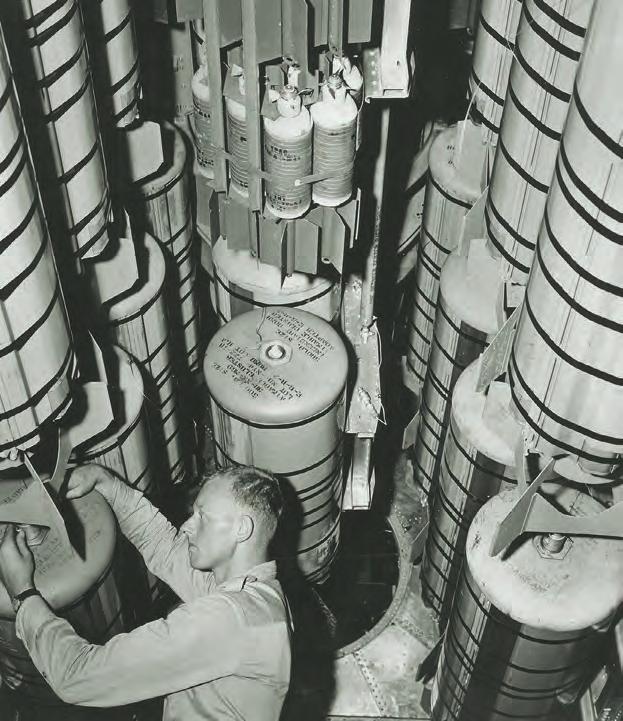
As the first planes closed in on Tokyo, airmen slipped on bulky flak jackets and steel helmets to guard against antiaircraft shrap nel. At 12:07 a.m. the first bombs of what would prove a catastrophic new phase of the war plummeted down toward the crowded capital.
IT WAS A COLD NIGHT IN TOKYO. Snow, which had fallen a few days earlier, blanketed the narrow streets and few parks. Like many in the capital, 12-year-old Katsumoto Saotome was in bed as the first bombers zoomed over the capital. From a poor working-class family in downtown’s Mukojima ward, the junior high school student had been conscripted for the war effort, laboring at Kubota Iron Works. He was asleep when his father shouted for him to get up. The roar of bombers greeted Katsu moto when he opened his eyes. Despite the blackout curtains, light flooded the windows, so bright he could read the characters on a wall calendar. “In every direction I looked,” he recalled, “it was a sea of flaming red fire.”
The family hustled to load a few necessary belongings onto a handcart to escape, leaving behind the pet cat, Tomi. “My, how beautiful,” Katsumoto’s older sister said of the fires.
French journalist Robert Guillain, who was based in Tokyo during the war, likewise charged outside his home to find the horizon glowing red. “Barely a quarter of an hour after the raid started, the fire, whipped by the wind, began to scythe its way through the density of that wooden city,” the reporter wrote. “The air was filled with live sparks, then with burn ing bits of wood and paper until soon it was raining fire. Hell could be no hotter.”
Bookstores, noodle shops, and fish markets erupted in flames along with warehouses and apartments. Minute by minute, the fires grew, feeding on the timber shops and munitions factories, gasoline tanks and stockpiles of coal. In Joto ward, five fires merged to create a single blaze that spanned the entire district. The same occurred in Asakusa ward, where four fires morphed into one. The flames from Fukagawa ward collided with the blazes in neighboring Honjo and Joto wards, creating a massive inferno that covered three city districts. The winds at the blaze’s perimeter topped out at 55 miles per hour while gusts inside the inferno blew at more than 70. Tokyo’s firemen rushed to

WINTER 2023 35
A crewman checks fuses in a B-29’s bomb bay (above) before an incendiary strike. The bombs’ magnesium flares broke apart at low altitudes, setting fires that raged through the densely packed wooden structures of Tokyo (below) and other Japanese cities.
WW2P-230100-TOKYO-2.indd 35 10/6/22 10:48 AM
As the spring of 1945 progressed, so did the firebombing campaign. Here incendiaries rain down on Kobe’s docks on June 5, 1945. Nearly four square miles of the city burned that day.
extinguish the blazes, but within half an hour they realized it was hopeless. “The chief characteristic of the conflagration,” observed the U.S. Strategic Bombing Survey, “was the presence of a fire front, an extended wall of fire moving to leeward, pre ceded by a mass of pre-heated, turbid, burning vapors.” In other words, a tidal wave of fire.
In the skies overhead an aerial freight train of terror rumbled. Nearly 10 tons of bombs fell on average during each minute of the attack. Inbound pilots could see the haunting glow of Tokyo on the horizon from 50 miles away, a distance that soon doubled to 100 miles and then 200. Smoke from the fires wafted up through the bomb bay doors and circulated through the Superfortresses. Airmen long shielded from such carnage by miles of clouds and sky inhaled the acrid aroma of the dying city, the scent of roasted bank ledgers, machine lathes, bedding, and wardrobes. Mixed among the inciner ated wood and paper, however, was the sickening stench of burnt flesh, from dogs and horses to mothers and fathers. “It was,” as pilot Captain Charles Phillips would later recall, “the smell of death.”
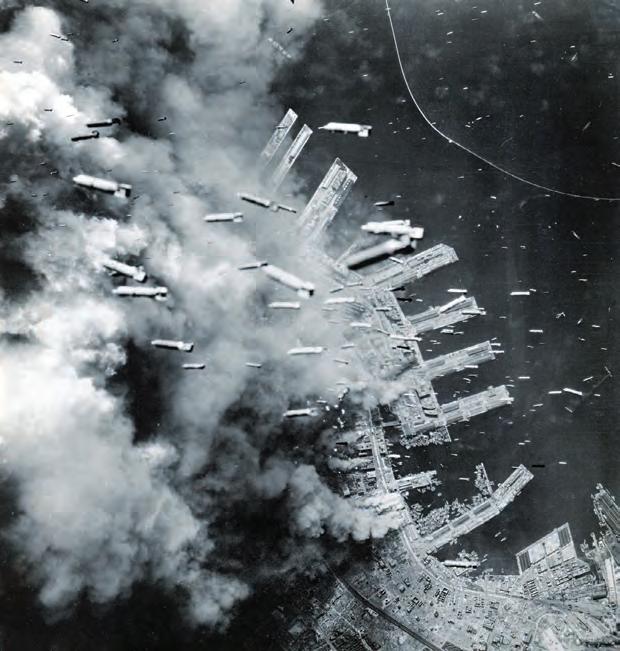
On the ground, residents hustled toward the open grounds of the city’s temples, parks, and riverbanks. Many congregated inside schools, government offices, and train stations which doubled as com munal shelters, hoping the modern concrete construction would prove impervious to fire. Men, women, and children choked on bitter black smoke, the byproduct of burning pine, bamboo, tar, and solvents. The smoke and the heat burned throats while eyes watered. Sparks rained down, singeing eyebrows and lashes. “I couldn’t breathe,” recalled 10-year-old Kakinuma Michi. “I couldn’t open my eyes.”
The fires produced a deafening roar, drowning out the cries of those trapped in the inferno. “The pain caused by the heat and smoke,” said
26-year-old Aoki Hiroshi, “was beyond imagi nation.” The violent winds hurled bags down the streets and ripped children from the grip of parents. The superheated air caused peo ple’s clothes and even hair to ignite spon-tane ously. Evacuees gasped, struggling to breathe. Sixteen-year-old Minoru Tsukiyama, a mobi lized student in Fukagawa ward, watched a first grader struggle to remove his air raid hood, which had caught on fire. “As if suddenly soaked in gasoline,” Tsukiyama said, “his whole body burst into flames.”
The flames spared nothing. Bathhouses burned. So, too, did dental offices, barber shops, grocery stores, and florists. “The fire was like a living thing,” recalled Saotome. “It ran, just like a creature, chasing us.” Residents who sought shelter in home bunkers largely perished. “Most of them,” one report later noted, “were burned beyond recognition.” The flames likewise attacked concrete buildings with such ferocity so as to melt glass windows and doors, the weak spots in these otherwise solid fortresses. Sparks invaded, setting fire to baggage, furniture, and people. Corridors and stairwells functioned like chimneys, funneling scorching air and toxic gases throughout the schools. “I never thought,” one survivor said, “that the whole auditorium would become a big crematorium.”
Dawn revealed miles of smoldering wreck age interrupted only by the occasional brick chimney of a torched bathhouse or factory. Beyond the rubble, there were the bodies, thousands of them. “There was still a light wind blowing,” recalled Guillain, “and some of the bodies, reduced to ashes, were scatter ing like sand.”
The Japanese government estimated soon after that the raid killed 83,793 civilians and injured more than 40,918, a figure that has since been revised upward to 105,000 dead. But the human toll was only part of the equa tion. The raid torched 267,171 homes, stores, and businesses. Literally one out of every four buildings vanished. More than one million residents were left homeless. “More persons,” concluded the U.S. Strategic Bombing Survey, “lost their lives by fire at Tokyo in a six-hour period than at any time in the history of man.”
THE MISSION’S RESULTS surprised even LeMay, as evidenced by the entry in his com mand diary. “The heart of this city is com pletely gutted by fire,” it stated. “It is the most
WORLD WAR II36
WW2P-230100-TOKYO-2.indd 36 10/6/22 10:48 AM
devastating raid in the history of aerial war fare.” The Japanese accused the Americans of “slaughter bombing,” but such complaints carried no weight. “A dream come true,” Time magazine wrote. “Properly kindled, Japanese cities will burn like autumn leaves.”
Such cheerleading by the press served as an endorsement for LeMay, who launched a firebombing campaign over the next five months. City after city, town after town soon fell victim to American bombers, culminating in the atomic attacks on Hiroshima and Nagasaki. By the war’s end, American B-29s had pummeled 66 Japanese cities, torching 178 square miles. Tokyo suffered the worst. Over the course of multiple attacks, American airmen burned 56.3 square miles of the capital. All told, America’s bombing campaign against the Japanese homeland killed 330,000 people, injured nearly a half million more, and left eight and a half million homeless.
Victory guaranteed that LeMay’s earlier fears of possible prosecution for war crimes never materialized. Even with the passage of time, the general’s views never softened, nor did he ever express remorse. “We scorched and boiled and baked to death more people in Tokyo on that night of 9-10 March,” he said years later, “than went up in vapor at Hiro shima and Nagasaki combined.” Those who survived that inferno faced the arduous road of putting their lives back together, a senti ment best captured by Haruyo Nihei. “It was as if,” she later said, “the world had ended.” For so many, it had. American commanders, in contrast, saw reflected in the ruins of Tokyo the spared lives of hundreds of thousands of American troops, who, in the end, never had to charge ashore and fight inside the enemy’s cities. “What a miracle,” Brigadier General Bonner Fellers wrote to his wife. “Think what it would have cost to take Japan.” H
City after city, town after town soon fell victim to American bombers.
Multiple bombing attacks left Tokyo in ruins, reducing vast swaths of the Japanese capital to ashes and killing more than 100,000 people.

WW2P-230100-TOKYO-2.indd 37 9/26/22 5:18 PM
By David




 British intelligence officer Rodger Winn (below) and his American counterpart Kenneth Knowles (left) raced to anticipate the Kriegsmarine’s next moves in the Atlantic—efforts that resulted in U-118 ’s sinking in June 1943.
British intelligence officer Rodger Winn (below) and his American counterpart Kenneth Knowles (left) raced to anticipate the Kriegsmarine’s next moves in the Atlantic—efforts that resulted in U-118 ’s sinking in June 1943.
British and American intel teams solved codes and played hunches—and sometimes squabbled—as they helped defeat Germany’s U-boat menace
Sears BRAIN POWER WW2P-230100-BACKROOM-2.indd 38 9/26/22 5:39 PM

WINTER 2023 39 WW2P-230100-BACKROOM-2.indd 39 9/26/22 5:39 PM
The May 24, 1943, wireless message, encrypted and transmit ted from U-boat headquarters outside Berlin, was inter cepted at a time when the Allies at best held a tenuous grasp on Germany’s naval Enigma cipher system. Yet almost miraculously, experts at Bletchley Park, Britain’s code and cipher facility northwest of London, promptly cracked it.
Grand Admiral Karl Dönitz, former U-boat fleet com mander and, since January, Germany’s overall navy chief, had ordered 16 submarines, then prowling North Atlantic convoy routes, to pro ceed to “naval grid square 87 of the large square West of TT.” As cus tomary, the decrypted message was teleprinted to the Royal Navy’s Submarine Tracking Room and to F-21, the U.S. Navy equivalent.
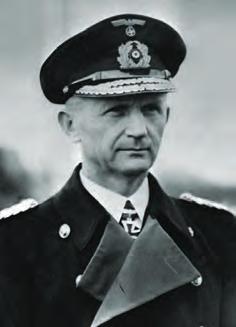
The message’s top-secret content, what the Allies called “special intelligence” or “Ultra”— both meaning intelligence derived from solving high-grade codes and ciphers—reached Com mander Rodger Winn and Lieutenant Kenneth Knowles. Winn of the Royal Navy and Knowles of the U.S. Navy were both middle-aged reservists— so-called “civilians in uniform.” Save for war time manpower exigencies, neither would be serving, even in shore billets. But now Winn, sta tioned in London, and Knowles in Washington, D.C., had to unravel what amounted to a puzzle-within-a-puzzle—one with life-and-death consequences.
German naval charts were overlaid with a system of lettered and numbered grids. U-boats maneuvered according to grid positions, not latitude and longitude. Culling and cross-checking various sources had enabled Allied submarine trackers to piece together much of the Atlantic Ocean grid system. But the Germans greatly complicated
matters, using two letter “substitution codes” that changed frequently. In this case what did the grid reference “TT” stand for? Failure, or even delay, in unlocking the U-boats’ precise destination—and intentions—could spell disaster in the Atlantic.
WITH ALLIED NAVY REGULARS needed at sea, filling backroom intelligence slots with reservists was the only option. But harnessing the disparate skills of attorneys, bankers, journalists, linguists, and mathematicians produced unanticipated benefits. Unbur dened by chain-of-command rigidity, outsid ers could, as one British observer quipped, “resist...cooking raw intelligence to make their masters’ favourite dishes.”
Thirty-seven-year-old Rodger Winn, a successful London barrister, was a case in point. Childhood polio had left him short in stature with a twisted spine and pronounced limp. Rejected for traditional military service, Winn instead became a civilian volunteer. Winn’s legal acumen and German language fluency landed him in the Submarine Track ing Room, a small but vital component of the Royal Navy Operational Intelligence Center (OIC). Winn proved a quick study, earned a reserve commander’s commission, and dis placed his ailing Royal Navy boss.
Tracking enemy submarines depended on
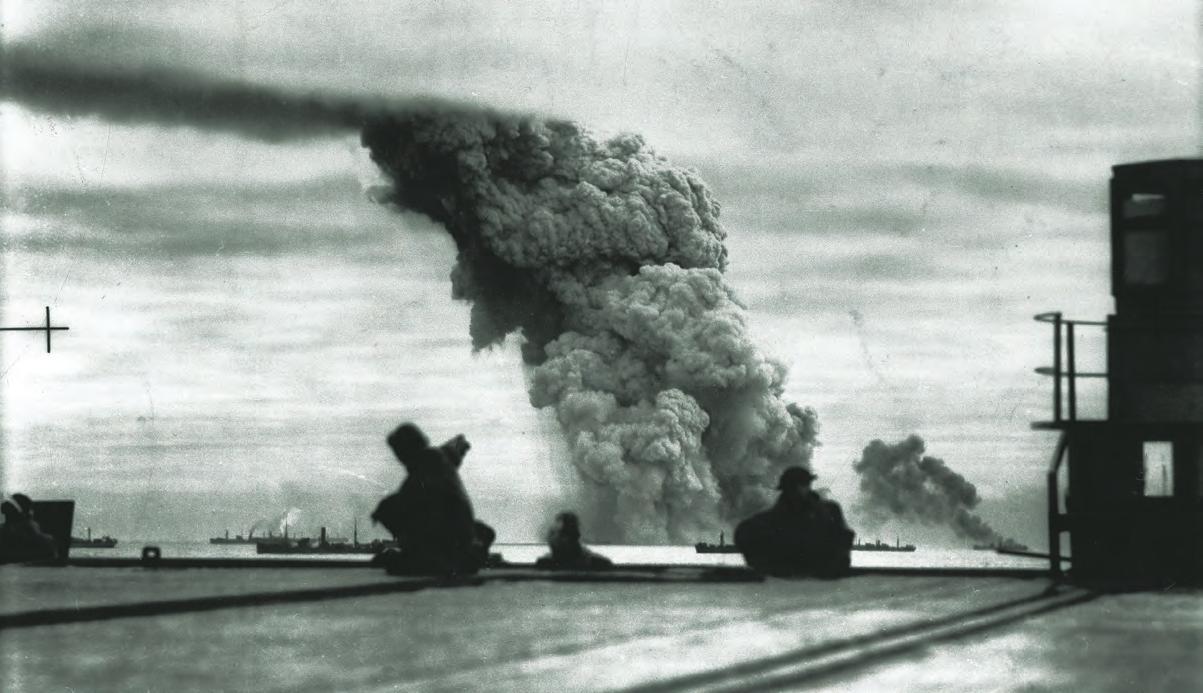
WORLD WAR II40 THIS PAGE (BOTH): ULLSTEIN BILD VIA GETTY IMAGES; PREVIOUS SPREAD: NATIONAL ARCHIVES; INSETS COURTESY OF THE AUTHOR FROM TOP: IWM A 20794; NAVAL HISTORY AND HERITAGE COMMAND
The German U-boat fleet under Grand Admiral Karl Dönitz (below) ruled the Atlantic in the war’s early years. Here Allied ships burn after a U-boat attack in October 1942.
WW2P-230100-BACKROOM-2.indd 40 9/26/22 5:39 PM
signals intelligence, which in turn hinged on intercepting U-boat wireless radio transmis sions. Much has been made of Bletchley Park’s ability to solve Enigma, but Ultra decrypts were often not readily at hand. Whenever the Germans refined Enigma, Bletchley’s experts often “went blind,” as they put it, for a period. And decrypting itself took time—hours, often days, and sometimes weeks. Too often, in fact, decrypted Ultra information could be so outdated as to be use less. Not least, Royal Navy brass, determined not to tip their hand to the Germans, insisted that Ultra be used discreetly—with what today is called “plausible deniability.”
A more reliable sub-tracking tool than Enigma decrypts was Radio Direction Find ing, a technology that determined the direc tion, though not the range, of wireless transmissions. Radio Direction Finding effec tiveness required amassing enough transmissions to perform “resection,” i.e. using the known location of one U-boat to estimate the locations of others. Fortunately for the Allies, Dönitz made it easier for them by microman aging wolfpack operations, sometimes send ing and receiving hundreds of wireless messages daily.
The hub of Rodger Winn’s Submarine Tracking Room, housed in London’s north west suburbs, was an immense square table across which sprawled a chart of the Atlantic Ocean peppered with tiny colored pins—red pins for confirmed U-boat fixes, white for sometimes questionable visual sightings, blue for resected locations. Winn and his three dozen staffers worked around the clock, con fined in a smoky subterranean room they dubbed “Lenin’s Tomb.”
With outward calm, Winn and key deputies sifted through scraps of intelligence, eyed pin movements, and estimated courses, speeds, and distances. Like a chess master, he proved uncanny in anticipating enemy tactics and devising brilliant countermoves. Winn, in fact, became so adept at “evasive routing” (altering convoy paths to avoid U-boats) that higher-ups routinely rubberstamped his recommendations.
Winn’s American counterpart—at first his acolyte—was 38-year-old Kenneth A. Knowles, a bespectacled and reclusive navy reservist. Knowles’s intellect earned him a slot at the U.S. Naval Academy. He excelled academically but fellow midshipman pegged him as “quiet
and unassuming,” and as someone who made friends “rather slowly”—unpromis ing traits if he hoped to climb the ranks.


For a decade after graduation, Knowles followed a normal progression of ship and shore billets. But then, in 1938, still just a lieutenant, Knowles was medically dis charged with vision and hearing problems. Though ousted from his regular navy career, he maintained service ties as the civilian editor for Our Navy, a professional journal with offices near New York’s Brooklyn Navy Yard. Reactivated when war broke out, Knowles nonetheless had to settle for teaching landlocked Navy Reserve Officer Training Corps prospects at the Uni versity of Texas.
Fortunately, during one early shipboard tour, Knowles had caught the eye of Francis “Frog” Low, now a key aide to U.S. Navy Commander-in-Chief Admiral Ernest J. King. Captain Low recalled Knowles’s talent for reducing mountains of information to clear, concise, and actionable recommenda tions. Thus, in late June 1942, when King decided to establish the U.S. Navy’s own Submarine Tracking Room, Knowles was plucked from obscurity and sent overseas to understudy Rodger Winn.
SIMILAR IN AGE, Britain’s Winn and America’s Knowles had both bucked medical headwinds to gain consequential wartime stature. But, with Winn ranked higher and already well-reputed, Knowles’s job was to learn from the master. Admitted to Winn’s tracking room, Knowles observed how intelligence estimates were converted to what Winn called “useful fictions”: educated guesses about U-boat positions, movements, and intentions. Gaining insight into Ultra, Knowles also witnessed how Winn and his bosses used it sparingly.
Allied naval chiefs Lord Dudley Pound of Britain (top) and U.S. admiral Ernest J. King (above) clashed on how to best coordinate their forces and utilize intelligence to counter the U-boat threat.
After returning to the United States in December 1942, Knowles set up his own smaller-scale Submarine Tracking Room—designated F-21—in the Main Navy Building on Washington, D.C.’s National Mall. Though now an ocean apart, Knowles fostered what he considered a “close personal relationship” with Winn. Meanwhile, however, Allied naval brass squabbled over collaboration in the Battle of the Atlantic.
While Britain’s First Sea Lord Dudley Pound doggedly argued for a single unified command under Royal Navy aegis, the purportedly Anglophobic Ernest King just as stubbornly demurred. Not until March 1943, with U-boat savagery cresting, was a compromise forged. In simplest terms, Commonwealth (British and Canadian) navies assumed responsibility for the North Atlantic convoy routes while the U.S. Navy guarded the more southerly Central Atlantic passages.
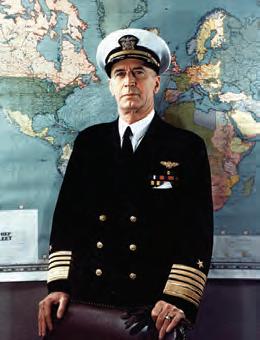
King coupled this new arrangement with an audacious new gambit. “It is arranged,” he announced to fellow American service chiefs on May 1, 1943, “to set up immediately…an antisubmarine command to be

WINTER 2023 41 THIS PAGE (BOTH): ULLSTEIN BILD VIA GETTY IMAGES; PREVIOUS SPREAD: NATIONAL ARCHIVES; INSETS COURTESY OF THE AUTHOR FROM TOP: IWM A 20794; NAVAL HISTORY AND HERITAGE COMMAND
WW2P-230100-BACKROOM-2.indd 41 10/3/22 2:47 PM
known as the Tenth Fleet.” Ostensibly, Tenth Fleet would be a “fleet without ships.” But, under King’s direct authority (delegated to newly promoted Rear Admiral Francis Low), Tenth Fleet could, on the fly, organize and dispatch sea and air task groups to reinforce Central Atlantic convoy routes.
Tenth Fleet’s formation coincided with a crisis point for Dönitz. Before the month of May 1943 was out, over three dozen U-boats would be lost to Allied attacks, most in the North Atlantic. A once favorable exchange ratio had all but evaporated: now, instead of sacri ficing one U-boat for every 100,000 tons of Allied shipping sunk, the rate was one U-boat for every 10,000 tons.
If ever there was reason for Dönitz to with draw from the North Atlantic, this was it. That said, North Atlantic convoy routes remained the Kriegsmarine’s favored hunting ground. It was where Dönitz’s U-boats strove to sink Allied shipping faster than it could be replaced— what he called Tonnagekrieg (“integral tonnage strategy”). The strategy was now doubtlessly faltering, but what countermoves might the always wily Dönitz have up his sleeve?

Though it’s impossible now to reconstruct Winn’s and Knowles’s thought processes as each puzzled over what “TT” stood for, multiple factors came into play. First, because Winn had been reading Ultra messages for 14 months, Knowles for just 5, Knowles had good reason to defer to Winn’s acumen. Moreover, the continuing volume of North Atlantic U-boat message traffic suggested that Dönitz was still committed to this arena.
But there were also reasons for the pair to reach different conclu sions. The reconfiguration of Battle of the Atlantic responsibilities kept each man keenly attuned to the dangers in his respective realm. Moreover, differences were emerging over just how—cautiously or aggressively—to exploit Ultra. As Knowles remarked decades later: “We were more aggressive in our use of Ultra intelligence than the
British and got more mileage from it.”
After deliberation, Rodger Winn projected that the 16 U-boats were bound for a grid area “about 200 miles east of Nova Scotia.” Knowles’s estimate, meanwhile, was grid square “CD 87,” an area 54 sea miles by 54 sea miles “600 miles southwest of the Azores”—a difference of about 1,000 miles.
Now, perhaps for the first time, the acolyte challenged the master. And for good reason. In truth the May 24 signal exposed Karl Dönitz’s deep concern over what even he acknowledged were “unbearable losses.” His immediate response was to distance North Atlantic U-boats from Allied airfields in Nova Scotia and Iceland. And Dönitz was also being pressured to redress Axis setbacks in North Africa by attacking Allied merchant convoys to and from Gibraltar.
Accordingly, the 16 U-boats were indeed bound for CD 87, there to form a wolfpack des ignated Group Trutz (Defiance). Simultane ously, as a ruse, three U-boats stayed behind, transmitting wireless messages meant to con vince the enemy that nothing had changed. The deception apparently worked; as of June 5, OIC still estimated that 20 U-boats lay between Newfoundland and Greenland.
But meanwhile, well to the southeast, Group Trutz was angling to pounce on three Allied convoys: “GUS.7A,” 46 merchant ves sels with 10 combat escorts westbound from Oran, Algeria; “UGS 9,” 79 merchant vessels with 14 combat escorts eastbound from New York City; and, also eastbound, “Flight 10,” 20
WORLD WAR II42 NAVAL HISTORY AND HERITAGE COMMAND NAVAL HISTORY AND HERITAGE COMMAND (BOTH)
Karl Dönitz had deep concern over the U-boat fleet’s “unbearable losses.”
Decrypted German messages were still coded, making the precise location of U-boats a matter of educated guesses. Based on Ken Knowles’s “absolutely uncanny” predictions, the U.S. Navy’s newly formed Tenth Fleet had great success hunting down enemy subs.
WW2P-230100-BACKROOM-2.indd 42 9/26/22 5:39 PM
infantry landing craft accompanied by a refueling tanker. With GUS.7A set to transit grid CD 87 first, Ken Knowles deftly recom mended—and convoy routers promptly agreed—to steer GUS.7A well south of Trutz Prudent “evasive routing.” Only now, Tenth Fleet also went on offense.
JUST THAT APRIL, First Sea Lord Dudley Pound and Ernest King had exchanged testy cables about using Ultra. “We should not risk what is so valuable to us,” Pound tartly chided. King’s riposte: “We are not deriving fullest value from it.”
Underlying King’s impatience were potent advances in antisubmarine warfare capabili ties. Foremost was Tenth Fleet’s growing arsenal of escort aircraft carriers. Nicknamed “jeep carriers” or “baby flattops,” the small aircraft carriers were converted merchant vessels with flight decks capable of accommo dating 15 to 20 single-engine aircraft. Mer chant convoys could now be accompanied by their own air cover.
That March, USS Bogue , one of the first escort carriers, was temporarily loaned to the Royal Navy. Unfortunately, conditions in the North Atlantic made it nearly impossible to conduct flight operations. Bogue ’s aircraft—9 Grumman Avenger torpedo bombers and 12 Grumman F4F Wildcat fighters—lamented a journalist, were “held prisoner in their lash ings by the fogs and gales, the freezing rain and sleet and spray.”

Two months later, Bogue, protected by U.S. Navy destroyers, was operating in more favor able weather and explicitly tasked with hunt ing down U-boats. The ship also carried HF/ DF (High Frequency/Direction Finding, called “Huff-Duff”), a compact version of Radio Direction Finding. Near twilight on May 22, after chasing down a Huff-Duff bear ing, Avengers scored Bogue ’s first U-boat kill, strafing and bombing U-569 until its survi vors scuttled the boat and jumped overboard.
Next, on May 30, Bogue was dispatched to F-21’s best estimate of Trutz ’s current locale. Late on the afternoon of June 4, aided again by Huff-Duff, Bogue Avengers attacked three U-boats, sinking none but damaging two. Then, early on June 5, an Avenger-Wildcat team sank U-217, effectively clearing the path for convoys UGS 9 and Flight 10. Admiral King’s impatience, Tenth Fleet’s capabilities, and Ken Knowles’s growing reputation set the

Grumman Avengers (above) and F4F Wildcats aboard Tenth Fleet’s escort carriers proved critical antisubmarine weapons. Top: Warplanes from USS Bogue attacked and sank U-118, a U-tanker, on June 12, 1943.
stage for a new offensive priority.
Shortly after Knowles established F-21, an unattributed report titled “Offensive Action against U-boats” reached King. It proposed attacking “milk cows”: large refueling and reprovisioning vessels—also called “U-tankers”—that were both vital and scarce (altogether, 10 had been built). “The loss of several,” said the report “would decrease [U-boat] effectiveness out of all proportion.” Scheduling refueling ren dezvous required advanced planning—offering the Americans time enough to act on decrypted Ultra intelligence. Asserted the report’s author: “We are now able to determine up to a week or ten days in advance the exact position of their fueling area.”
The prospect intrigued Knowles. Combing logs of U-boat message traffic, he learned that most refueling rendezvous were set up well beyond the reach of land-based aircraft. The proof of concept came on June 12. Using Enigma decrypts supplemented by Huff-Duff bearings, eight Bogue aircraft ganged up on U-118, expending 14 depth charges and 5,000 rounds of machine-gun ammunition to sink the submarine and capture 17 survivors.
U-118 was a provisional U-tanker, a minelayer pressed into refueling
WINTER 2023 43 NAVAL HISTORY AND HERITAGE COMMAND NAVAL HISTORY AND HERITAGE COMMAND (BOTH)
WW2P-230100-BACKROOM-2.indd 43 9/26/22 5:40 PM


Select U-boats Sunk by Tenth Fleet U-569 U-490 U-118U-549 U-487 U-217 U-488 U-117 U-460 NORTH ATLANTIC OCEAN THE AZORES WW2P-230100-BACKROOM-2.indd 44 9/26/22 5:40 PM
This time, it was Croatan ’s five destroyer escorts that cornered the prey and destroyed it by employing barrages of “Hedgehogs”: projec tiles fired like mortar rounds that, unlike depth charges, exploded only on contact.
A little over a month later, German submariners got their only—and ultimately pyrrhic— measure of revenge. After dark on May 29, while steaming off Portugal’s Madeira Islands roughly 300 miles west of Morocco, escort carrier USS Block Island edged into the crosshairs of U-549, an attack boat bound for Argentina.
U-549 ’s torpedoes dealt mortal blows to Block Island and severely damaged destroyer escort USS Barr. While Barr ’s casualties—28 dead or wounded—were heavy, Block Island’s losses were proportionately minor: 6 sailors from its crew of 957 plus 4 Wildcat aviators forced to ditch and never found. Meanwhile, Hedgehogs from USS Eugene E. Elmore made quick work of U-549
If payback for the loss of Block Island was swift, milk cow extinction was not very far behind. On June 3, when signals intelligence revealed that U-490, the newest and last surviving milk cow, was en route to the Far East, Croatan ’s task group was put on its tail.
Before dawn of June 11, USS Frost—one of Croatan ’s destroyer escorts—detected, attacked, and damaged U-490 with Hedgehog rounds. U-490 ’s skipper, confident in the boat’s pressure reinforced hull, dived to nearly 1,000 feet, well beyond effective depth charge range. There the Germans hoped to outwait the seemingly endless onslaught. Fearing that enemy sonar would detect the squeals of a dozen guinea pigs—brought along by U-490 ’s doctor for experiments—
the skipper ordered them killed.
After midnight, with the siege apparently over, U-490 surfaced, only to be pinned in the glare of searchlights from three destroyer escorts. “SOS please take our crew,” U-490 ’s skipper signaled as he scuttled the craft and its 60 survivors jumped overboard.
DESPITE UNRESOLVED TENSIONS about how best to exploit Ultra, Rodger Winn and Kenneth Knowles achieved a remarkable record. In the estimation of U.S. Naval War college professor David Kohnen, their clan destine expertise contributed to “the ‘liquidation’ of more than 93 Axis submarines,” including “54 to U.S. Navy hunter-killer groups.” After the war, Knowles’s boss Fran cis Low rued the lack of recognition they received: “The Battle of the Atlantic was…a battle of wits in which intelligence played the major role. Unfortunately this…is fully under stood only by a relatively small group because of [its] highly classified nature.”
Both Winn and Knowles ended the war as naval reserve captains. Afterwards, Rodger Winn returned to the law, becoming a Lord Justice before his death in 1968. For his part, Kenneth Knowles, who died in 1986, transi tioned to the National Security Agency, an organization so wrapped in secrecy that its very existence wasn’t revealed until 1975. H

WINTER 2023 45 NAVAL HISTORY AND HERITAGE COMMAND; MAP BY BRIAN WALKER NAVAL HISTORY AND HERITAGE COMMAND
Captain Aurelius B. Vosseller (left) with the USS Bogue’s scoreboard as of October 1944. The two Japanese kills were likely sunk en route to Germany.
Despite tensions, Winn and Knowles achieved a remarkable record of success.
WW2P-230100-BACKROOM-2.indd 45 9/26/22 5:40 PM
BY JIM LAURIER
DUCK AND COVER
BUILT BY THE General Motors Corporation from 1942 to 1945, the DUKW was a six-wheel amphibious truck on a 2.5-ton chassis whose letters stood for (in GMC lingo) the year it was introduced (“D”-1942); its purpose (“U”-Utility); “K” for “all-wheel drive”; and “W” for its dual rear axles. The U.S. military initially rejected the proposed vehicle, but at about that time a U.S. Coast Guard vessel ran aground near Provincetown, Massachusetts, and an early model DUKW that happened to be there was the only available means of saving the seven crewmen. Once in produc tion, the military utilized the versatile vehicle to ferry troops and supplies over both water and land. First appearing at Guadalcanal in late 1942, the DUKW made its European Theater debut on Sicily in July 1943 and went on to support Allied amphibious landings on all fronts, including on D-Day and at numerous river crossings.
Ultimately 21,147 “Ducks” were built; Brit ain received 2,000 through Lend-Lease, as did Australia with 535 and the Soviet Union with 586. Much used in Korea and other con flicts following World War II, DUKWs are now maintained mostly for tourism and other civilian uses.
—Jon Guttman
INSIDE STORY
The vehicle’s interior space could accommodate 5,000 pounds of assorted cargo, or 26 troops. A fold-down canvas top protected the cargo bay from the elements.
THIN-SKINNED
To maintain as light a weight as possible, the DUKW’s exterior steel plates were only between 1.6mm and 3.2mm thick. If the hull was breached while the DUKW was waterborne, a high-capacity pump capable of removing 220 gallons of water per minute helped keep the vehicle afloat.
SIX FEET UNDER
The DUKW was built on the chassis of a 6x6 truck, an all-wheel-drive setup that included two sets of rear tandem tires. As with the trucks they were based on, this six-wheel format helped distribute weight across the axles.

WORLD WAR II46
WEAPONS MANUAL AMERICA’S DUKW AMPHIBIOUS TRUCK ILLUSTRATION
PHOTO: NATIONAL ARCHIVES
WW2P-230100-WEAPONS-DUKW-2.indd 46 9/27/22 3:49 PM
True to its nickname, a “Duck” takes to the water during a July 1943 sea trial. Eventually more than 21,000 of the amphibious vehicles were built.

AMERICAN DUKW


Length: 31 ft. / Width: 8 ft. / Weight: 13,600 lbs. (empty) / Max. speed: 50 mph (road); 6.5 mph (water) / Approximately one out of four DUKWs was armed with a .50-caliber M2 machine gun for antiair craft defense.
THE COMPETITION
AMERICAN FORD GPA
Length: 15 ft. 2 in. / Width: 5 ft. 4 in. / Weight: 2,447 lbs. (empty) / Max. speed: 50 mph (road); 5.5 mph (water) / The DUKW had few real competitors; most comparable vehicles were much smaller, such as the Ford GPA, an amphibious Jeep.



GERMAN SCHWIMMWAGEN

Length: 12 ft. 7 in. / Width: 4 ft. 10 in. / Weight: 2,006 lbs. (empty) / Max. speed: 50 mph (road); 6 mph (water) / Similar in size to the GPA was the Schwimmwagen, an amphibious car built by Volkswagen and used by the Wehrmacht throughout the war.
CONTROL CENTER
The DUKW’s tire pressure could be adjusted from inside the cab to accommodate the various road (or off-road) conditions the crew met, such as soft-sand tracks versus paved roads. It was the first military vehicle to offer this now-widespread feature.

WINTER 2023 47
WW2P-230100-WEAPONS-DUKW-2.indd 47 9/27/22 3:49 PM
THE DAY THE SEA CAUGHT FIRE
Britain devised a system to shoot walls of flames from its shorelines and deter a German invasion. It worked, but not how they drew it up
By Steven Trent Smith
Pools of burning oil blacken the skies over the English Channel as the British test their “flame barrage” defense system against a potential Wehrmacht invasion force.

XXXXXXXXXXXXX
WORLD WAR II48 WW2P-230100-CHANNELFIRE-3.indd 48 9/27/22 7:41 PM

XXXXXXXXXXXXX WW2P-230100-CHANNELFIRE-3.indd 49 9/27/22 7:41 PM
Eight miles north of the White Cliffs of Dover sits Deal, a pictur esque resort town renowned for its pebble beach and classic Victorian buildings. Prewar visitors used to stroll along the beachfront promenade, grabbing an ice cream cone along the way. Others jumped into the bracing sea for a swim. On a clear day, beachgoers could see the coast of France, 25 miles across the English Channel. In June 1940 the frolicking came to a screeching halt after Germany attacked and occupied France. Deal’s storefronts were boarded up. The promenade was festooned with barbed wire. Concrete bunkers popped up along the beaches. Soldiers replaced the tourists.
It had been only a couple of weeks since the Germans had pushed French and British troops into the sea at Dunkirk. During the ensuing evacuation of nearly 340,000 soldiers, the British Army left behind massive quantities of weapons, including 1,500 artillery pieces, 600 tanks, and 60,000 assorted vehicles. Due to these losses Britain found itself, in a very real sense, unable to wage war. Worse yet, the British government faced the real possibility that the enemy would invade England in the early autumn, a plan the Nazis called “Operation Sealion.” (If the Wehrmacht knew how desper ately depleted Britain’s arsenal was, they might have pushed up their timetable.) The defense of the realm was at stake, and the War Office fran tically sought solutions to repulse the onslaught before the Germans could reach English soil. The powers-that-be came to believe the best way to deter the Germans was a stable of flamebased defensive weapons.
Britain’s use of fire in battle dates back cen turies. The Royal Navy, for example, had uti lized fire as a weapon in 1809 when they sailed flaming ships directly at Napoleon’s fleet, pan icking the French and sending them scurrying away in such haste that they collided with one another or ran aground. The British again turned to fire as a weapon of war during World War I.
time what came to be called the “flame bar rage” was accepted, and work began immedi ately on designing a system using a matrix of pipes and pumps capable of generating large floating pools of volatile fuels which, when set alight, spawned hellacious flames and volumi nous dense black smoke.
A new organization, the Petroleum Warfare Department, was created that July under a col league of Lord Hankey’s, oil minister Lord Geoffrey Lloyd. Lloyd was tasked with devel oping a suite of flame weaponry that the Brit ish could install to stop invading Germans. One day soon after, Lloyd called in Brigadier Sir Thomas MacDonald “Donald” Banks, named him director-general of the new outfit, and told him what he wanted: “Flame all across Britain, ringing the coasts, spurting from the hedges and rolling down the hills. We will burn the invader back into the sea.”
Britain’s Lord Maurice Hankey (top) tested flame weapons in World War I. Sir Donald Banks (above) picked up the mantle in 1940 when he became head of the new Petroleum Warfare Department.
In 1914 Secretary of the War Council, Lord Maurice Hankey, conceived of a weapon that could be deployed to set fire to the sea itself. In December of that year, a test conducted by Brit ish petroleum experts, employing a mixture of oils, was attempted at Chatham Dockyard out side London. The success led to another test on the River Ore, northeast of the capital. Hankey was pleased with the results, later writing, “We created a huge blaze which spread out over the river together with great columns of smoke.”
Afterward, Hankey submitted a report on his findings, only to have the Admiralty demur moving forward. The project was shelved.


In the two decades following World War I, the development of new flame weapons in Britain went moribund. When England and France declared war on the Third Reich on September 3, 1939, that changed. Hankey, now a member of the War Cabinet, dusted off his 1914 proposal and, in the spring of 1940, presented it to the chiefs at Whitehall. This
SIR DONALD BANKS, 49, had been in the civil service, attached to the General Post Office since 1909. With the advent of the Great War, he took command of the 10th Battalion Essex Regiment and saw combat in France. There he distinguished himself by leading his troops into the Battle of the Somme, and was subse quently awarded the Military Cross, Distin guished Service Order, and the French Croix de Guerre. After the war Banks returned to the post office. In 1934 he was promoted to direc tor-general and was involved in several wellknown projects, among them the “999” emergency phone system as well as the introduction of the photogenic red telephone boxes that once dotted every corner of the UK. For his labors he was knighted by King George V in 1935. He joined the Air Ministry the following year as permanent secretary with a mandate to explore commercial transatlantic routes with the Americans.

As fears of an autumn 1940 German inva sion of Britain rose, Banks set to work. He quickly assembled a small staff of six and secured three rooms in a Westminster build ing. While design work for the flame barrage shifted into high gear, the Petroleum Warfare Department began to develop other defensive flame weapons of a much simpler nature. The “flame trap” was a country road lined with perforated pipes. At the approach of an enemy convoy, well-hidden operators let the pipes fill with petroleum and set it afire, thus trapping the invaders. The “flame fougasse,” a primitive

WORLD WAR II50 FROM TOP: IWM HU 122828; NATIONAL PORTRAIT GALLERY, LONDON; PREVIOUS SPREAD: IWM D 22933 REUBEN SAIDMAN/POPPERFOTO VIA GETTY IMAGES; INSET: SSPL/GETTY IMAGES
WW2P-230100-CHANNELFIRE-3.indd 50 9/27/22 7:41 PM
improvised flame-spewing mortar, was cre ated by partially burying a 55-gallon steel barrel into the ground and filling it with a flammable mixture. When triggered, a roar of fire would suddenly erupt, reaching up and out 30 yards and more. During the course of World War II, the British manufactured over 50,000 flame fougasse bombs, and the weapon still sees use around the world today.
In late August 1940 the prototype flame bar rage was ready for a trial. Ten oil tankers were parked on a cliff 30 feet above the Solent strait near the Isle of Wight. The fuel mixture, 40 percent gasoline and 60 percent fuel oil, ran down pipes to the shoreline via a gravity feed to sets of nozzles fixed in the sand. On the signal “Fire!” technicians opened the tankers’ valves. The oil floated out a few dozen yards into the Channel and, once pools had formed, the ordnance crew ignited them. Within three minutes the sea was afire along a several-hun dred-foot front, shooting flames 40 to 50 feet high with a core temperature of 1800 degrees Fahrenheit, and pouring out thick, blinding smoke. Soldiers trying to penetrate the fire
barrier would have been incinerated.
So intense was the heat that a group of official observers on the edge of the White Cliffs of Dover was forced to retreat some yards back to cooler safety. Nearby, two young brothers, Paul and John Stone, watched the spectacle in awe. “It was so dense and sticky and black that it actually discol ored the White Cliffs,” recalled Paul.
The British were not the only ones to take an interest in the conflagration. Just two dozen miles across the Chan nel, Wehrmacht soldiers were busy building boats for the planned invasion. They wondered what all the smoke was about, which was “billowing thousands of feet into the blue sky,” Banks recalled in his postwar memoir, Flame Over Britain. So, the enemy sent some planes to check it out. “The next day the offi cial communiqué from Berlin stated that South Coast towns had been attacked with excellent results, with very large-scale fires having been observed,” Banks wrote. Still, the fires both puzzled and worried the Germans.
The English seaside resort of Deal traded beachgoers for soldiers once World War II broke out. Top: Troops wait for a meal at the town’s Clarenden Hotel, where an apparatus of oil tanks, pumps, and piping was later installed in the quest to set the Channel on fire.


WINTER 2023 51 FROM TOP: IWM HU 122828; NATIONAL PORTRAIT GALLERY, LONDON; PREVIOUS SPREAD: IWM D 22933 REUBEN SAIDMAN/POPPERFOTO VIA GETTY IMAGES; INSET: SSPL/GETTY IMAGES
WW2P-230100-CHANNELFIRE-3.indd 51 9/27/22 7:41 PM
August 1940 saw other puzzling and worrying developments for the Germans. Over the course of the month, the bodies of 40 Germans washed up at scattered points along the English coast. Most were airmen shot down over the Channel, some were sailors, but virtually none were soldiers. Former British prime minister Sir Winston Churchill may have described it best in his 1949 history, Their Finest Hour, when he wrote, “This was the source of a widespread rumor that the Germans had attempted an invasion and had suffered very heavy losses whether by
drowning or being burnt in patches of sea cov ered with flaming oil. We took no steps to con tradict such tales, which spread freely through the occupied countries in a wildly exaggerated form.” Spreading those rumors was quite delib erate, and thus began a strange twist to the story of Britain’s flame barrage.
AMONG THE OBSERVERS at one of the flame barrage tests was Major John Baker White, 38, a deception specialist for the Directorate of Military Intelligence, an agency reporting to the British War Office tasked with giving the enemy misinformation about England’s mili tary capabilities. Baker White was an unlikely candidate to be tapped for a role in one of the most restricted departments of the British secret services. During the 1930s the radical right anti-communist was a vocal admirer of Adolf Hitler and the Nazis. The military intel ligence authorities looked askance at his prewar proclivities when they chose him to be one of the “black propaganda boys,” a team of intelligence operatives who efforted to provide the enemy with “fake news.”
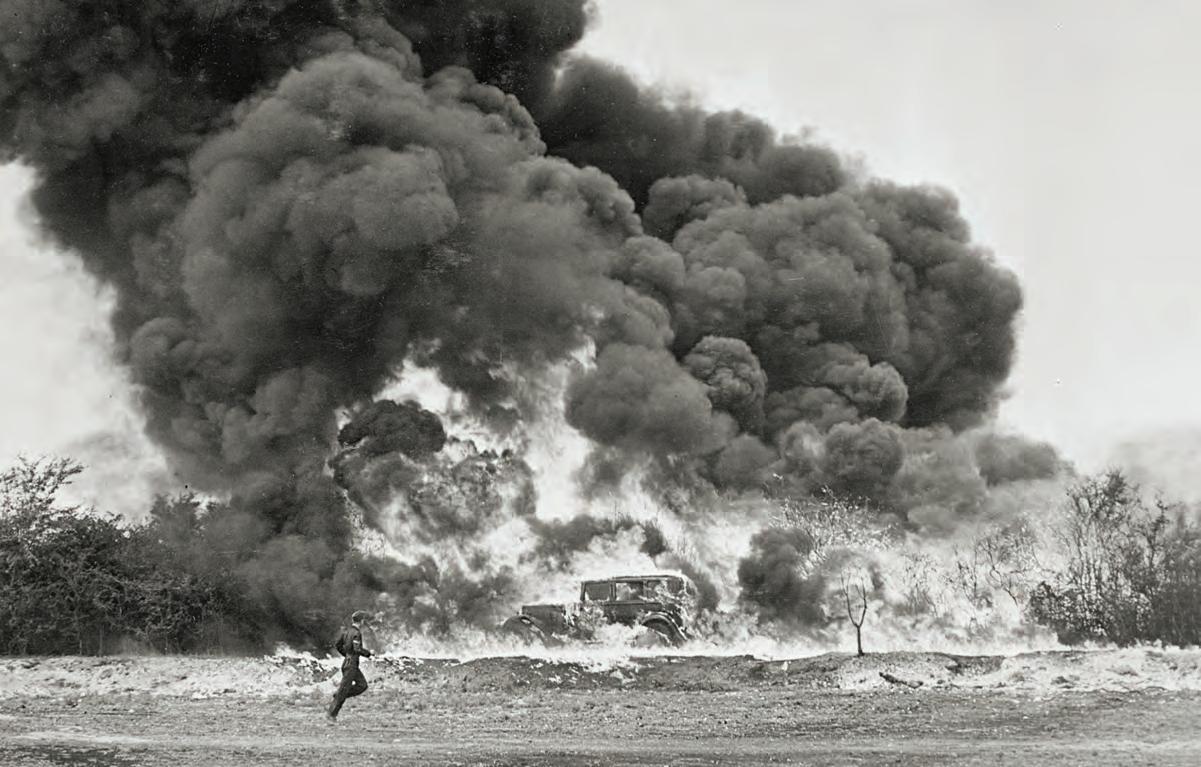
Around 500 BC Chinese military philoso pher Sun Tzu wondered if rumors could be a weapon of war. Decidedly so, reckoned the

WORLD WAR II52 FROM TOP: IWM D 24854; PJF MILITARY COLLECTION/ALAMY NEW YORK TIMES
The coastal flame barrage was only one system of fire-based defense weaponry developed by Banks and his team. The “flame fougasse” involved partially burying a 55-gallon drum of flammable liquid (below). The liquid was then ignited and propelled—with dramatic results. Britain made more than 50,000 fougasse bombs during the war. FUEL LEVEL 55 GALLON DRUM WITH REMOVABLE LID M4 BURSTER FOR IGNITION ELECTRIC BLASTING CAP THREE 2.5 POUND C4 EXPLOSIVE BLOCKS/DETONATING CORD ASSEMBLY PIT UNDER DRUM JUST BIG ENOUGH FOR THREE BLOCKS OF C4 COMPOSITION EXPLOSIVE WW2P-230100-CHANNELFIRE-3.indd 52 10/3/22 2:58 PM
British in 1940. Their concept was to disseminate deceptive informa tion meant to be believable to all who heard them. And that was the crux—who heard them. These rumors were known as “sibs,” a contrac tion of the Latin verb sibilare, “to hiss or whisper,” and were meant to be transmitted orally. Among the rules that soon emerged for a success ful sib: “A good rumor should never be traceable to its source”; “A rumor should be of the kind which is likely to gain in the telling”; and “Rumors are most effective if they can be originated in several different places simultaneously.” British counterintelligence agents in neutral nations, in public places like cafés and hotel lobbies in Lisbon, Madrid, Stockholm, Cairo, and Istanbul, whispered these fabrications to contacts who could be counted upon to spread the lies.
While returning to London from the flame barrage experiment that day, Major Baker White had a sudden revelation for the perfect sib: set ting the sea on fire. Why not form a campaign based upon the man-sear ing flame barrage? As he wrote later, the British should “create in the minds of the German High Command, and of Hitler himself, a com pletely fictitious picture of what they would have to face if they launched an invasion attempt. A picture of a powerfully armed Britain, and above all, armed with new weapons of terrible destructive power. We had to put over the Big Lie.” Baker White put forward his proposal to the decision-makers and awaited a go-ahead.
Meanwhile, at the Petroleum Warfare Department workshops, Banks was organizing the production of both fougasse bombs and flame barrage systems. The work was set back for a time due to a lack of steel and manpower. His team of “wonks” and “boffins” (scientists) made steady progress on increasing the power and burn duration of various fuel mixtures. And down the road, Banks had a cadre of engineers devel oping flamethrower kits that could be mounted to a variety of vehicles that were capable of shooting a stream of fire up to 70 yards.
In late summer 1940 Baker White received approval for the “burn the sea” sib. The brass added a note to their approval: “No objection, but we think it a pretty poor effort.” In spite of that dim view, the flame bar rage propaganda became one of the biggest and most successful of the Big Lies of World War II. Once the Directorate of Military Intelligence agents on the continent were duly informed, the fabrication began to circulate. “Over the next fortnight the rumors seemed to spring up like mushrooms in the dark from all over the place,” wrote Baker White in his 1955 memoir, The Big Lie, adding that, “thanks to the French under ground, the burning-sea tale had already circulated in Paris.” It spread throughout Europe, including Germany, and eventually made its way back to England and across the Atlantic to America. Baker White was amused when a “well-known admiral told me in great detail of the abor tive [German] invasion attempt,” adding that hundreds of charred bodies had been found on Chesil Beach in southern Dorset. “I’ve seen them myself, my boy,” the flag officer told the young major. Baker White had even hoodwinked the Royal Navy.

On September 17, 1940, Hitler suspended Operation Sealion. The main reason for his decision appears to have been Reichsmarschall Hermann Göring’s failure to gain air superiority over Britain. Without control of the skies, the planned invasion could have been a disaster. Some historians believe the rumored existence of the flame barrage might also have played a part in the Führer’s directive. Baker White was sure on that point: “I am convinced that [this] one rumor, [this] one deception, above all others, discouraged the Germans from launch
With the help of British intelligence, fake rumors of the flame weapons’ effectiveness spread. The New York Times got caught passing along the “Big Lie.”
ing their invasion in 1940.”
By the end of the year, the “burn the sea” sib had taken on a life of its own. A headline in the December 15, 1940, edition of the august New York Times blared that Nazi invaders were “‘Consumed By Fire.’ Dead are put at 80,000.” The main sources for author Boris Nikolayevsky were Frenchmen “in a position to know.” The article said two separate inva sions were attempted, the first in August and again in September. Both were reportedly repelled by the burning sea, he wrote. In light of this success, Baker White had good reason to be proud of the persuasiveness of his black propaganda deceits.
So successful was the original sib that the British furthered the fraud by publishing a four-page pamphlet in the form of a helpful tourist conversation guide in German, French, and Dutch. In it a variety of phrases were pre sented. Examples: “What is that strong smell of petroleum?”; “What is setting the sea on fire?”; “Doesn’t the Captain burn beauti
WINTER 2023 53 FROM TOP: IWM D 24854; PJF MILITARY COLLECTION/ALAMY NEW YORK TIMES
WW2P-230100-CHANNELFIRE-3.indd 53 9/27/22 7:42 PM
The British introduced an improved flame barrage system in 1941, successfully setting large pools of oil aflame and generating incinerating temperatures.

fully?”; “Karl is incinerated.” Beginning in February 1941 millions of these leaflets were airdropped on both German-occupied and neutral countries. As Banks later wrote, the falsehood “assisted in weakening the enemy’s will to attack at this most crucial period.”
On still another front, Sefton Delmer, a Ber lin-born Briton, ran black broadcasting opera tions. One of his most successful radio stations was Gustav Siegfried Eins , aimed at Wehrmacht soldiers. Programming was a mixture of popular music, folksy humor, and thinly dis guised propaganda. Tied into Baker White’s efforts was an “English lesson” from Delmer. “Now I will give you a verb that should come in useful. Please repeat after me, “Ich brenne, I burn; Du brennst , you burn; Er brennt, he burns; Sie brennen , they burn.” The whole intent of the broadcasts was to sow doubt among the war fighters. And it worked.
By then the German High Command had
grown anxious about their enemy’s perceived capability to burn the sea. They tried any number of tacks to reduce the danger to their forces. On one occasion they put 50 asbestos-suited soldiers into an invasion barge and sent it into a pool of flaming gasoline. It was a spectacular and costly failure: all the occupants were burned to death. Nevertheless, the Wehrmacht ordered thousands of asbestos suits from a French manufacturer.
At the beginning of 1941, the Petroleum Warfare Department began rolling out a much-improved flame barrage. Under the able direction of Banks, a well-thought-out, well-engineered apparatus was produced. One was set up in the abandoned resort town of Deal; the Clarendon Hotel on the town’s Beach Street, directly facing the Channel, was chosen as a site for the hardware. A pair of well-camouflaged 30 x 9-foot cylindrical fuel tanks with a combined capacity of 48,000 gallons were placed behind the building. Plumbed to them was a powerful pump with a gasoline-powered electric generator. Pipes led down into the cellar, connecting there to a mixing valve which led to a dozen quadheaded nozzles that ran 250 yards outward under the surface of the Channel. They were set up 25 to 30 yards apart across a strip of fore shore some 1,100 feet wide. When the thing was fired up, the flames were blistering and the smoke was profound.
Construction of the sea flame barrages continued apace throughout 1941. On England’s southeastern shores 18 systems were established. Headquarters had originally envisioned a matrix of 150 miles of bar rages along the English coast but ended up with just a few miles, in part because of the diminishing possibility that the Germans would ever
WORLD WAR II54 IWM D 22940 IWM (CH 15271/GETTY IMAGES)
WW2P-230100-CHANNELFIRE-3.indd 54 9/27/22 7:42 PM
actually invade. Still, the gear was kept fully manned and maintained until after D-Day in June 1944.
WITH WORK ON THE BARRAGES continuing apace, in early 1941 Sir Donald turned his full organizational powers toward the creation of offensive flame weapons. Banks’s new mandate was to design and put into service a series of wheeled and tracked flame machines. The result ing first effort was to attach a flame tube to a tracked Bren gun chassis. The vehicle was just 12 feet long but was fast and highly maneuverable. Due to a lack of flame range, the British Army dropped the project, but the Canadian Army picked up the baton and created what came to be known as the Ronson (after the lighter company) Flamethrower. Squadrons of these, dubbed the “Ronson Cavalry,” saw successful ser vice in the European and Pacific Theaters, particularly tank-mounted Ronsons at Iwo Jima.
Banks then led his Petroleum Warfare Department boffins to develop the ulti mate mechanized fire weapon—a large flame gun mounted on the nose of Brit ain’s foremost battle tank, the Churchill Mark IV. This thrower had a range of over 120 yards. In his postwar book, Banks cited several notable actions the Churchill participated in after D-Day, noting that the big flamethrowers “struck terror into the hearts of the Nazi hordes.” In all, during World War II some 10 mil lion gallons of “liquid fire” was expended.

On September 26, 1942, Prime Minister Winston Churchill sent this message to the Petroleum Warfare Department: “It is of great impor tance to find a means to dissipate fog at aerodromes so that aircraft can land safely.” To fulfill Churchill’s command, Banks coordinated the work of experts from diverse organizations. Their labors led to the creation of FIDO (Fog Investigation and Dispersal Operation). Using jets of flame along the sides of runways, thick banks of fog could be dissipated so that aircraft could see the landing strip. Banks later wrote that FIDO helped nearly 2,500 bombers and fighters put down without incident.
The last big project for Sir Donald Banks, now a major general, was the development of PLUTO (Pipe-Line Under the Ocean), a system to
run fuel lines from England to France employ ing flexible oil pipes that unwound from a huge floating cylinder. As the cylinders were towed across the Channel, the pipes sunk to the seabed. Upon reaching the continent they were hooked up to a series of in-ground pipe lines to provide fuel for the rapidly advancing Allies. Banks returned to his civil service job at the Air Ministry in 1945.
In 1943 Major John Baker White was posted to Cairo—a hotbed of Nazi spies and collabora tors—to continue his work as a deception spe cialist. After the war he served eight years in Parliament before taking up writing and lectur ing about the Big Lie—within the strict con fines of the British Official Secrets Act.
With the end of hostilities, Deal awakened from its wartime somnolence. The barbed wire came down, the bunkers were removed, and the flame barrage was parted-out for salvage. Despite a long period of postwar austerity, the little resort town gradually reclaimed its repu tation as a favorite summer haunt for London ers. Today visitors again queue up to buy ice cream from the kiosks or amble down the promenade. On a clear day the coast of France can still be seen clearly 25 miles across the Strait of Dover.
The Clarendon is now a full-service hotel and pub with fine views of the shoreline and Channel. Down in its dank, keg-stacked cellar, there is a square recess in the back wall. Four stubs of steel pipe protrude a few inches—all that remains of one of Britain’s most powerful defensive weapons. Powerful not in a conven tional way, but as a bit of black propaganda that had a profound positive payoff for the British in the early days of World War II. The flame barrage was one of those rare instances where words proved more powerful than deeds. H
WINTER 2023 55 IWM D 22940 IWM (CH 15271/GETTY IMAGES)
In 1942, the Petroleum Warfare Department developed FIDO—“Fog Investigation and Dispersal Operation”—where rows of fire positioned alongside runways helped RAF airplanes land safely in inclement weather.
When fired up, the flames were blistering and the smoke was profound.
WW2P-230100-CHANNELFIRE-3.indd 55 9/27/22 7:42 PM
ON PINS AND NEEDLES
Holocaust survivor Esther Krinitz was a seamstress with a story— one she told via fabric and thread.

Esther Krinitz (née Nisenthal) was born into a Jewish family in Mniszek, Poland, on a farm near the Vistula River. Lacking childhood photos, the Holocaust survivor embroidered the family portrait above for her two daughters. It shows Esther hauling water up a hill toward her house as she’s warmly greeted by her siblings and parents.

XXXXXXXXXXXXX WORLD WAR II56 ALL PHOTOS COURTESY OF BERNICE STEINHARDT/ART & REMEMBRANCE
“MY CHILDHOOD HOME”
WW2P-230100-PORT-QUILTS 2.indd 56 10/5/22 3:38 PM
Esther Krinitz (1927-2001) just wanted her children to know what her home had looked like before the war. It was 1977, and the Holocaust survivor, a 50-year-old dress designer and seamstress in Brooklyn, New York, owned no child hood photos but had a vivid memory and talent to spare: “She had never been trained as an artist,” recalls daughter Bernice Steinhardt. “But she could sew anything.”

Using a large piece of fabric as her canvas, Esther drew the pasto ral village of Mniszek in northern Poland, where she, along with her parents, four siblings, grandparents, and cousins, had lived until genocide upended their lives. She filled inside the lines with embroi dery and fabric scraps and was so pleased with the result that she made a second artwork, this one showing her swimming in Poland’s Vistula River in the 1930s with older brother Ruven.
Stitching these scenes, which she gifted to daughters Steinhardt and Helene McQuade, inspired Esther to document even more rec ollections from her past. She’d go on to create a total of 36 fabric-art segments throughout the next three decades, depicting not just her
relatives and birthplace but her own narrow escape from the Nazis.
Sewn sporadically and in no particular order, the panels nonetheless tell a chrono logical story of Esther and her younger sister Mania, who evaded a Gestapo roundup in 1942 and spent the war’s remainder pre tending to be Catholic farm girls. The two eventually immigrated to the U.S. Their family, tenderly immortalized throughout Esther’s series, wasn’t so fortunate: they likely perished at concentration camps.
Here and on the following pages are a sampling of Esther’s artworks, all on view in the exhibit “Esther and the Dream of One Loving Human Family” at Baltimore’s American Visionary Art Museum through March 3, 2024. —Kirstin Fawcett
XXXXXXXXXXXXXALL PHOTOS COURTESY OF BERNICE STEINHARDT/ART & REMEMBRANCE
“THE NAZIS ARRIVE” Life changed forever for Esther Krinitz’s family when the Nazis entered her Polish village on horseback in September 1939. Esther, shown here at age 12, watched from afar with friends as the men rode up to her grandparents’ home. A soldier dismounted and, approaching her grandfather, sliced off his beard.
WINTER 2023 57 WW2P-230100-PORT-QUILTS 2.indd 57 9/26/22 5:12 PM
ON PINS AND NEEDLES
“THE SOMBER DEATH MARCH”
On October 15, 1942, following three years of rising persecution, the Gestapo ordered all Jews in Mniszek and neighboring Rachow (today Annapol) to depart for Krasnik railroad station. Esther and Mania (below right) didn’t join them, waving goodbye as their family’s wagons rolled away toward an uncertain future. Their farewell that day wound up being final.
“STEFAN’S HOUSE”
Esther and Mania had an escape plan in place: their mother had paid a neighbor to take them to Dombrowa, Poland, where their father’s friend Stefan lived. After the escort abandoned them, the siblings headed to Stefan’s home on their own. But while initially welcoming, he soon cast them out into the forest (below right). Mania and Esther remained on the run until early November, when they arrived at the village of Grabówka and found work by pretending to be Catholic farm girls.


XXXXXXXXXXXXX
WORLD WAR II58
WW2P-230100-PORT-QUILTS 2.indd 58 9/26/22 5:12 PM
“THE BEES SAVE ME” Esther received help from an unlikely ally in June 1943 while gardening at a farm in Grabówka. Two Nazi soldiers approached and wanted to talk; afraid they’d discover her true identity, she remained silent as a cloud of honeybees swarmed the men and drove them away. “Why aren’t they stinging you?” they asked Esther’s employer, an elderly man named Dziadek, who stood by observing the one-sided exchange.

“I DREAM OF GRANDFATHER” Esther experienced a powerful dream in 1944 while in hiding, one that made such an impression she rendered it in fabric 45 years later. The scene unfolded inside her grandfather’s house; knowing he’d died three years prior, Esther said to him in the dream, “Oh Zayde, you are close to God! You have to help me!” “Don’t worry, Esther,” he replied. “You will cross the river and you will be safe.”

XXXXXXXXXXXXX
“Don’t worry, Esther,” grandfather said. “You will cross the river and you will be safe.”
WINTER 2023 59
WW2P-230100-PORT-QUILTS 2.indd 59 9/26/22 5:12 PM
Esther and her sister Mania left hiding in July 1944 after the Russian Army liberated Grabówka. They visited their home village, Mniszek, and then Maidanek death camp in search of surviving kin. The artwork below shows the crematorium director’s house, now a charred mound of rubble; its showers and gas chambers; and, in the distance, cabbage crops fertilized with human remains. “I looked through the piles of worn shoes but they all looked the same,” Esther later recalled.

“MAIDANEK”
WORLD WAR II60 WW2P-230100-PORT-QUILTS 2.indd 60 9/26/22 5:13 PM
ON PINS AND NEEDLES
“THE WAY TO BERLIN”
As her grandfather foretold in her dream, Esther wound up crossing a river to safety. In March 1945, she and Mania accompanied a Polish army unit that, along with the Russian Army’s Fifth Division, drove over the Oder River into Germany, passing executed Nazi officers along their route. The two later sought refuge in the village of Ziegenhain, at the displaced persons camp where Esther would meet and marry husband Max Krinitz in 1946.
HOMECOMING
In 1999, Esther returned to Poland with her extended American family for the first time since the war. Her health declined following the trip, and in 2001 she died at age 74. Since then Esther’s art has been exhibited by museums and organizations around the world. It can also be viewed online via the family-run Art & Remembrance, a D.C.-based educational and arts nonprofit (artandremembrance.org).


WINTER 2023 61
WW2P-230100-PORT-QUILTS 2.indd 61 10/3/22 2:45 PM
GOLDEN
GIRL
Young and glamorous, wealthy socialite Mary Jayne Gold bucked first impressions to help thousands of refugees escape Vichy France
By Gavin Mortimer T
here were terms for rich young women like Mary Jayne Gold in the United States of the 1930s. Newspapers routinely derided her type as “Lisping Lulus” or “Nice Nellies,” the perfect companions for the “Lounge Lizard” young men who seemed the antithesis of the tough Doughboys of the First World War.
Born in Chicago in 1909, Gold was the granddaughter of the man who invented the first cast-iron radiator, and the family grew wealthy from manufacturing steam heating systems. She came of age in the late 1920s, the decade of jazz and “flappers,” where young women enjoyed social freedom unknown to previous generations. The Great Crash of 1929 didn’t inhibit the carefree lifestyle of women like Gold, who, despite her surname, was not Jewish.
The war’s onset ended the easygoing lifestyle of Mary Jayne Gold, a Parisbased American heiress who became a vital cog in a refugee rescue group in southern France.
She relocated to Europe in the 1930s, settling in Paris, the city glamorized for Americans in the 1920s by the likes of Ernest Hemingway and Josephine Baker. Gold bought a large apartment in the chicest quar ter of the French capital and invested in a Percival Vega Gull aircraft. A contemporary recalled that she would “toot around Europe, she would fly to Switzerland for the skiing and to the Italian Riviera for the sun.”
Life was swell for Mary Jayne Gold, but the idyll ended in September 1939 when France and Britain declared war on Nazi Germany. “You felt it was the end of the world, that everything you believed in and everything that had been built up by
WORLD WAR II62 VARIAN FRY INSTITUTE
WW2P-230100-MARYJAYNEGOLD-2.indd 62 9/26/22 5:21 PM

VARIAN FRY INSTITUTE WW2P-230100-MARYJAYNEGOLD-2.indd 63 9/26/22 5:21 PM
Gold left Paris in 1940 and headed for the bustling Mediterranean seaport of Marseille (top), where she hoped to catch a boat back to America. En route, she met Miriam Davenport (above), who became a close friend and introduced her to the Emergency Rescue Committtee (ERC), an aid organization funded by notable Americans—and eventually Gold.
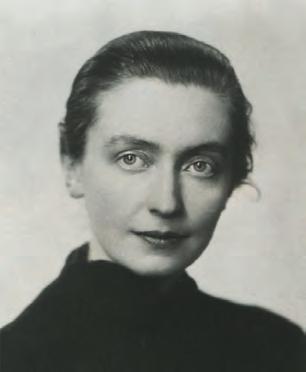

humanity or decency for centuries was finished,” she reflected in an interview with the French documentary-maker Pierre Sauvage in the 1990s. “And yet, there was another part of me that said, “We’re going to beat ’em.”
Shortly after the outbreak of war, Gold donated her aircraft to the French air force as a contribution to the war effort. Then, like every other person in France, Gold experienced eight months of what is often described as the “Phoney War,” the period of eerie calm in Western Europe, which was shattered in May 1940 when the Germans invaded the Low Countries. Gold joined the exodus out of Paris, one of an esti mated two million refugees who fled the capi tal for the assumed safety of the countryside. Gold’s intention was to head 500 miles south to the Mediterranean port of Marseille and from there catch a ship home. “There didn’t seem much point in staying on,” she reflected.
But en route to Marseille, Gold had an encounter that would change her mind, and her life. In the southern French city of Tou louse, which was an assembly point for Euro pean refugees, Gold was introduced by a mutual acquaintance to Miriam Davenport, a native of Boston who had been studying in Paris. Davenport and Gold hit it off at once. Davenport appreciated her new friend’s “splendidly relaxed, no-nonsense air,” and she recalled what Gold told her on that first encounter: “That she was a rich woman and that should I run short of cash, she would love to help out. She was planning to go fetch her
little dog from where she had left him on the flight south, then go on to Marseille where she would cable home for money and return to the States.”
Neither Gold nor Davenport left France. They reached Marseille, but once there they decided against returning to the States and instead joined a cause that was virtuous but dangerous, and wildly at odds with their pre vious privileged and untroubled existence.
MARY JAYNE GOLD was in the habit of attracting attention with her stylish confi dence. Women like Miriam Davenport were struck by her sartorial elegance, and men by her beautiful blonde looks. In Marseille, Gold soon encountered a young Frenchman named Raymond Couraud. It was love at first sight. “I immediately became involved with a young deserter from the Foreign Legion,” recalled Gold. “He and I started a little flirtation for each other, we were keen on each other.”
Couraud was, in fact, half-American, the fruit of a union between a Frenchman and an American woman. They had married in New York in 1919, and Raymond was born in France the following year. Shortly after he turned 18, Couraud enlisted in the Foreign Legion, and in April 1940 his brigade was shipped to Norway to fight the invading Germans. He was awarded the Croix de Guerre for his cour age and initiative during the fighting.
After the fall of France, Couraud had been posted to a Legionnaire camp just outside Marseille, but he was disgruntled with the prospect of serving the Vichy regime. “He said he wasn’t going to go back to Algeria [the main Legion base] to make roads for the bloody Vichy,” remembered Gold. “He persuaded me that I should buy a small trawler that he could sail to Gibraltar with twelve other Legion naires, who also wished to desert, and con tinue the fight from England.” Gold had by now endowed Couraud with a nickname: “Killer,” on account of the way “he murdered the English language.”

Couraud certainly didn’t resemble a physi cal killer. Of slim build with spectacles and a grave countenance, Couraud looked more like one of the many bureaucrats in Marseille trying to deal with the throngs of refugees arriving each day in the port. There was also a more sinister side to Couraud that began to emerge in Marseille as he slowly shed the dis cipline instilled in him by the Foreign Legion.
FROM
FROM
WORLD WAR II64
TOP: GAMMA-KEYSTONE VIA GETTY IMAGES;
UNITED STATES
HOLOCAUST MEMORIAL MUSEUM, GIFT
OF MIRIAM DAVENPORT
EBEL
TOP:
UNITED STATES HOLOCAUST
MEMORIAL
MUSEUM, GIFT OF MIRIAM DAVENPORT EBEL; UNITED STATES HOLOCAUST MEMORIAL MUSEUM, COURTESY OF ANNETTE FRY
WW2P-230100-MARYJAYNEGOLD-2.indd 64 9/26/22 5:21 PM
He was vain and selfish, a thrill-seeker who thrived in a combat theater but who, deprived of action and excitement, quickly became restless and reckless.
Gold agreed to fund her lover’s audacious plan to buy a boat and sail to the British territory of Gibraltar, on the southern coast of Spain. But before the scheme could be launched, Couraud was arrested by the Legion for desertion and locked up in Marseille’s military prison in August 1940.
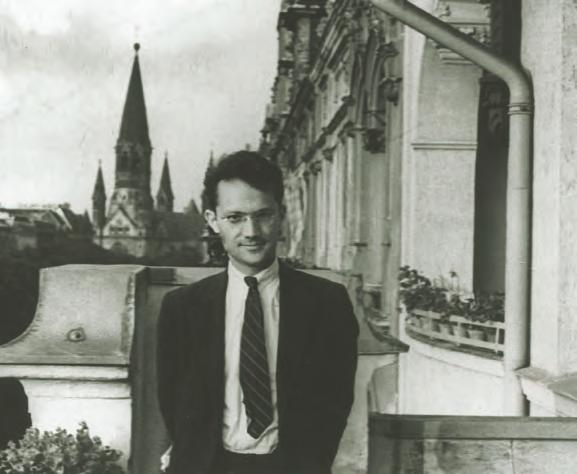
Davenport was relieved. She considered the Frenchman a malign
Davenport (center left) and Gold (center right) enjoy a meal in Marseille. Next to Gold is Raymond Couraud, nicknamed “Killer,” a deserter from the French Foreign Legion with whom she started a romance. Soon Gold met Varian Fry (left, in Berlin in 1935), who led the ERC in Marseille.

influence on her friend, and without Couraud to lead her astray, Gold would be a heartening companion in a time of tension and uncer tainty. The pair met for lunch, and Davenport told Gold she had decided to remain in Mar seille and try in some way to help the Jewish refugees who were becoming increasingly anxious to escape to America. She knew she could confide in Gold, who was “passionately anti-Nazi…. Even her poodle, Dagobert, would bark furiously whenever one muttered ‘Hitler! Hitler!’”
They wrote to a contact in the U.S. consul ate in Marseille, “expressing our interest in being helpful to refugees. In return we got a curt reply; he had all the help he needed, thank you.” A similar approach to the Ameri can Red Cross was also unsuccessful.
One day in the middle of August 1940, Dav enport and Gold were having coffee in their favorite café, the Pelikan, close to the U.S. consulate, when, as Davenport recalled, they heard gossip that an American with “money,
WINTER 2023 65 FROM TOP: GAMMA-KEYSTONE VIA GETTY IMAGES; UNITED STATES HOLOCAUST MEMORIAL MUSEUM, GIFT OF MIRIAM DAVENPORT EBEL FROM TOP: UNITED STATES HOLOCAUST MEMORIAL MUSEUM, GIFT OF MIRIAM DAVENPORT EBEL; UNITED STATES HOLOCAUST MEMORIAL MUSEUM, COURTESY OF ANNETTE FRY
WW2P-230100-MARYJAYNEGOLD-2.indd 65 9/26/22 5:21 PM
Refugees line up outside Marseille’s American consulate in hopes of obtaining a visa. The ERC provided financial aid and critical documents to the displaced, most of them Jews or political enemies of the Nazis.

access to visas, and a list of people he was supposed to rescue” had recently arrived in Marseille and was staying in the Hotel Splendide. The name of the American was Varian Fry.
Davenport went to see Fry the next day with a list of artists and intel lectuals who had angered the Nazis and were now in Marseille looking for passage to America. Among the names men tioned by Davenport were the satirist Walter Mehring, whose political poems were favorites of the raucous Berlin cabarets so detested by the Nazis; Hitler’s biographer, Konrad Heiden; and the German novelist Heinrich Mann.
Fry was impressed with Davenport. She was as well-organized as she was well-connected. “Would you be willing to be named Secretary General of a committee that we are planning to set up?” he inquired. He could pay her 750 francs a week (approximately $17, or $340 today), and in return she would help interview some of the hundreds of refugees to determine who were genuinely at risk from the Nazis.
A married man, the 32-year-old Fry was an ardent anti-Nazi (and also anti-Communist) and one of the first American journalists to warn of what was taking root in Germany, having visited Berlin in 1935. On witnessing one anti-Jewish demonstration, he wrote an arti cle for the New York Times in which he described the indiscriminate violence meted out to Jews and the indifference of the German police.
As Germany invaded the Low Countries and France, he anticipated the refugee crisis, and in June 1940 Fry and 200 prominent Americans from the world of arts and academia formed the Emergency Rescue
Committee (ERC). First Lady Eleanor Roos evelt was approached that same month. She endorsed the ERC and also used her influence to procure a number of emergency visas for endangered refugees.
Fry arrived in Marseille in early August 1940 with the visas as well as $3,000 and a list of approximately 200 refugees to rescue, most of whom were Jews. What Fry didn’t possess were contacts, which was why he jumped at the chance to recruit Davenport to his cause.
He was less impressed, however, the first time Davenport introduced him to her friend, Mary Jayne Gold. Intense and earnest, Fry initially sized up Gold as a woman without substance. “She’s just another rich playgirl, probably one with a passion for dukes and duchesses and whose friends are ultra-reac tionary,” he told Davenport.
The distaste was mutual. “He was stiff and standoffish…and rather dry and clipped in his conversation,” recalled Gold. “Miriam had praised him to the heavens. I told her he looks like a Salvation Army captain.”
DAVENPORT WAS DETERMINED to find a role for Gold in the ERC, and eventually she persuaded Fry to give her friend a second chance over a coffee. “I made a few remarks
WORLD WAR II66 UNITED STATES HOLOCAUST MEMORIAL MUSEUM, COURTESY OF HIRAM BINGHAM FROM TOP: UNITED STATES HOLOCAUST MEMORIAL MUSEUM; FRED STEIN ARCHIVE/ARCHIVE PHOTOS/GETTY IMAGES
Thousands of refugees were milling about Marseille in need of rescue.
WW2P-230100-MARYJAYNEGOLD-2.indd 66 9/26/22 5:22 PM
about the evil of the fascists and Anti-Semi tism and all that,” remembered Gold. “I was putting my best liberal foot forward not to be this supercilious playgirl who was trying to infiltrate the committee with money.”
Gold won over Fry, who wrote after the war that she was “a made-to-order charmer… young, blonde, and beautiful,” and he believed such a vivacious character might be an asset in circumventing the notorious French bureaucracy with her “feminine wiles”—but admitted that the main reason he accepted her into the ERC was her money.
It hadn’t taken long for Fry to appreciate that there were far more than 200 refugees in need of rescue. There were thousands milling about Marseille, most without the financial means to pay for passage out of France. “As the days wore on I became more and more depressed by the number of endangered people who deserved help but were unknown to the old-boy network,” said Davenport.
Fry wanted to broaden the ERC, but to do that required money: Gold’s money. She gave the ERC an initial sum of $3,000 (approxi mately $60,000 today) to establish what Dav enport called the “Gold List,” dedicated to helping the poorer refugees.
Gold’s financial and moral commitment to the ERC soon became invaluable, as Fry explained in a letter to his wife in 1941. “It would be hard to find a better person for the job we had in mind than M ary Jayne,” he wrote. “She has already given us thousands, and she is more interested in our work than anyone else I know.”
Gold joined Davenport in the ERC office in downtown Marseille. Each day they inter viewed dozens of refugees who were desperate to leave France. “You would ask if they had their documents and then ask if they were valid, same with visas,” recalled Gold. “Then you had to ask the 64-dollar question: ‘What have you done to put you in danger with the German authorities?’”
It was the first time in her life Gold had encountered humanity in its most wretched and vulnerable state. “The interviews were touching in a way,” she reflected. “These people, some were very simple, but they were very brave. They hadn’t written books or painted pictures…the people I interviewed were rank and file.” They were German stu dents who had voiced their opposition in lec ture halls to Hitler, Austrian trade unionists
who had given out tracts in the street, or simply Jews from any number of European countries now under the Nazi yoke. But Gold and the other interviewers could not let emo tions cloud their judgment. Only those consid ered most at risk were given visas, and Gold became accustomed to the look of bitter disap pointment on the faces of those turned away.
One of the first prominent refugees to leave was the satirist Walter Mehring, who set off for Portugal in September 1941 with an Amer ican visa and a forged Czech passport—but still wearing the tattered clothes in which he had traveled across Europe. As he had a drink in a café in Perpig nan, a French city close to the Spanish border, Mehring was detained by a plainclothes policeman who thought he looked suspicious. Unable to pro duce a safe-conduct pass, Mehring was held in an internment camp pending further inquiries. Fortunately, he got word to the ERC, and Fry dispatched a lawyer—paid for by Gold’s money—to secure Mehring’s release. “It had been our fault for not seeing to it that Meh ring was properly dressed for his jour ney to freedom,” reflected Davenport, who was “instructed to go shopping with him to make sure that he was dressed like a gent.”

Mehring eventually made it across the border, as did an increasing number of refu gees in the fall of 1940. But the Vichy French
Gold’s influence in the ERC grew. She suggested to Fry that he hire Daniel Bénédite (above, left), a Frenchman with sharp administrative skills who eventually took over the committee. One refugee the ERC helped escape was Walter Mehring (below) a renowned German satirist and enemy of the Reich.
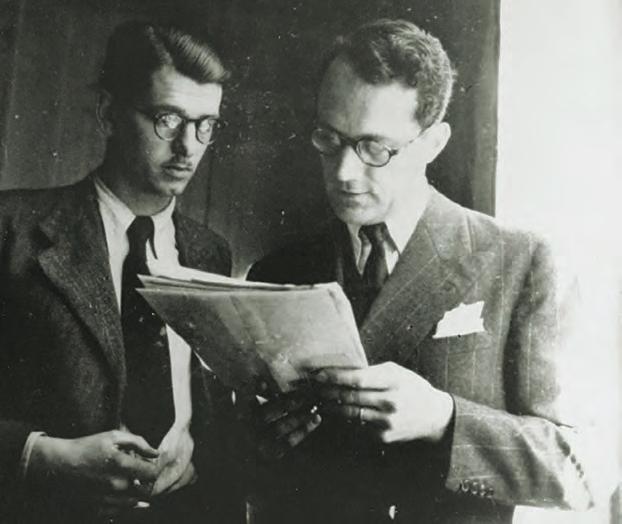
WINTER 2023 67 UNITED STATES HOLOCAUST MEMORIAL MUSEUM, COURTESY OF HIRAM BINGHAM FROM TOP: UNITED STATES HOLOCAUST MEMORIAL MUSEUM; FRED STEIN ARCHIVE/ARCHIVE PHOTOS/GETTY IMAGES
WW2P-230100-MARYJAYNEGOLD-2.indd 67 10/3/22 2:52 PM
authorities were now aware of the ERC’s activity and lodged a com plaint with the U.S. consulate. Fry was summoned and shown a com munication from the State Department, which had been received via the embassy in Vichy. Reflecting the fact that America was still techni cally neutral, it stated: “This government cannot countenance the activities as reported…in evading the laws of countries with which the United States main tains friendly relations.”
The Vichy regime also pressured neutral Spain and Portugal to be more proactive in stopping the steady stream of refugees arriv ing from France either by boat or foot. As a result it became harder for the ERC to obtain visas for these countries.
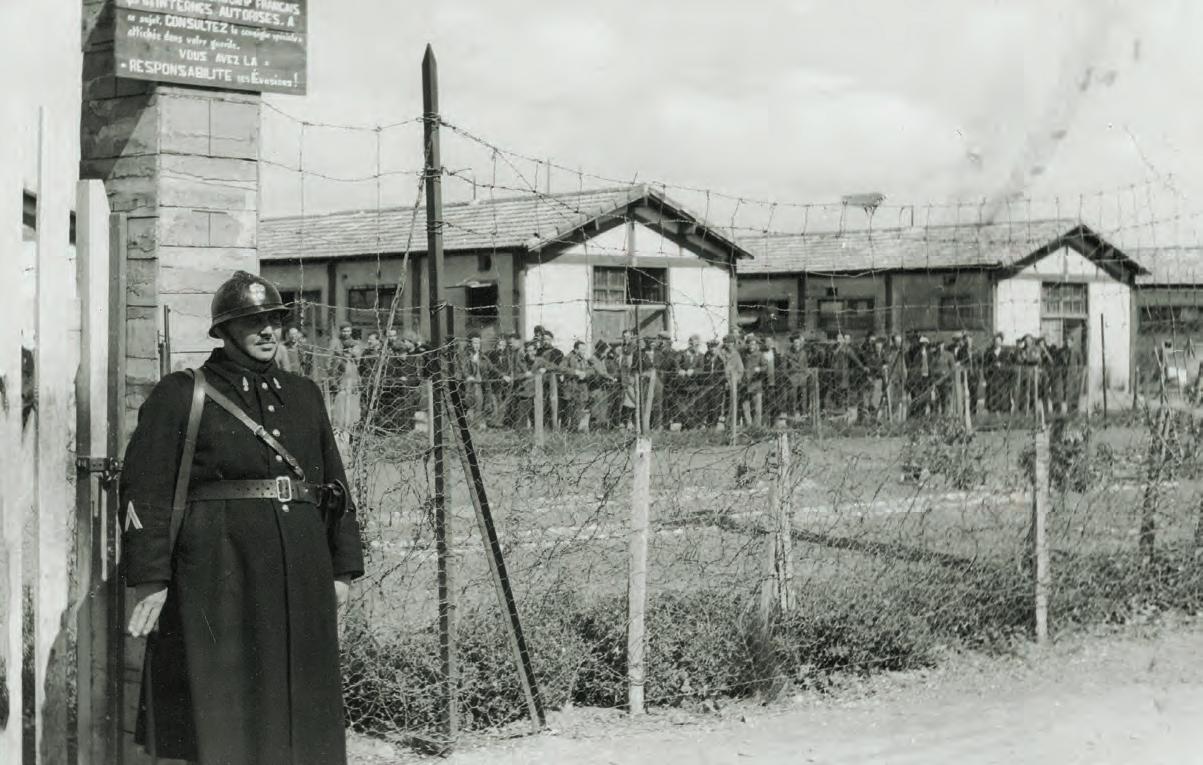
Then Britain came to the aid of the ERC. Scores of British soldiers stranded in France after the German Occupation had made their way south and were hiding in Marseille and the surrounding countryside, looking for a way to get into Spain and eventually back home Sir Samuel Hoare, Britain’s ambassador to Spain, asked for Fry’s assistance in getting the soldiers across the border, and in return his government donated $10,000 to his organization.
The ERC was aware it was under surveillance from the French authorities, so, in October 1940, Gold rented a large villa a few miles outside Marseille. The villa was secluded, lacking even a telephone, and it became a haven for staff and some of the refugees. That same month, Fry accepted onto the staff a Frenchman, Daniel Bénédite,
whom Gold had recommended to the ERC— an indication of the esteem in which she was now held by Fry. “Danny had worked in the prefecture [so] he knew the officialese lan guage,” remarked Gold. “He could write let ters in the proper way to any official person that Fry had to deal with. He knew the lingo and how to behave.”
For several months Gold’s money and her diligence had contributed greatly to the ERC’s success in smuggling hundreds of refugees out of France. It had helped that her lover, Ray mond Couraud, had been languishing in a military prison. But he was released in December 1940, and the infatuated Gold soon fell under his malign influence once more.
Couraud had no intention of shipping out to Vichy-run Algeria with the Foreign Legion. He deserted for a second time but, this time, joined a Corsican gang involved in the Mar seille underworld.
“For a short while, I hoped he would work in the illegal activities of the ERC but Killer just hated all those intellectuals,” reflected Gold. The antipathy was mutual. Asked to make a choice, Gold chose her heart over her head. “I was forced to withdraw from the more noble enterprise and so became a gang
WORLD WAR II68 GABRIEL HACKETT/ARCHIVE PHOTOS/GETTY IMAGES UNITED STATES HOLOCAUST MEMORIAL MUSEUM, COURTESY OF DYNO LOWENSTEIN
One of Gold’s riskiest assignments was traveling to a French concentration camp and securing the release of four German prisoners before the Gestapo discovered their whereabouts.
The ERC was aware it was being watched by the Vichy French authorities.
WW2P-230100-MARYJAYNEGOLD-2.indd 68 9/26/22 5:22 PM
ster’s moll of sorts,” she admitted.
Gold’s love blinded her to the true character of Couraud until he stole her diamonds. She came to her senses and dumped the Frenchman. “Realizing that he was now more or less washed up with me…he decided it was time he left for England to continue the good fight,” said Gold.
The ERC was only too pleased to get Couraud out of France and out of Gold’s life. The committee facilitated his pas sage into Spain and then on to Britain, where he joined the commandos and was later commissioned into the Special Air Service [SAS] regiment, the elite British unit whose expertise was in daring raids behind enemy lines. With the SAS he again demonstrated his Jekyll and Hyde character; he was deco rated for gallantry by the British but eventually dismissed from the regiment for disobeying orders.
WITH COURAUD GONE , Gold was no longer conflicted, and she undertook a perilous mis sion on behalf of the ERC to a concentration camp close to the Spanish border. The camp, Le Vernet, held thousands of “undesirables,” mainly foreign men considered a threat to public order. Among their number were four Germans who were on Fry’s list to receive American visas, which were waiting for them at the consulate in Marseille. The challenge was how to get the quartet out of the camp. Fry asked Gold to deploy her “feminine wiles” on the camp commandant, a Frenchman with a reputation as a ladies’ man. “I was rather ner vous about the whole thing,” admitted Gold, who nonetheless dressed in her most stylish outfit and took a train to the camp. She capti vated the commandant from the first moment, and he readily agreed to release the prison ers—but on one condition. “He asked me if I would have dinner with him…he said he knew a little restaurant and he would pick me up.”
Gold accepted the invitation, but the com mandant never showed. Unaccustomed to being stood up, Gold returned to the concen tration camp and was met by the apologetic Frenchman, who told her: “Mademoiselle, I can assure you I would rather have had dinner with you but I had to dine with the Gestapo.”
Gold knew that the four prisoners were wanted by the Gestapo. She had to act fast and
began examining the prisoners’ files. She feigned disappointment at the canceled date, and the chivalrous commandant, embarrassed that he had upset a lady, ordered the immediate release of the four men as a token of his esteem.

Gold remained with the ERC throughout the summer of 1941. Twice she was arrested, once with Fry, and eventually Vichy French authorities expelled the pair, with the tacit support of the U.S. State Department, in September 1941. They returned to the United States, as did Miriam Davenport, who had left Marseille in late 1940 to fetch her sick fiancé from Yugoslavia. The Vichy government refused to grant them a visa to return to France, and they were forced to wait in Portugal before eventually securing passage across the Atlantic in December 1941.
A group of refugees sail west from Marseille to freedom across the Atlantic. With direct help from Gold and the ERC, thousands were able to escape the perils of Vichy France.
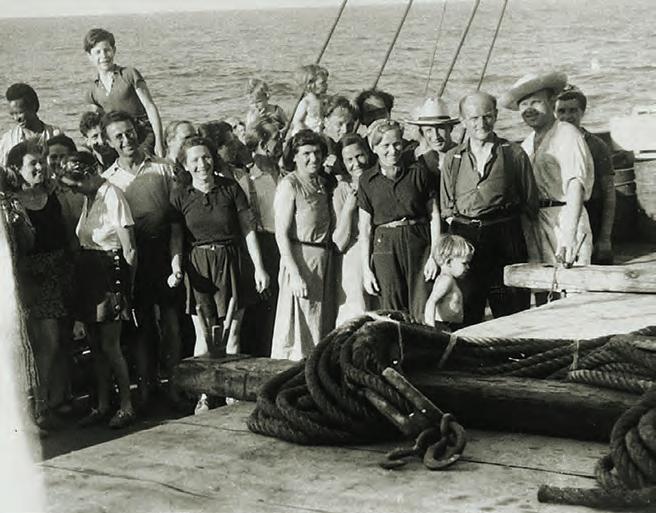
Danny Bénédite and his English wife, Theodora, took over the com mittee, moving its headquarters to the countryside but continuing to facilitate the escape of refugees from France. In total an estimated 2,000 refugees escaped the Nazis through France thanks to the work of the ERC.
Postwar life was anticlimactic for both Fry and Gold. Fry divorced and remarried and divorced again, moving to work at a Connecticut high school where he taught Latin and Greek. Shortly before his death in 1967, Gold wrote to him and concluded her letter by saying, “Well, we shared our finest hours, my friend.”
Gold, who never married, died at her home in Saint-Tropez on the French Riviera 30 years later, in her 88th year, two years before Miriam Davenport, with whom she had stayed in regular contact. For the pair, their months in Marseille had been the most meaningful of their lives. It would be an exaggeration to say that they risked their lives to help smuggle refugees out of France, but they certainly risked their liberty. In a war of shocking inhumanity, these two young women demonstrated that conflicts are often won by compassion as well as courage. H
WINTER 2023 69 GABRIEL HACKETT/ARCHIVE PHOTOS/GETTY IMAGES UNITED STATES HOLOCAUST MEMORIAL MUSEUM, COURTESY OF DYNO LOWENSTEIN
WW2P-230100-MARYJAYNEGOLD-2.indd 69 10/3/22 2:54 PM
Colditz Castle, the Renaissance fortress-turned-POW camp in Saxony, became legendary postwar for its many attempted Allied prisoner escapes.

BOOKS
CASTLE IN THE SKY
BRITISH AUTHOR Ben Macintyre has an unerring talent for unearthing familiar tales and retelling them in new and captivating ways. He has demonstrated this ability many times with World War II spy histories such as Rogue Heroes (2017), Double Cross (2012), and Operation Mincemeat (2010)—all books I liked well enough. But his latest page-turner, Prisoners of the Castle, trumps them all.
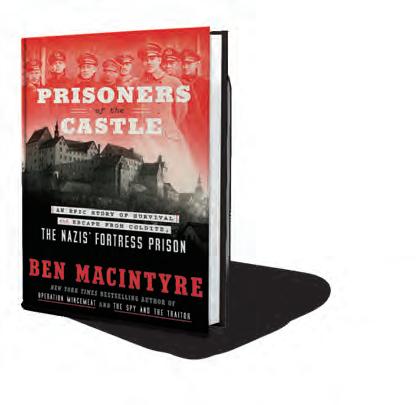
PRISONERS OF THE CASTLE An Epic Story of Survival and Escape from Colditz, the Nazis’ Fortress Prison
By Ben Macintyre. 326 pp. Crown, 2022. $28.99.
The book’s basic facts have been widely known for a long time: how the Wehrmacht opened a prisoner of war camp, Oflag IV-C, for Allied officers in a sprawling old castle high on a hill roughly halfway between Leipzig and Dresden in the German province of Saxony; how the Nazis decided to cluster difficult pris oners and flight risks together; and how many of these men nevertheless continued to plot and execute thrilling escape attempts, a hand ful of which resulted in home runs. Macintyre recaps the well-trodden stories and adds fresh facts and context before introducing memo rable new tales. Along the way, he calls some readers’ assumptions about German prison life into question.
Macintyre focuses on the castle’s large con
tingent of British captives (even though other Allied countries like France and Poland were also well-represented at Colditz). Michael Sin clair, who almost made it out of Colditz in 1943 by impersonating a German NCO and ordering the sentry on duty to let him pass, is a prime example. Macintyre shows Sinclair to be a gifted actor and linguist who put his tal ents to use in an obsessive and ultimately fatal quest to escape. This goal defined him and others during a long war against captivity at a place like Colditz that, despite its ominous image, was neither heaven nor hell.
Life at Colditz was governed by hunger and boredom for detainees and guards alike; due to wartime shortages, there was seldom enough to eat, and not much to do. But for decades after the war, books and articles always seemed to promote the idea that the “right” sort of people from the Allies’ side—typically courageous men like Sinclair—never accepted their fate at Colditz and took every opportu nity to try to break out. Macintyre offers a far more nuanced picture, pointing out that, although would-be escapees were generally supported by their compatriots, most captives
WORLD WAR II70 MIRRORPIX/GETTY IMAGES
REVIEWS
WW2P-230100-REVIEWS.indd 70 10/6/22 10:38 AM
did not actually feel that it was their duty to escape. (The U.S. Military Code of Conduct that explicitly posits a duty to escape only dates from the 1950s.) And, unlike most others who write from an English perspective about POW camps in Germany, Macintyre offers readers a look from the other side of the fence. He implies that the Germans who ran the camp were, in a sense, also prisoners of the castle. They emerge as neither villains nor heroes.
Macintyre acknowledges his debt to Reinhold Eggers, a loyal German (albeit not a Nazi) whose memoirs he mined for research. A schoolteacher in peacetime, as well as an English speaker and Anglophile, Eggers’s wartime task was getting to know the prisoners and anticipating their plans; he did his work well without ever turning into a beast. When he did foil escapes, prisoners were punished according to regulation, not executed by the SS. After the war, Eggers returned to his prewar job in what was now Germany’s Soviet-controlled zone—only to be arrested by the Soviet secret police on suspicion of being a spy for the West and imprisoned for nine years under indescribably brutal conditions. When finally released, he lived out the rest of his life in West Germany and stayed in touch with former Colditz charges who wished him well. Eggers was not your typical German guard, but he was representative of a Wehrmacht that, by and large, did not abuse European prisoners of war.
One hitherto unknown Colditz story showcases Macintyre’s narrative talents and will stick in my mind for a long time: the travails of Biren Mazumdar, an upperclass Indian medical doctor who held a commission in the British Army. Captured in 1940 while trying to shepherd a convoy of ambulances to safety, Mazumdar did not fit into any subculture at Colditz. The British mistrusted him because he was an Indian and a nationalist; he frus trated the Germans as well as other Indians because he would not violate his oath to the king of England. But even though other plotters refused to include him in their plans, Mazumdar managed to pull off a complicated escape on his own, making it to neutral Switzerland only to be wrongfully accused of improprieties by suspicious British officers. The final—and fitting—scene in the book records a personal triumph for Mazumdar, who stead fastly remained true to his oath, himself, and his people. I will not give away the details here and will only say that this conclusion had me wanting to stand and cheer.
If I have one quibble with Prisoners of the Castle it is that readers might wonder about the book’s point of view as Macintyre shifts from describing the castle itself to its British prisoners, German guards, and figures from other nationalities. Still, this is a minor quibble. This book is about soldiers on all sides of the war, and their flaws and strengths. Deepening our understanding does not make the story any less compelling. —Nicholas Reyn olds is the author of Need to Know: World War II and the Rise of American Intelligence (2022).
FOURTH QUARTER REVIEWS BOOKS
JOURNALIST BUZZ BISSINGER is best known for his seminal book Friday Night Lights (1990), which captures football’s unique place in American cul ture through the lens of the 1988 season at Permian High School in Odessa, Texas. With his latest book, The Mosquito Bowl, Bissinger recounts a memora ble football match staged during one of World War II’s deadliest periods, the island-to-island slog in the Pacific leading up to the invasion of Okinawa.
The “Mosquito Bowl” was played between the Sixth Marine Division’s 4th and 29th Regiments on Guadal canal in December 1944. At this late point in the Pacific campaign, Guadalcanal was a major U.S. air and naval base, a staging area for bat tles close to Japan. Thou sands of Marines trained night and day for the coming assault of Okinawa. They fought their own boredom as well. Combined, the two Marine divisions contained no fewer than 56 college football players, many of whom were drafted by–or later played in–the NFL. A football game seemed like the perfect diversion.
Death in World War II
By Buzz Bissinger. 480 pp. Harper, 2022. $32.50.
The Mosquito Bowl belongs on every World War II stu dent’s bookshelf as an unforgettable narrative of the horrors and heights experienced in combat. Make no mistake; this is a book about war, with the titular game (named in honor of the ever-present pests blanketing the island) occupying fewer than a dozen pages. What began on Christmas Eve 1944 as two-hand touch on a coral-strewn field escalated into a full-on game of tackle football, with more than 1,500 Marines ringing the area and cheering for teams on which they had bet a week’s pay. Their rivalry, Bissinger reflects, was just “three hours of life that turned into death several months later when more than a dozen of the 65 who played were killed at Okinawa.”
Bissinger describes how college football in America was once considered a vehicle through which to foster traits valued by the military: tough ness under pressure, resilience, and teamwork. He also parses the demographics of young Americans who went to war—rich vs. poor, Black vs. White, rural vs. urban—which ultimately shaped the Marines’ time in the Pacific. Officers had names like Horatio Woodhouse
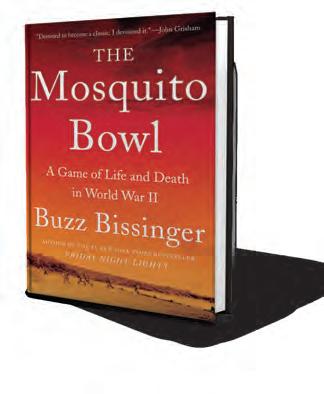
MIRRORPIX/GETTY IMAGES
WINTER 2023 71 (continued on page 73) WW2P-230100-REVIEWS.indd 71 10/3/22 7:33 PM
REVIEWS BOOKS
FANTASTIC FOUR
Generals George S. Patton (at left) and George C. Marshall weren’t good friends, but their lives —and legacies—were closely intertwined.

and trends. In Team America he follows the balls as they collide and rebound: Patton and MacArthur standing under shellfire during World War I; Eisenhower and Patton serving in the interwar U.S. Army Tank Corps; MacArthur and Eisenhower in the Philip pines during the 1930s; Marshall and Eisen hower planning Hitler’s downfall in 1942; MacArthur and Marshall as colleagues during the Korean War.
TEAM AMERICA Patton, MacArthur, Marshall, Eisenhower, and the World They Forged
By Robert L. O’Connell. 576 pp. Harper, 2022. $29.99.
FOR AMERICAN AUDIENCES, World War II histories generally fall into three categories: what America did, what America and Britain did, and what everyone else did. Not surpris ingly, Robert L. O’Connell’s Team America falls squarely into the first category. Taking the four most famous American military names of World War II, the author and historian traces the “braided and fated” careers of Generals George C. Marshall, Douglas MacArthur, Dwight D. Eisenhower, and George S. Patton from childhood through their lasting Cold War legacies. While each man is the subject of multiple individual biog raphies, O’Connell’s book focuses on the four some’s collective impact and inflection points throughout the 20th century that turned on the quartet.

Apart from Eisenhower and Patton (“a bro mance that ended badly,” O’Connell quips— Ike would eventually fire his old Tank Corps comrade during the Allied occupation of Germany), the four generals were not close friends. Their careers intersected sporadi cally as they were assigned to far-flung fronts, like billiard balls cracking against each other before rolling toward different pockets. O’Connell, whose varied military-themed articles and books span the timeline of Plato to NATO, is well-placed to observe patterns
One quality separating Team America from its contemporaries is its prose, which is built for entertainment, not nuance. Of MacAr thur’s personal relationships, for instance, O’Connell writes, “Doug loved Doug more than anybody.” On Patton at the Battle of the Bulge: “He gloried in the gore; it was by this time his natural element, like mud to a pig.” Of Eisenhower, O’Connell muses, “Getting to know him is a bit like quantum physics—just when you think you have a good grip on the man, he turns into something else. Is this he? Or is he that? Or both?” Marshall, he con cludes, “was even more mysterious. His mask, fashioned to be at once ferocious and imper turbable, almost totally hid the human spirit beneath.” O’Connell leans into this sportsand-pop-culture writing style, noting wryly that it is no accident the book’s title, Team America, shares its name with a satirical 2004 puppet film about American action heroes battling North Korea’s Kim Jong-Il.
Team America ’s assessments are eloquent, often amusing, and unabashedly lack qualifi cations over which other historians obsess. For instance, O’Connell writes of Patton, “Within his lethal sphere it’s hard to imagine a better combat leader,” though he skips the cavalryman’s struggles with set-piece battles like 1944’s Battle of Metz in France (“my first bloody nose,” Patton admitted to General Jimmy Doolittle) and Eisenhower’s postwar assessment that the colorless Bradley was a better overall commander than Patton. But nuance is not the point; O’Connell’s broad brush makes for a more colorful group por trait than a fine-tipped precision instrument would produce.
That said, the glib statements sprinkled throughout Team America conceal a sober analysis of its four protagonists. O’Connell’s
WORLD WAR II72 LIBRARY OF CONGRESS/CORBIS/VCG VIA GETTY IMAGES UNIVERSAL HISTORY ARCHIVE/GETTY IMAGES
WW2P-230100-REVIEWS.indd 72 10/4/22 3:42 PM
research is generally solid, and he often digs below the surface to reveal exhausting intel ligence and logistical work that enabled his heroes to bat triples and home runs. Of MacArthur’s 1944 campaigns, for instance, he observes, “MacArthur’s subsequent, terpsichorean progress along the top side of New Guinea would in large part be choreo graphed by [decrypted Japanese intercepts code-named] ULTRA. The oracle occasion ally went silent, but for the most part, Mac’s brilliant leaps to ‘hit ’ em where they ain’t’ and miraculous interpretations of Japanese reinforcements came courtesy of the dance master in Washington.” Observations like this suggest more analytical depth than O’Connell’s wit likes to admit. His merger of honest understanding and sassy prose pro duces a history book that reads like a beach book. —Jonathan W. Jordan is the bestselling author of books including Brothers, Rivals, Victors: Eisenhower, Patton, Bradley and the Partnership that Drove the Allied Conquest in Europe (2011).
(Mosquito Bowl, continued from page 71)
and Simon Bolivar Buckner. The enlisted men were Murphy, Maliszewski, and But kovic. As for Black Marines, their treatment at the hands of military superiors and peers was no better overseas in the Pacific than it was stateside.
Jumping across time and continents, Biss inger also offers a candid look inside South Carolina’s legendary Parris Island Marine boot camp, where drill instructors took raw recruits and, through psychological and physical intimidation, turned each one into a cog in a killing machine. Those who man aged to keep their humanity alive, like 2nd Lieutenant John McLaughry, a blocking back from Brown University, would go on to become leaders. McLaughry’s enlisted men knew he had their interests at heart. And he didn’t shy away from tough situations, either on or off the field. Bissinger’s moveby-move report of a three-day patrol led by McLaughry on Bougainville in January 1945 is like reading a nightmare: days spent hacking through impenetrable jungle on an eight-mile path designed to skirt enemy emplacements and gather intelligence; nights hiding in the same jungle, remaining silent, standing watch in the pitch-black dark, hoping to see another dawn.
Bissinger’s chronicling of their deeds is a fitting tribute to them all. — Mark Oristano is an author, journalist, and former National Football League broadcaster who lives in Dallas, Texas.
Passengers of the ocean liner MS St. Louis, stranded and adrift in 1939.

NOWHERE TO LAND
THE U.S. AND THE HOLOCAUST
Directed by Ken Burns, Lynn Novick, and Sarah Botstein. Florentine Films, 2022. Streaming and available for purchase ($39.99-$49.99) on DVD or Blu-Ray at shop.pbs.org.
Documentary filmmaker Ken Burns cemented his cultural legacy with history series such as The Civil War (1990) and Country Music (2019), but his latest project, The U.S. and the Holocaust, is the one he’s publicly deemed the most important of his career. First broadcast on PBS in September 2022, the three-part, six-hour production provides an unstinting look at 20th-century American immigration policies and attitudes, revealing how anti-Semitism, xenophobia, and isolationism worked in tandem to keep millions of persecuted Europeans out of the United States and trapped inside Hitler’s widening empire. Could we as a nation have done more to protect Europe’s Jewish population, or have even helped prevent the Holocaust? Burns doesn’t preach, nor must he. Stories shared by historians and survivors like that of the MS St. Louis (pictured at top), the refugee-packed German ocean liner that lost 254 of 937 passengers to genocide after being turned away from Cuba, the U.S., and Canada in 1939, are damning enough.
REVIEWS KIDS’ BOOKS
Bearing Witness
BROTHERS IN ARMS: A True World War II Story of Wojtek the Bear and the Soldiers Who Loved Him
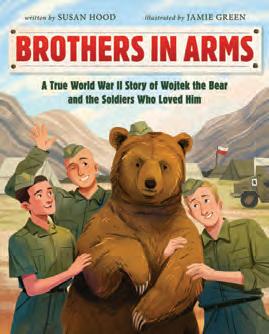
Written by Susan Hood; illustrated by Jamie Green. 48 pp. HarperCollins, 2022. $18.99. Ages 4-8.
One of World War II’s most fearsome “fighters” was also its furriest. Wojtek, an orphaned bear cub adopted in 1942 by Polish II Corps members, served as the group’s de facto pet and mascot. Officially registered as a soldier for food and travel allowances—his rank was that of private—Wojtek became a legend in Europe. His story is one for the ages, and for children as well in this charming and well-researched picture book by illustrator Jamie Green and author Susan Hood.
WINTER 2023 73 LIBRARY OF CONGRESS/CORBIS/VCG VIA GETTY IMAGES UNIVERSAL HISTORY ARCHIVE/GETTY IMAGES
REVIEWS TELEVISION
WW2P-230100-REVIEWS.indd 73 10/6/22 10:37 AM
REVIEWS GAMES
RETURN TO THE DESERT
THE AFRICAN CAMPAIGN: DESIGNER SIGNATURE 2ND EDITION
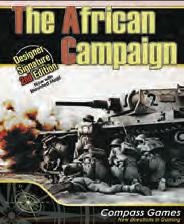
Compass Games. $65.
THE BASICS The African Campaign is a solo or two-person strategy game that recreates combat in North Africa between December 1940-1942. Players command British and Axis forces on the divisional and brigade levels, participating in action ranging from 1940’s Operation Compass against Marshal Ro dolfo Graziani’s Italian troops to clashes against German field marshal Erwin Rommel. If this premise sounds familiar, it’s be cause The African Campaign first debuted in 1973; last updated five years ago, a revamped 2022 edition of the well-known game features new components and a mounted map.
THE OBJECTIVE The British need to either capture the Libyan city of Tripoli or to destroy all Axis forces in North Africa. The Axis powers need to reach Egypt and drive out the British.
HISTORICAL ACCURACY Players command the very same units that took part in the fighting in North Africa, and reinforce ments appear on a schedule reflecting their arrival during the war. The game also accurately recreates obstacles faced by commanders such as terrain challenges and supply needs.
THE GOOD, THE BAD, AND THE UGLY The African Campaign boils the complexities of World War II’s operational warfare down into an easily understood game system. Its playing com ponents—especially the map, which both illustrates the battle field and provides handy tips for gameplay—are gorgeous. The game’s mechanics, however, offer little new from the 1973 or 2017 editions aside from nicer counters and better map. Players might also find the game to be repetitive since, just like in the historic North African campaign, there isn’t enough maneuver space or units to yield a variety of strategic options.
PLAYABILITY The African Campaign is easy for beginners; gaming veterans only need to skim the rules.

THE BOTTOM LINE All World War II board-gamers should have a North African campaign-themed game in their collection, and despite its limitations, The African Campaign is a good one to own. It’s fun for old hands, good for beginners, and can be played in a single evening. —Chris Ketcherside, a retired Ma rine, is currently completing his PhD in American history.
BERLIN
Life and Death in the City at the Center of the World
By Sinclair McKay.
368 pp. St. Martin’s, 2022. $29.99.
Is there any other place quite like Berlin?
British journalist Sinclair McKay traces the city’s history through two world wars and multiple social upheavals, capturing the unique strength and spunk of its inhabitants who persevered through the city’s fall in 1945.

BLOOD AND RUINS
The Last Imperial War, 1931-1945
By Richard Overy.
1040 pp. Viking, 2022. $42.
World War II is always said to have begun in Poland in 1939. British historian Richard Overy revises the timeline, making an extensively researched case that the conflict originated in 1931 Manchuria as Japan--followed by like-minded Italy and Germany--sought to expand its imperial reach across the globe.

HITLER’S GIRL
The British Aristocracy and the Third Reich on the Eve of WWII
By Lauren Young.
240 pp. Harper, 2022. $29.99.
Many members of England’s aristocratic set admired Hitler. Yale lecturer Lauren Young uses expanded and declassified archival documents to explore their pro-fascist leanings, arguing that this support posed a real threat to democ racy in the nation’s lead-up to war.

WORLD WAR II RATING H H H H H
BOOK BRIEFS WORLD WAR II74 WW2P-230100-REVIEWS.indd 74 10/4/22 3:43 PM











Get Your FREE “Avenge Pearl Harbor” Coin A Dramatic Tribute to the American War Effort Get your “Avenge Pearl Harbor” coin FREE – send just $2.95 for shipping and guaranteed delivery. Now you can own a coin enhanced to commemorate a time when every American pitched in to do their part. It’s a $9.99 value – absolutely FREE. Just send $2.95 for shipping and guaranteed delivery. Order today and you’ll also receive special collector’s information and other interesting coins on approval. Strict limit of one free coin. Pearl Harbor Half Dollar ❏ Yes! Send me the FREE “Avenge Pearl Harbor” coin. Enclosed is $2.95 for shipping and guaranteed delivery. Satisfaction guaranteed. Strict limit of one coin. Quick order at MysticAd.com/IT106 Name ____________________________________________ Address __________________________________________ City/State/Zip _____________________________________ ❏ Check or money order ❏ Visa ❏ MasterCard ❏ AmExpress ❏ Discover Exp. Date ___/___ Please send payment to: Mystic, Dept. IT106, 9700 Mill St., Camden, NY 13316-9111 NY State residents add sales tax. ✔ Send just $2.95 for shipping and guaranteed delivery. WW2-221108-006 Mystic Stamp CLIPPABLE.indd 1 10/1/22 12:56 PM
BATTLE FILMS
BY MARK GRIMSLEY
THE ESSENCE OF HUMANITY?
WORLD WAR II ended in Europe on May 8, 1945. But for most of the continent, including its millions of displaced persons and those trying to rebuild their lives in ruined cities, it would be years before peace returned. Released in 1949, The Third Man takes place in a postwar Vienna ravaged by Allied bombing raids that destroyed 20 percent of the city and left 270,000 residents homeless. (Director
Filmed in postwar Vienna, The Third Man (1949) unflinchingly captures the city’s ruin while conveying an unsettling truth about war.
Carol Reed insisted that the film be shot on location, and viewers can see for themselves the hills of rubble.) Like Berlin, the city is occupied by four Allied powers: the Ameri cans, British, Soviets, and French. And with chronic shortages of everything from food to medicine, it’s the heyday of the black market, in which everyone seems to participate a little—and some a lot.
Into the city arrives Holly Martins (actor Joseph Cotten), a hack American novelist who has received an invitation from an old college chum, Harry Lime (Orson Welles), to come work with him in Vienna. (The nature of the work is never made clear.) Complications arise when Holly learns that his friend Harry is dead, killed in a recent traffic accident. Adding to his troubles is British military policeman Major Calloway (Trevor Howard), who curtly informs Holly that death was “the best thing that ever happened” to Harry, and that it was a fate befitting a black marketeer who was also a murderer. Outraged, Holly decides to clear Harry’s name and destroy Calloway’s reputation.
Everyone discourages Holly’s efforts to learn more about Harry’s death—especially Harry’s friends in Vienna, who provide accounts that don’t quite jibe and also omit a key detail that Holly soon learns from Har ry’s onetime porter: that in addition to the two men these friends say carried off Harry’s body, there was also “a third man” involved. The porter is mysteriously murdered after this reveal.
The film is nearly complete before we learn the identity of the third man (and consider reading no further until you’ve seen the film yourself, which among many critics is consid ered to be one of the best ever made). After Calloway decides to exhume Harry’s coffin to verify his “traffic accident” death, the body turns out to be that of a missing medical orderly, not Harry Lime. In fact, Harry him self killed the man lying in the coffin and is alive and well, evading authorities in the city’s Soviet sector.
By this time Holly knows why Major Callo way considers death the best thing that ever “happened” to Harry. Harry has made a for tune selling penicillin on the black market,

WORLD WAR II76 BFA/ALAMY
WW2P-230100-BATTLEFILMS.indd 76 10/3/22 1:58 PM
diluting it so that it is worse than use less, and is thereby responsible for the demise of countless hospital patients.
“Men with gangrened legs, women in childbirth,” Major Calloway informs Holly right before the film’s big twist. “And there were children, too. They used some of this diluted penicillin against meningitis. The lucky chil dren died. The unlucky ones went off their heads…. That was the racket Harry Lime organized.”
In one of the movie’s best-known scenes, Holly and Harry meet in a gondola of the Riesenrad, the famous Ferris wheel at the entrance to Vien na’s Prater amusement park. Harry is self-assured, silky, and unrepentant. Gesturing toward the pedestrians far below, he asks Holly, “Would you really feel any pity if one of those dots stopped moving forever? If I offered you 20,000 pounds for every dot that stopped, would you really, old man, tell me to keep my money, or would you calculate how many dots you could afford to spare?”
Given that the movie’s audience has already viewed laborers hard at work atop the city’s ubiquitous mounds of rubble, it is not hard to rec ognize that not long before, those same “dots” were the targets of Allied bombers. “Nobody thinks in terms of human beings,” Harry continues, making substantially the same point. “Governments don’t. Why should we? They talk about the people and the proletariat; I talk about the suckers and the mugs. It’s the same thing.”

But is it? We the audience don’t want to think so. We don’t want to share Harry’s chilling cynicism. Holly doesn’t share it, and Calloway decid edly does not as well. The Third Man ’s genius, however, is that it does not entirely let us off the hook. It doesn’t ask us to sympathize with Harry, though Holly cannot escape a sense of sorrow once his wayward friend receives his just deserts at the film’s end. But it conveys a sense that Harry isn’t entirely wrong about the world we inhabit. The wickedness of war may be the essence of humanity. H
STATEMENT OF OWNERSHIP, MANAGEMENT AND CIRCULATION (required by Act of August 12, 1970: Section 3685, Title 39, United States Code). 1. World War II 2. (ISSN: 0898-4204) 3. Filing date: 10/1/22. 4. Issue frequency: Quarter ly. 5. Number of issues published annually: 4. 6. The annual subscription price is $39.95. 7. Complete mailing address of known office of publication: HistoryNet, 901 N Glebe Rd, 5th Floor, Arlington, VA 22203. 8. Complete mailing address of headquarters or general business office of publisher: HistoryNet, 901 N Glebe Rd, 5th Floor, Arlington, VA 22203. 9. Full names and complete mailing addresses of publisher, editor, and managing editor. Publisher, Michael A. Reinstein, HistoryNet, 901 N Glebe Rd, 5th Floor, Arlington, VA 22203, Editor, Karen Jensen, HistoryNet, 901 N Glebe Rd, 5th Floor, Arlington, VA 22203 , Editor in Chief, Dana Shoaf, HistoryNet, 901 N Glebe Rd, 5th Floor, Arlington, VA 22203. 10. Owner: HistoryNet; 901 N Glebe Rd, 5th Floor, Arlington, VA 22203. 11. Known bondholders, mortgages, and other security holders owning or holding 1 percent of more of total amount of bonds, mortgages or other securities: None. 12. Tax status: Has Not Changed During Preceding 12 Months. 13. Publisher title: World War II. 14. Issue date for circulation data below: Autumn 2022. 15. The extent and nature of circulation: A. Total number of copies printed (Net press run). Average number of copies each issue during preceding 12 months: 61,593. Actual number of copies of single issue published nearest to filing date: 58,950. B. Paid circulation. 1. Mailed outside-county paid subscriptions. Average number of copies each issue during the preceding 12 months: 37,653. Actual number of copies of single issue published nearest to filing date: 34,356. 2. Mailed in-county paid subscriptions. Average number of copies each issue during the preceding 12 months: 0. Actual number of copies of single issue published nearest to filing date: 0. 3. Sales through dealers and carriers, street vendors and counter sales. Average number of copies each issue during the preceding 12 months: 5,447. Actual number of copies of single issue published nearest to filing date: 5,467. 4. Paid distribution through other classes mailed through the USPS. Average number of copies each issue during the preceding 12 months: 0. Actual number of copies of single issue published nearest to filing date: 0. C. Total paid distribution. Average number of copies each issue during preceding 12 months: 43,101. Actual number of copies of single issue published nearest to filing date; 39,823. D. Free or nominal rate distribution (by mail and outside mail). 1. Free or nominal Outside-County. Average number of copies each issue during the preceding 12 months: 0. Number of copies of single issue published nearest to filing date: 0. 2. Free or nominal rate in-county copies. Average number of copies each issue during the preceding 12 months: 0. Number of copies of single issue published nearest to filing date: 0. 3. Free or nominal rate copies mailed at other Classes through the USPS. Average number of copies each issue dur ing preceding 12 months: 0. Number of copies of single issue published nearest to filing date: 0. 4. Free or nominal rate distribution outside the mail. Average number of copies each issue during preceding 12 months: 587. Number of copies of single issue published nearest to filing date: 419. E. Total free or nominal rate distribution. Average number of copies each issue during preceding 12 months: 587. Actual number of copies of single issue published nearest to filing date: 419. F. Total free distribution (sum of 15c and 15e). Average number of copies each issue during preceding 12 months: 43,687. Actual number of copies of single issue published nearest to filing date: 40,242. G. Copies not Distributed. Average number of copies each issue during preceding 12 months: 17,906. Actual number of copies of single issue published nearest to filing date: 18,708. H. Total (sum of 15f and 15g). Average number of copies each issue during preceding 12 months: 61,593. Actual number of copies of single issue published nearest to filing: 58,950. I. Percent paid. Average percent of copies paid for the preceding 12 months: 98.7% Actual percent of copies paid for the preceding 12 months: 99.0% 16. Electronic Copy Circulation: A. Paid Electronic Copies. Average number of copies each issue during preceding 12 months: 0. Actual number of copies of single issue published nearest to filing date: 0. B. Total Paid Print Copies (Line 15c) + Paid Electronic Copies (Line 16a). Average number of copies each issue during preceding 12 months: 43,100. Actual number of copies of single issue published nearest to filing date: 39,823. C. Total Print Distribution (Line 15f) + Paid Electronic Copies (Line 16a). Aver age number of copies each issue during preceding 12 months: 43,687. Actual number of copies of single issue published nearest to filing date: 40,242. D. Percent Paid (Both Print & Electronic Copies) (16b

by 16c x 100). Average number of copies each issue during preceding 12 months: 98.7%. Actual number
of
nearest to filing
BFA/ALAMY
divided
of copies
single issue published
date: 99.0%. I certify that 50% of all distributed copies (electronic and print) are paid above nominal price: Yes. Report circulation on PS Form 3526-X worksheet 17. Publication of statement of ownership will be printed in the Winter 2022 issue of the publication. 18. Signature and title of editor, publisher, business manager, or owner: Kelly Facer, SVP, Revenue Operations. I certify that all information furnished on this form is true and complete. I understand that anyone who furnishes false or misleading information on this form or who omits material or information requested on the form may be subject to criminal sanction and civil actions. 27, 31, 36 or 40? HOW MANY TIMES HAS THE DESIGN OF THE U.S. FLAG CHANGED? For more, visit HISTORYNET.COM/ MAGAZINES/QUIZ ANSWER: 27. THE CURRENT DESIGN HAS BEEN IN PLACE SINCE 1960 WHEN THE FLAG WAS MODIFIED TO INCLUDE HAWAII, THE 50 th STATE. HOUSE_FLAGCHANGE-square-06.22.indd 40 6/16/22 WW2P-230100-BATTLEFILMS.indd 77 10/3/22 1:59 PM
You can’t always lie down in bed and sleep. Heartburn, cardiac problems, hip or back aches – and dozens of other ailments and worries. Those are the nights you’d give anything for a comfortable chair to sleep in: one that reclines to exactly the right degree, raises your feet and legs just where you want them, supports your head and shoulders properly, and operates at the touch of a button.







Our Perfect Sleep Chair® does all that and more. More than a chair or recliner, it’s designed to provide total comfort. Choose your preferred heat and massage settings, for hours of soothing relaxation. Reading or watching TV? Our chair’s recline technology allows you to pause the chair in an infinite number of settings. And best of all, it features a powerful lift mechanism that tilts the entire chair forward, making it easy to stand. You’ll love the other benefits, too. It helps with correct spinal alignment and promotes back pressure relief, to prevent back and muscle pain. The overstuffed, oversized biscuit style back and unique seat design will cradle you





in comfort. Generously filled, wide armrests provide enhanced arm support when sitting or reclining. It even has a battery backup in case of a power outage.









White glove delivery included in shipping charge. Professionals will deliver the chair to the exact spot in your home where you want it, unpack it, inspect it, test it, position it, and even carry the packaging away! You get your choice of Luxurious and Lasting Brisa, Genuine Italian Leather, stain and liquid repellent Duralux with the classic leather look, or plush MicroLux microfiber, all handcrafted in a variety of colors to fit any decor. Call now!







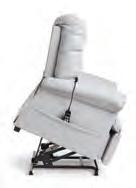





1-888-279-3404 Please mention code 601388 when ordering.
“To
you, it’s the perfect lift chair. To me, it’s the best sleep chair I’ve ever had.”
— J. Fitzgerald,
VA 46622Because each Perfect Sleep Chair is a made-to-order bedding product it cannot be returned, but if it arrives damaged or defective, at our option we will repair it or replace it. © 2022 Journey Health and Lifestyle. 3CHAIRS IN ONE: BUSINESS A+ enjoying life never gets old™mobility | sleep | comfort | safety SLEEP/RECLINE/LIFT Pictured is Luxurious & Lasting Brisa™. Ask about our 5 Comfort Zone chair. REMOTE-CONTROLLED EASILY SHIFTS FROM FLAT TO A STAND-ASSIST POSITION Now available in a variety of colors, fabrics and sizes. MicroLux™ Microfiber breathable & amazingly soft Long Lasting DuraLux™ Chocolate Blue Genuine Italian Leather classic beauty & style Chestnut Light GraySaddleChocolate WW2-221108-007 FirstStreet Journey Health Perfect Sleep Chair.indd 1 10/1/22 12:53 PM
THE VICTORS
Answer to the Autumn Challenge: As 83 of you correctly guessed, we removed the P-47’s under wing pylon, which carried bombs, auxiliary fuel tanks, or bazooka rockets. No, we didn’t adjust the markings on the wing or the soldiers’ leggings.
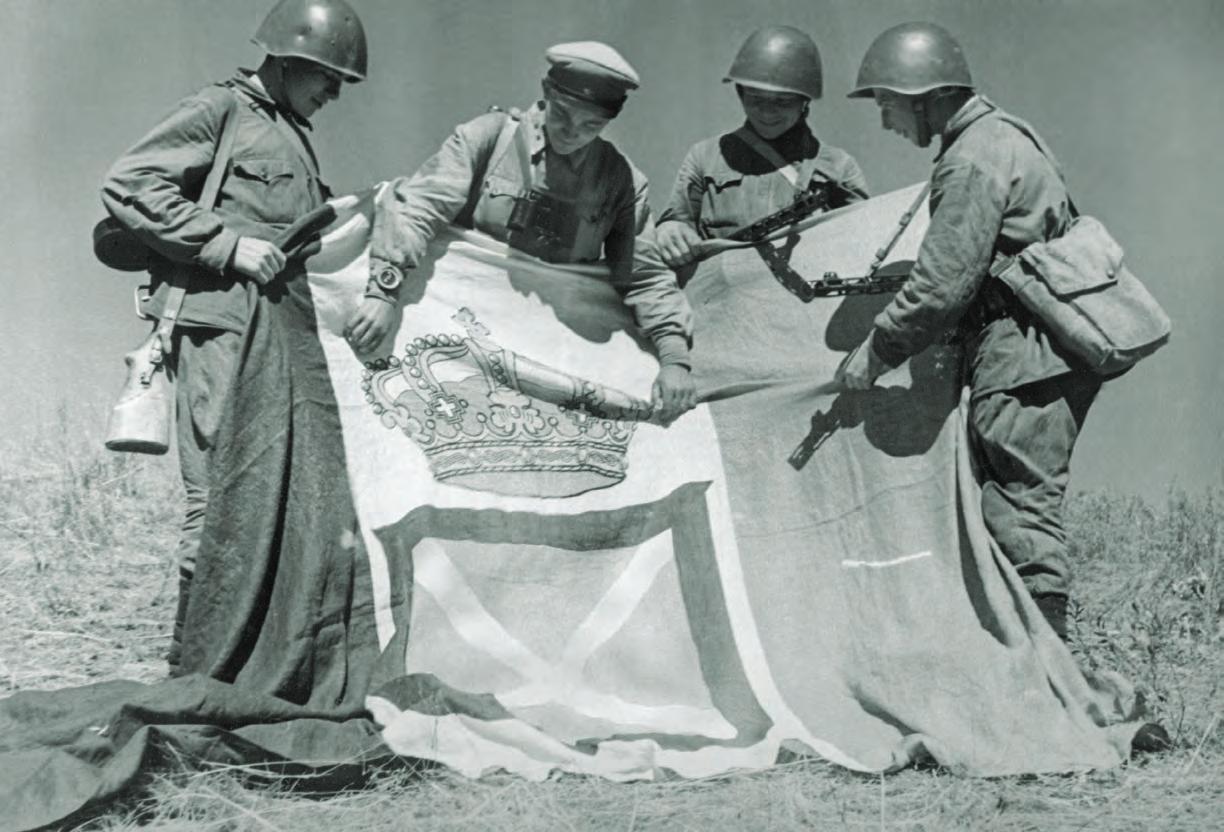


Congratulations to the winners: Paul Greigger, Kevin Ikenberry, and John Nachtigall
Please send your answer via email with your name and mailing address to: challenge@ historynet.com. Three winners, chosen at random from all correct entries submitted by December 16, 2022, will receive The Mosquito Bowl by Buzz Bissinger. The answer will appear in the next issue.
We
altered this 1942 photo of Soviet soldiers holding a captured Italian regiment standard to create one inaccuracy. What is it?
TO
TOP: KEYSTONE/STRINGER/GETTY IMAGES; PHOTO ILLUSTRATION BY BRIAN WALKER CHALLENGE
WINTER 2023 79 WW2P-230100-CHALLENGE-1.indd 79 9/26/22 5:08 PM
FIGHT FOR RIGHT
Civil rights pioneer Medgar Evers knew the world could be a better place. In part to escape the daily racial degradations he endured in his hometown of Decatur, Mississippi, in October 1943 Evers enlisted in the U.S. Army. He served with the segregated 325th Port Company and saw action in France, Belgium, and Germany, including a stint as a driver on the “Red Ball Express” that shuttled critical supplies to the front. After the war, inspired by a “kind of national soul searching” that he said in a 1959 speech began with World War II, Evers worked tirelessly for racial equality, becoming the NAACP’s first Mississippi field secretary and leading the effort to integrate the University of Mississippi. After his 1963 assassination at age 37, the veteran was buried with full military honors in Arlington National Cemetery.


JOHN STOREY/GETTY IMAGES; INSET: MICHAEL OCHS ARCHIVE/GETTY IMAGES
FAMILIAR FACE WORLD WAR II80 WW2P-230100-FFACE-EVERS.indd 38 10/6/22 7:19 AM
NORMANDY

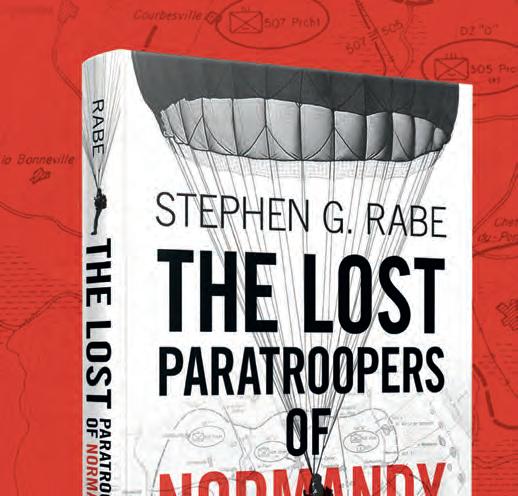


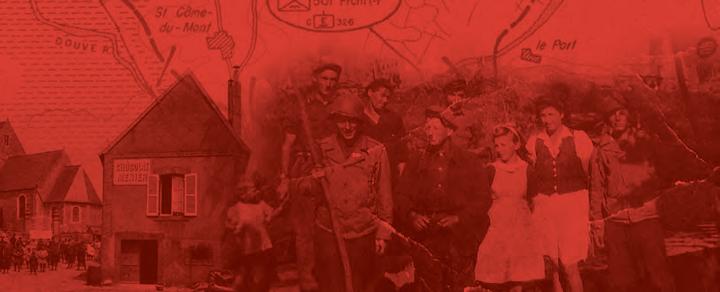

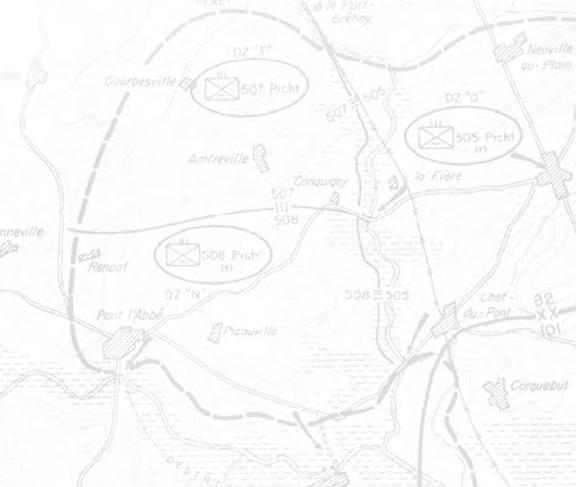

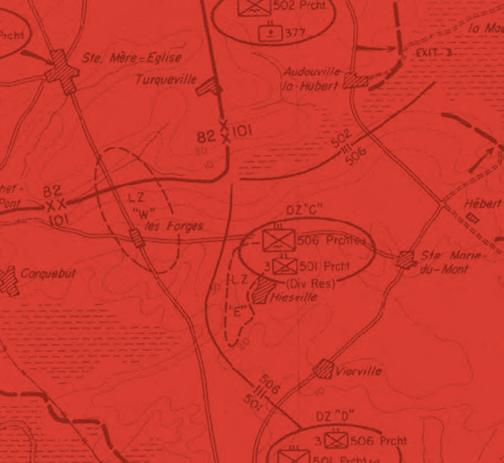
OF
A STORY OF RESISTANCE, COURAGE, AND SOLIDARITY IN A FRENCH VILLAGE THE LOST PARATROOPERS STEPHEN G. RABE “Stephen G. Rabe provides a fascinating and multi-layered military, diplomatic, and social history of US World War II paratroopers, French villagers, and the protection they gave each other in June 1944. In the process, he provides a fitting tribute to his father, who was one of those paratroopers.” MARK A. STOLER, author of Allies in War: Britain and America against the Axis Powers, 1940–1945 9781009206372 | $24.95 | Hardback | November 2022 cambridge.org/LostParatroopers 1190_LostParatroopers_ad.indd 1 08/09/2022 11:44WW2-221108-004 Cambridge University Press.indd 1 10/1/22 12:51 PM
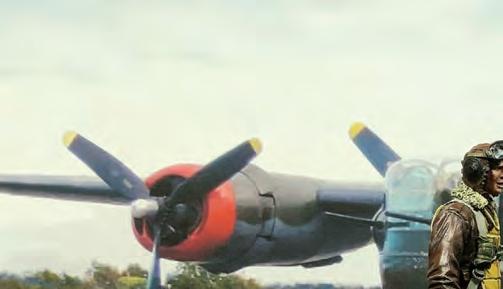

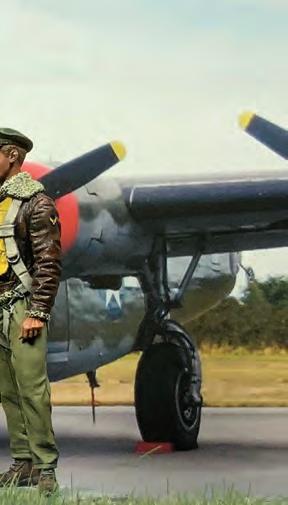

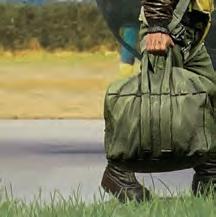






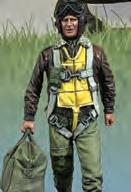

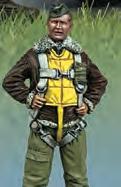
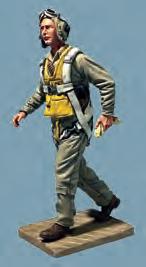











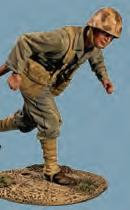































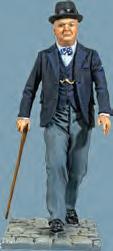











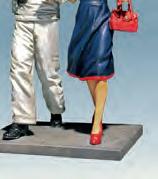



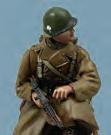





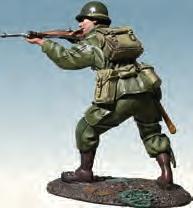






WBHN Vietnam WINTER 2022 ©2022 W.Britain Model Figures W.Britain, and are registered trademarks of the W.Britain Model Figures, Chillicothe, OH Follow us on Facebook: W-Britain-Toy-SoldierModel-Figure-Company Subscribe to us on YouTube: W.Britain Model Figures See our complete collection of 1/30 scale W.Britain historical metal figures at: Tel: U.S. 740-702-1803 • wbritain.com • Tel: U.K. (0)800 086 9123 Each one of our 1:30 scale metal figures is painstakingly researched for historical accuracy and detail. The originals are hand sculpted by our talented artists before being cast in metal and hand painted – making each figure a gem of hand-crafted history. Please visit wbritain.com to see all these figures and more from many other historical eras. matte finish Hand-Painted Pewter Figures 56/58 mm-1/30 Scale 10081 U.S. General Dwight D. Eisenhower, WWII $45.00 10076 U.S.A.A.F. Bombardier England, 1943-45 $45.00 10077 U.S.A.A.F. Navigator England, 1943-45 $45.0010088 George H.W. Bush U.S. Navy, 1944 $45.00 10068 John F. Kennedy U.S. Navy, 1945 $45.00 10078 U.S.A.A.F. Bomber Captain, England, 1943-45 $45.00 13035 U.S.N. Corpsman, 1944-45 $45.00 13036 U.S. Marine with SCR300 Radio 1944-45 $45.00 10059 Rosie the Riveter, 1941-45 $45.00 13030 U.S.M.C. Women’s Reserve, 1941-45 $45.00 13054 U.S. Marine in Dress Blues, Post WWII $45.00 13053 U.S. Sailor in Whites, 1941-45 $45.00 © W.Britain 51072 $7.50 B-24 Liberator of the Mighty 8th 8.5x5.5" backdrop card 10082 U.K. Prime Minister Winston Churchill, 1940-45 $45.00 10080 British Field Marshall Bernard Montgomery, 1944-45 $45.00 25124 101st Airborne in Greatcoat Kneeling with Thompson, $45.00 101st Airborne Standing Firing 25063 Waffen SS Advancing with MP 40 $45.00 25119 German Waffen SS in Italian Camo with PPSH 41 10083 German Generalfeldmarschall Erwin Rommel, 1944 $45.00 Shore Leave U.S.N. Sailor on Liberty withDate, 1942-45 $78.00 $45.00 Carbine $45.00 WBHN-WWII WINTER 2022 WorldWar II.indd 1 9/29/22 9:43 AM WW2-221108-002 Wbritain.indd 1 10/1/22 1:42 PM































































 John Devillier
John Devillier
 Paul Butterworth
Paul Butterworth










































































 British intelligence officer Rodger Winn (below) and his American counterpart Kenneth Knowles (left) raced to anticipate the Kriegsmarine’s next moves in the Atlantic—efforts that resulted in U-118 ’s sinking in June 1943.
British intelligence officer Rodger Winn (below) and his American counterpart Kenneth Knowles (left) raced to anticipate the Kriegsmarine’s next moves in the Atlantic—efforts that resulted in U-118 ’s sinking in June 1943.


































































































































































